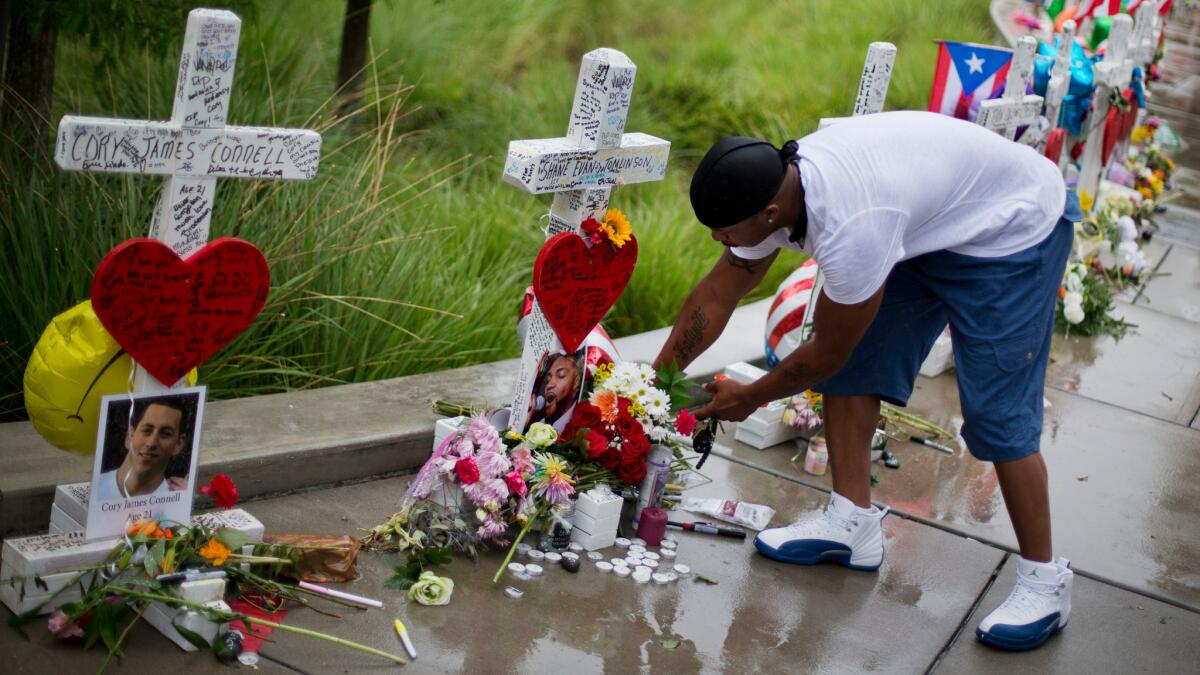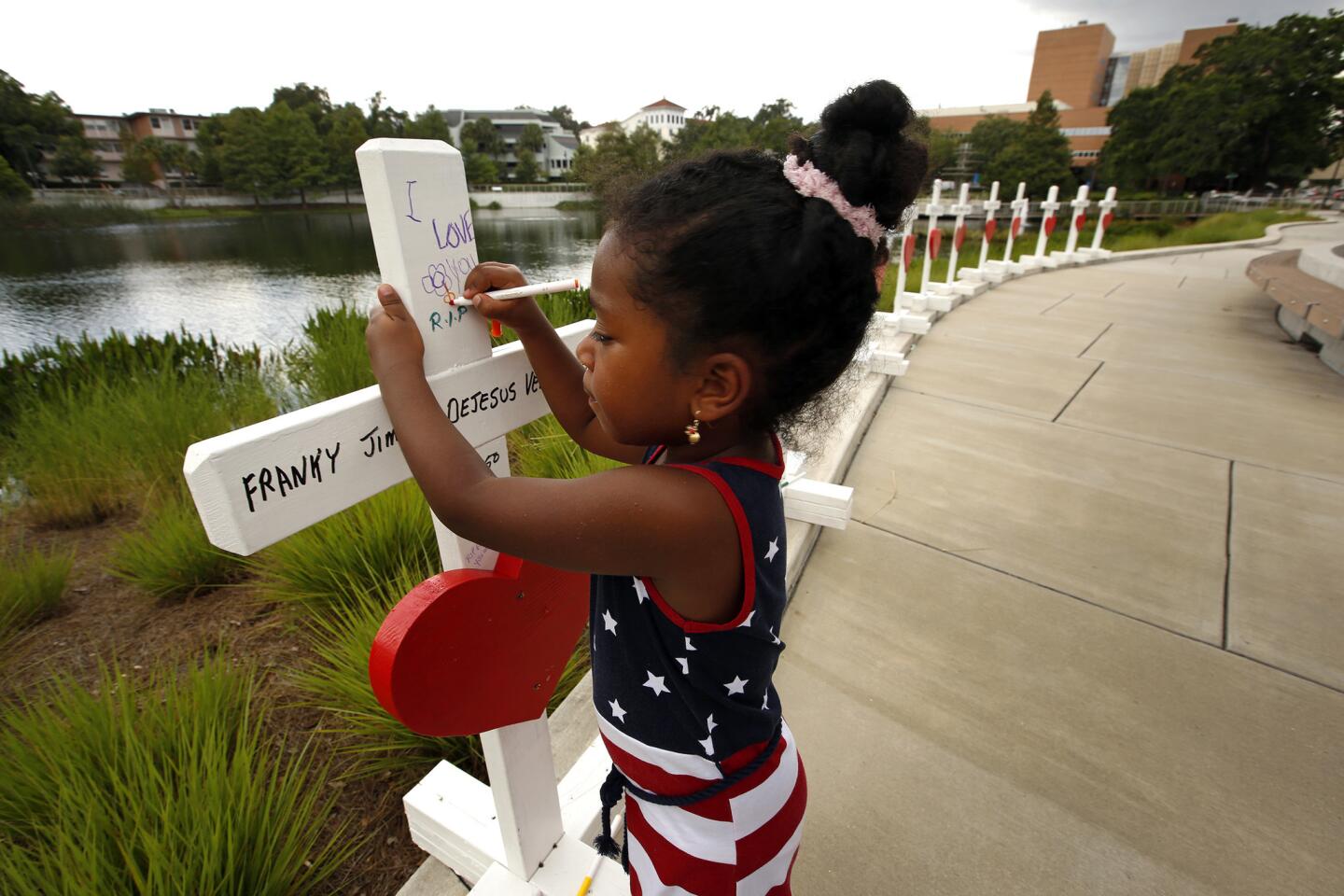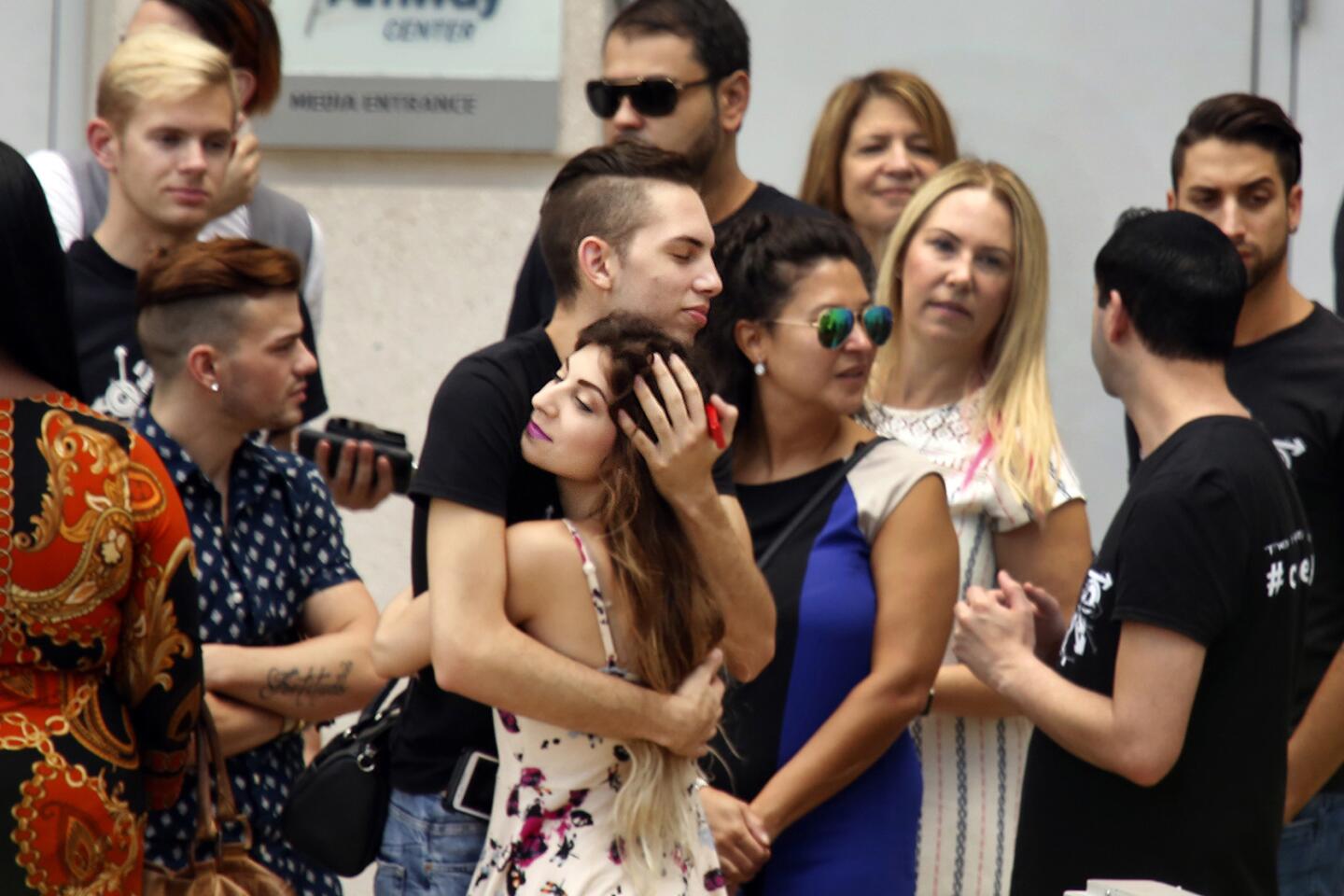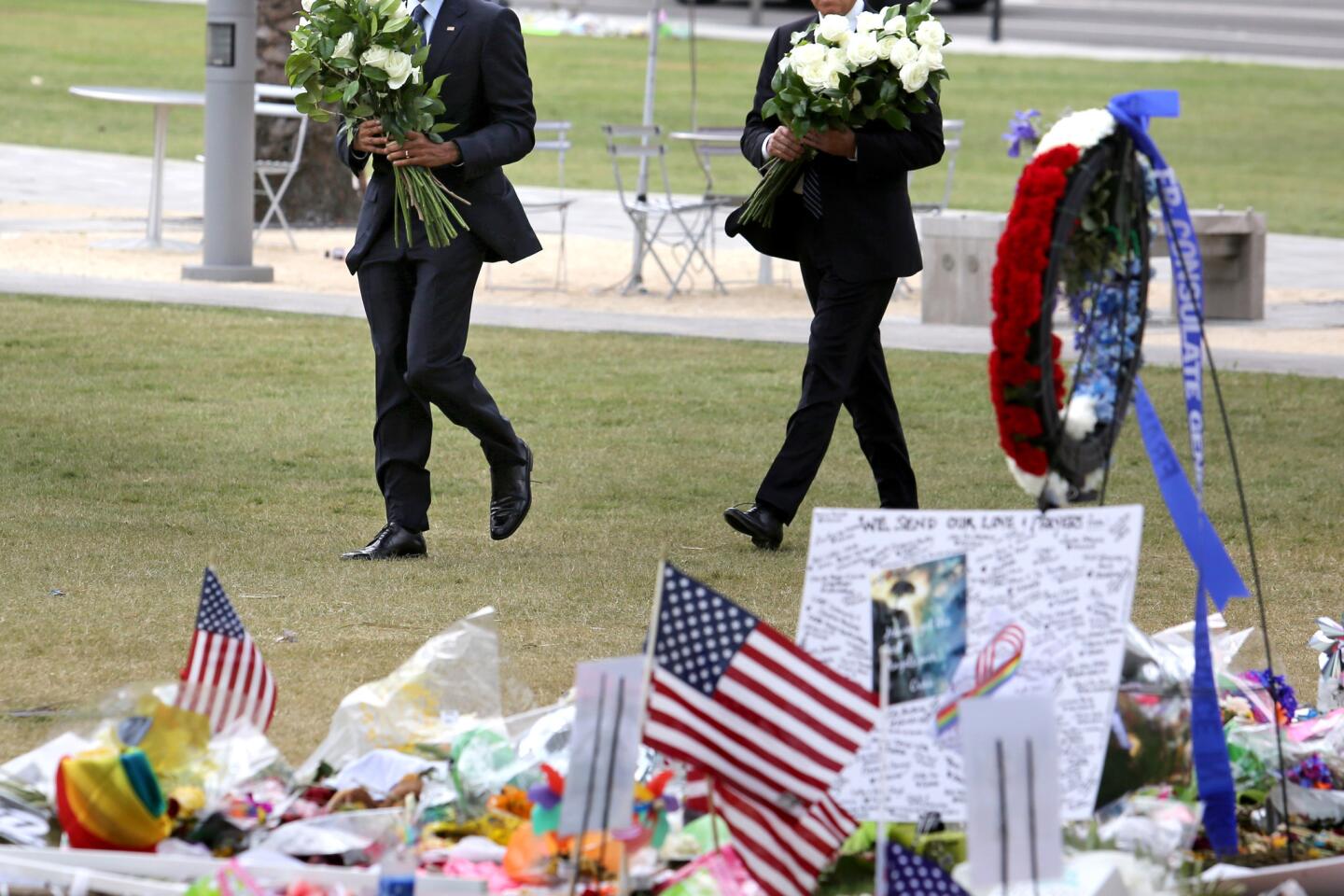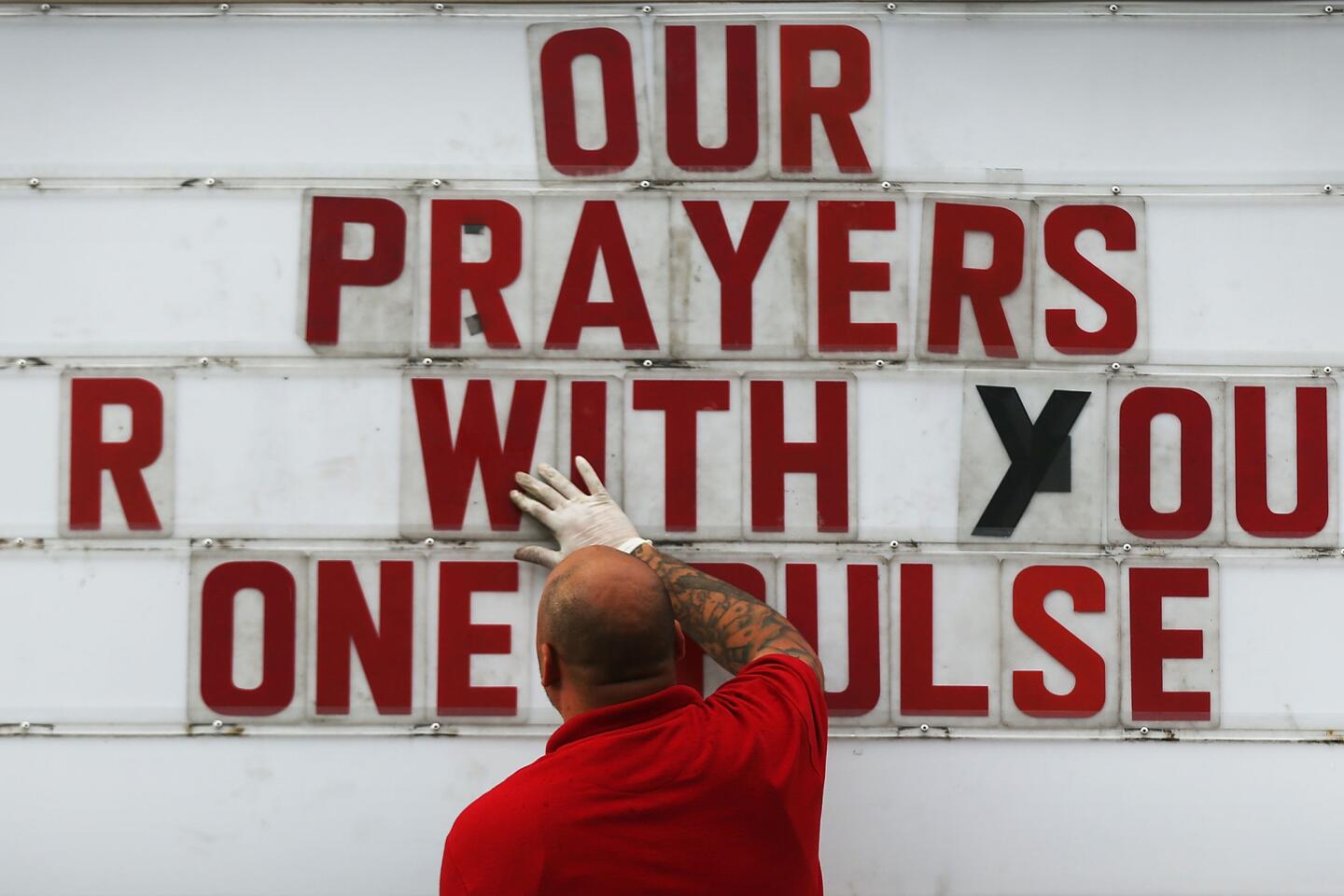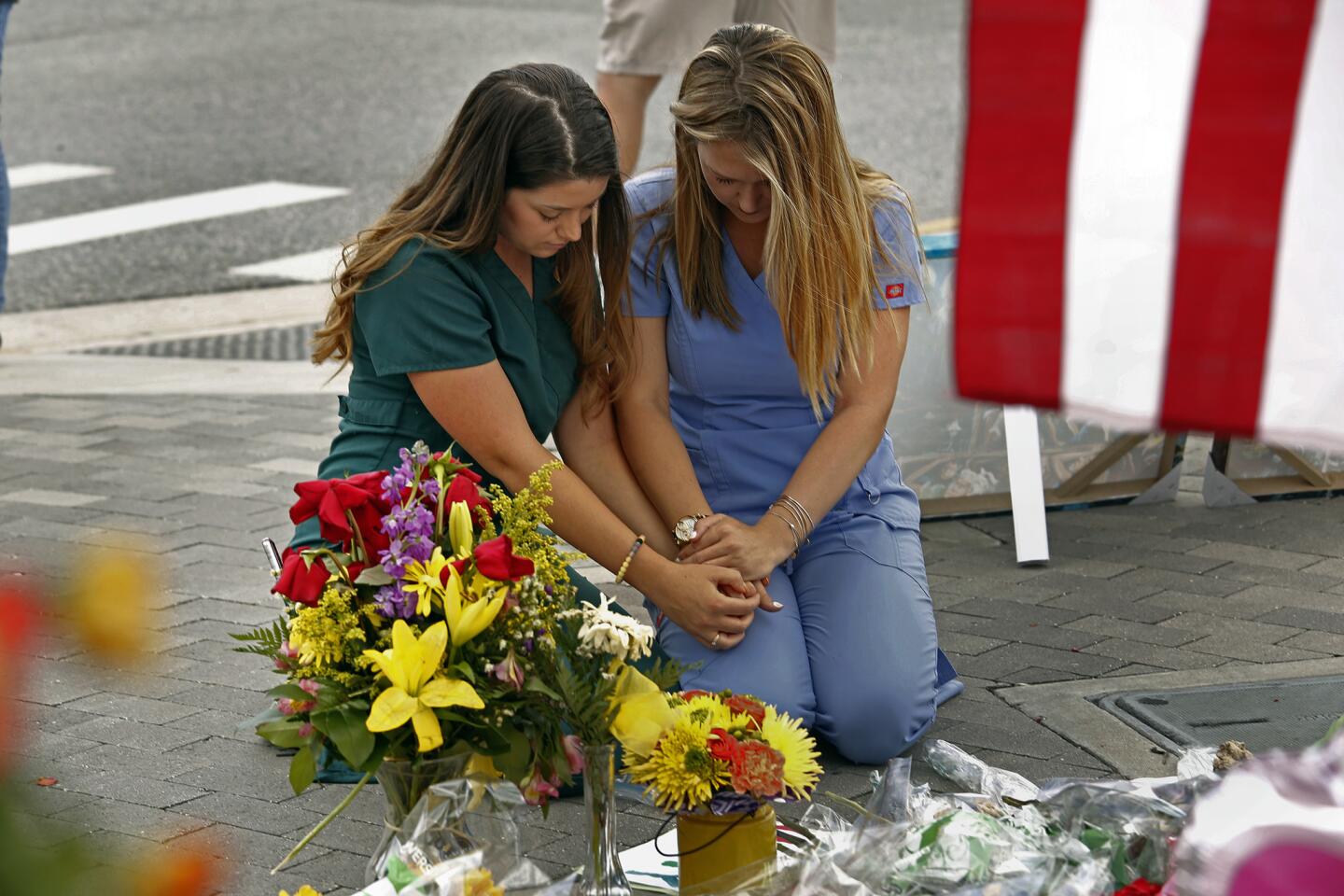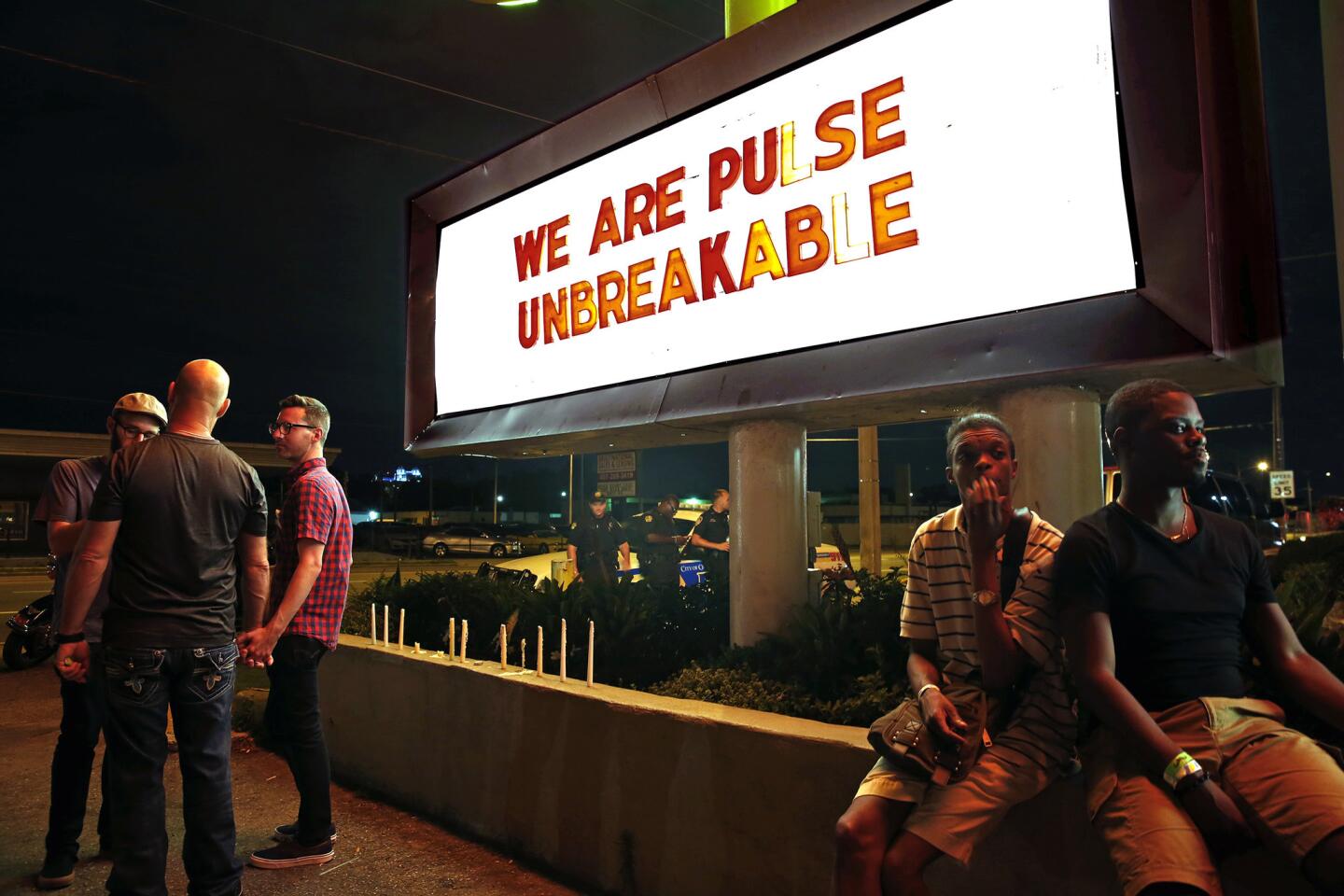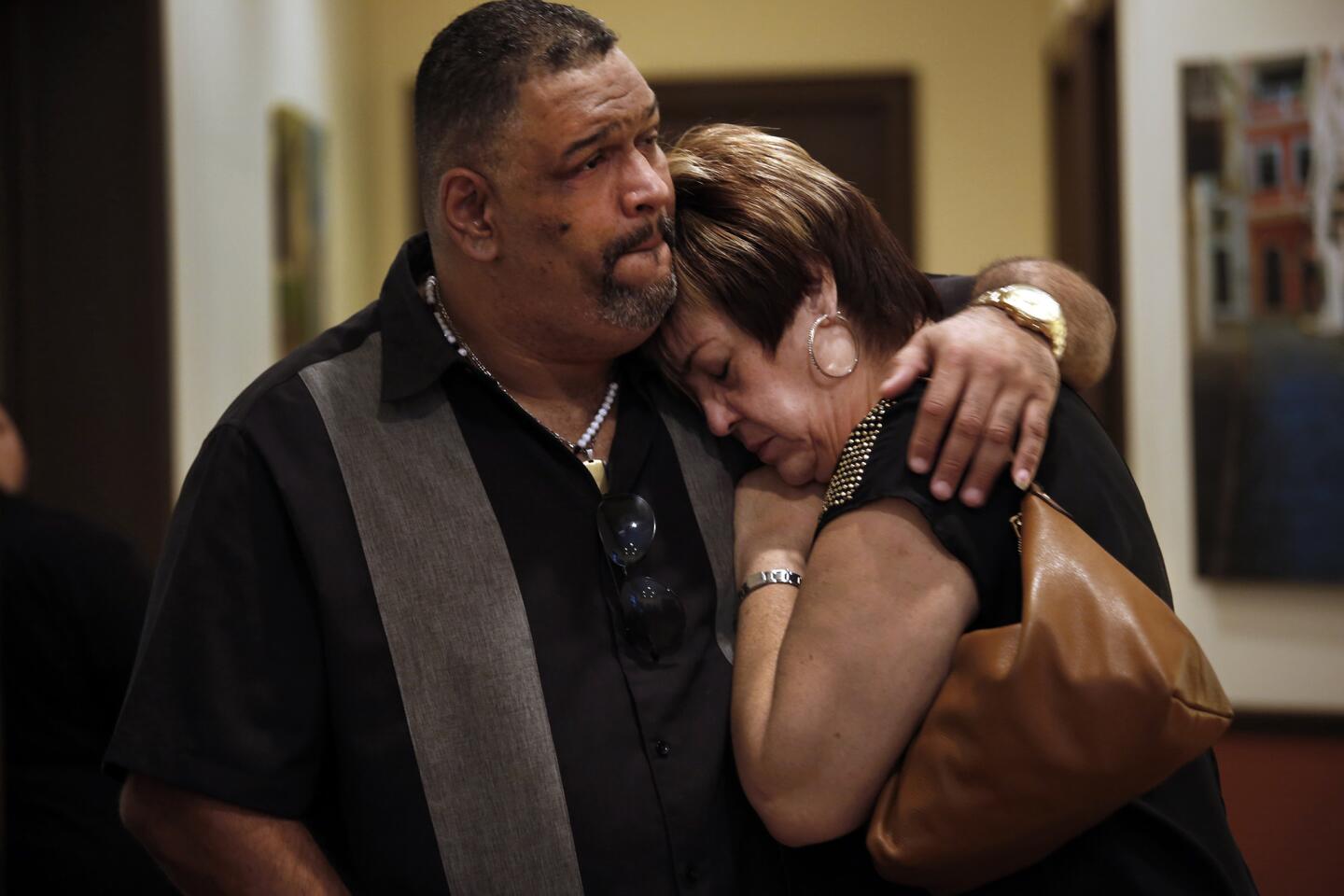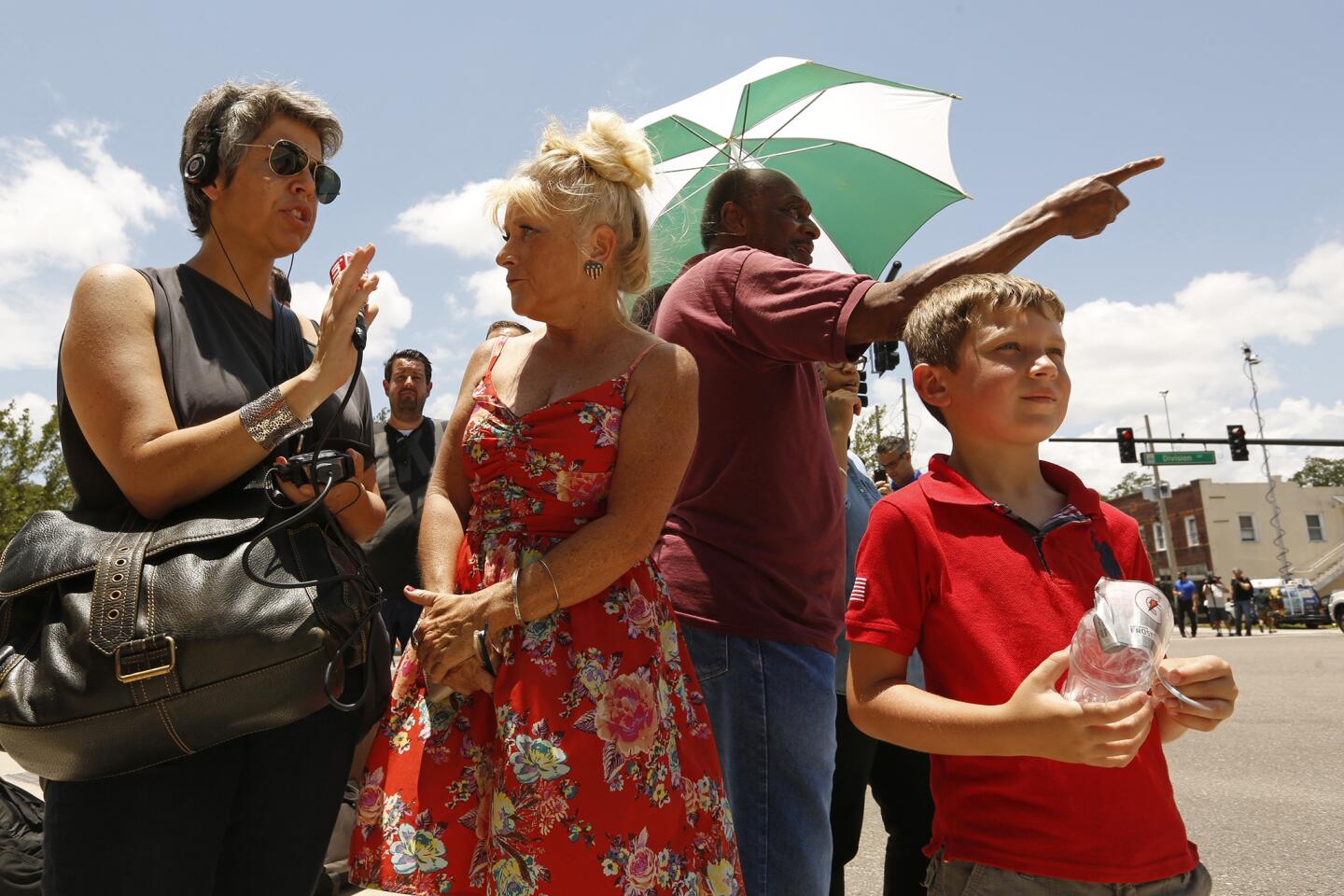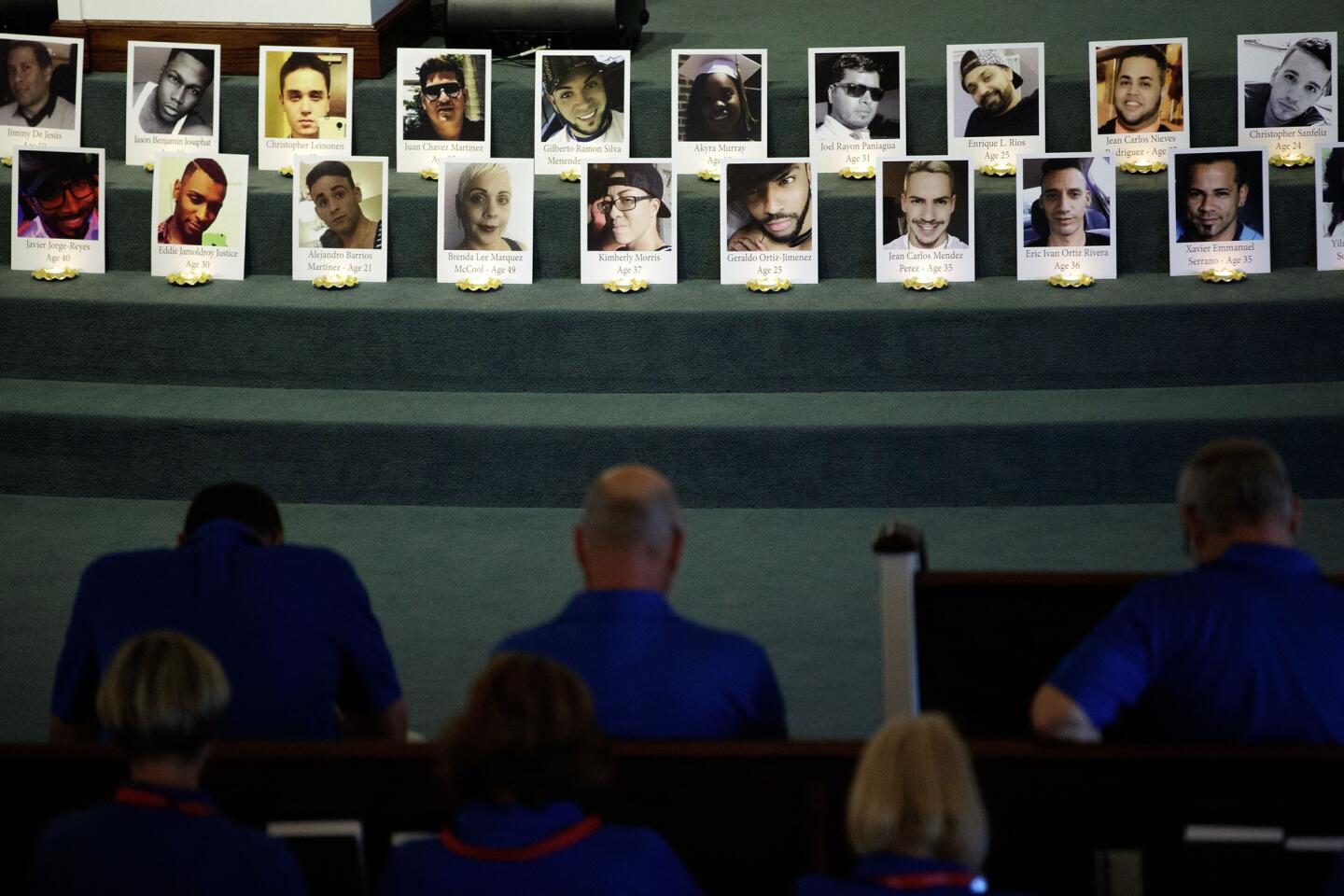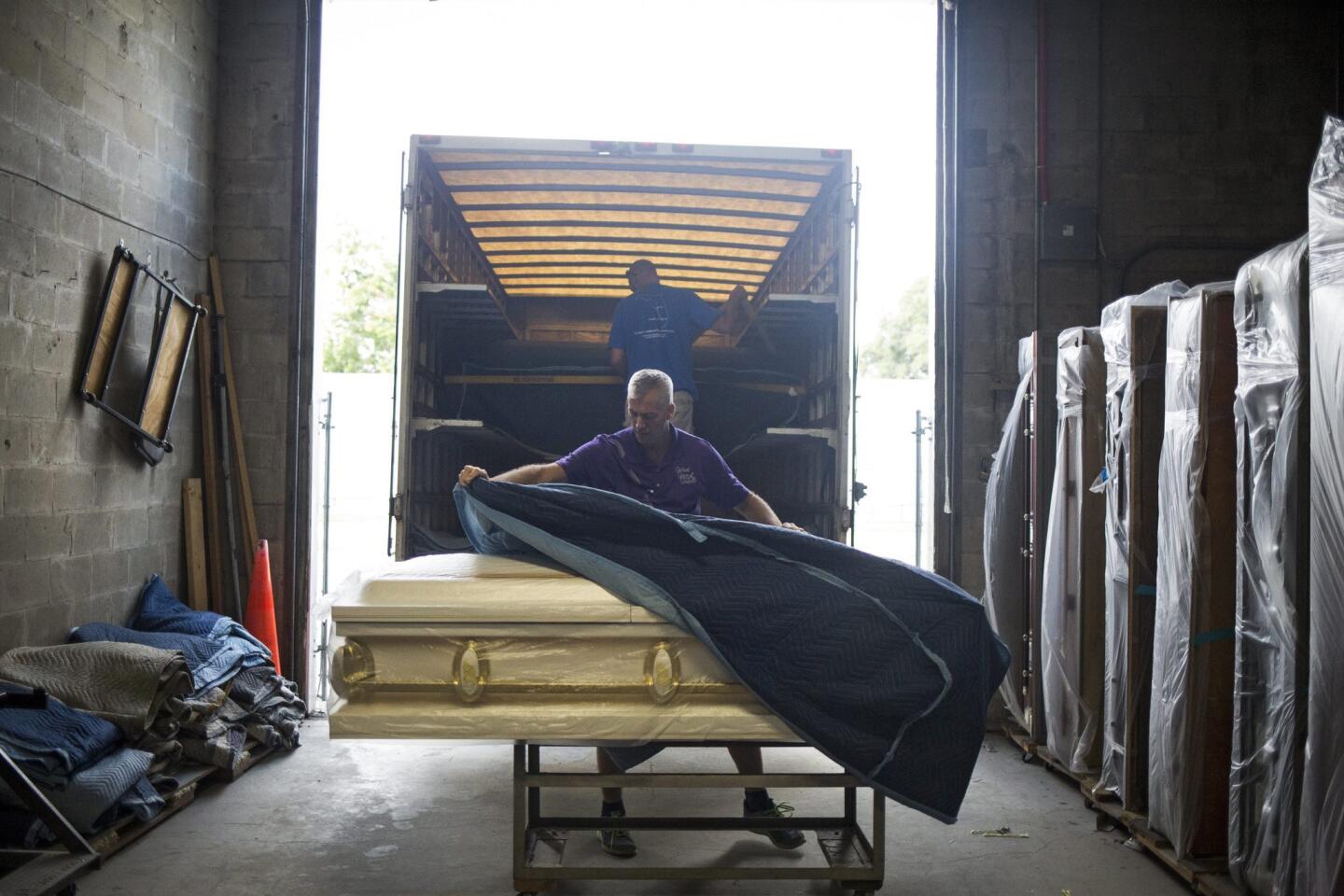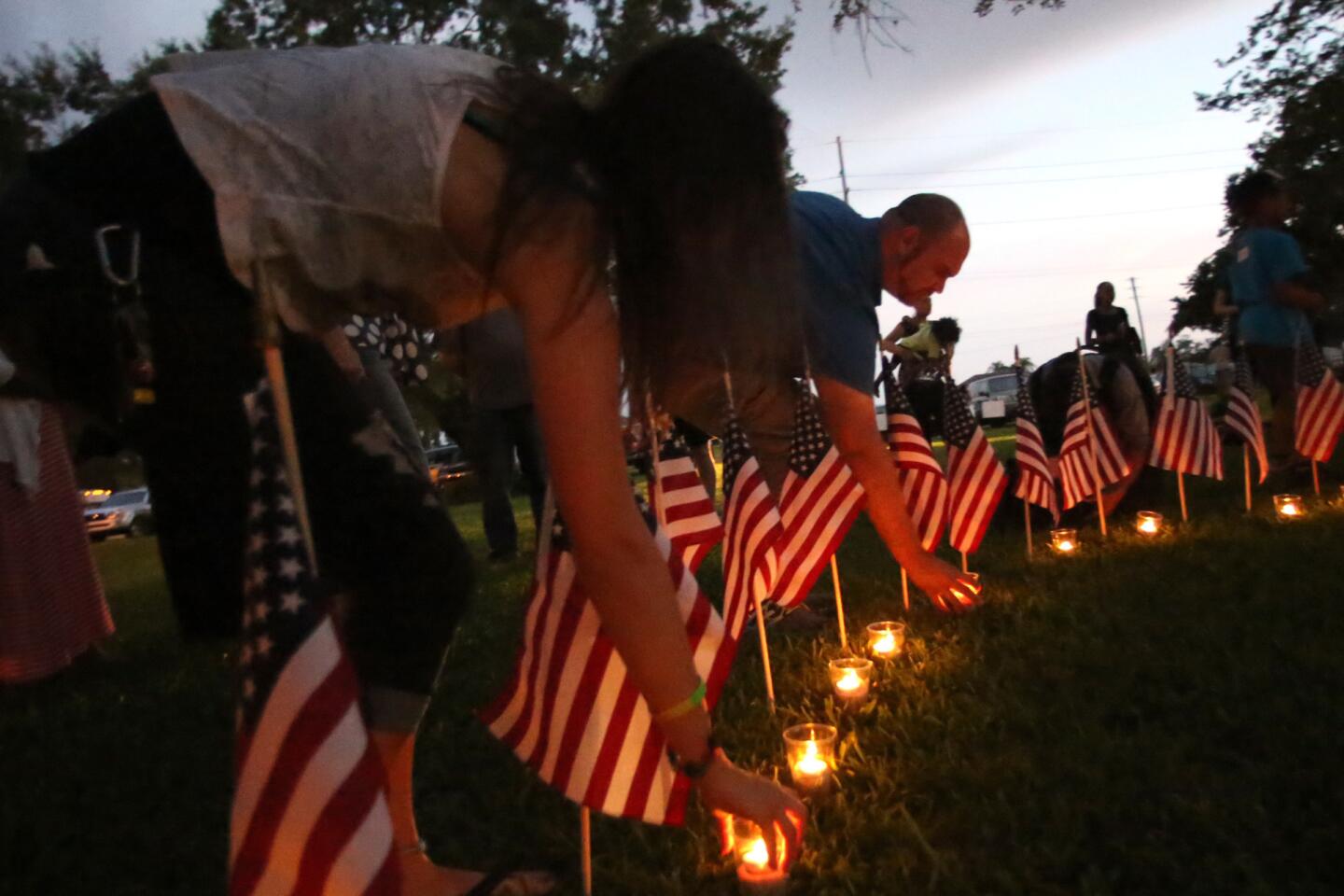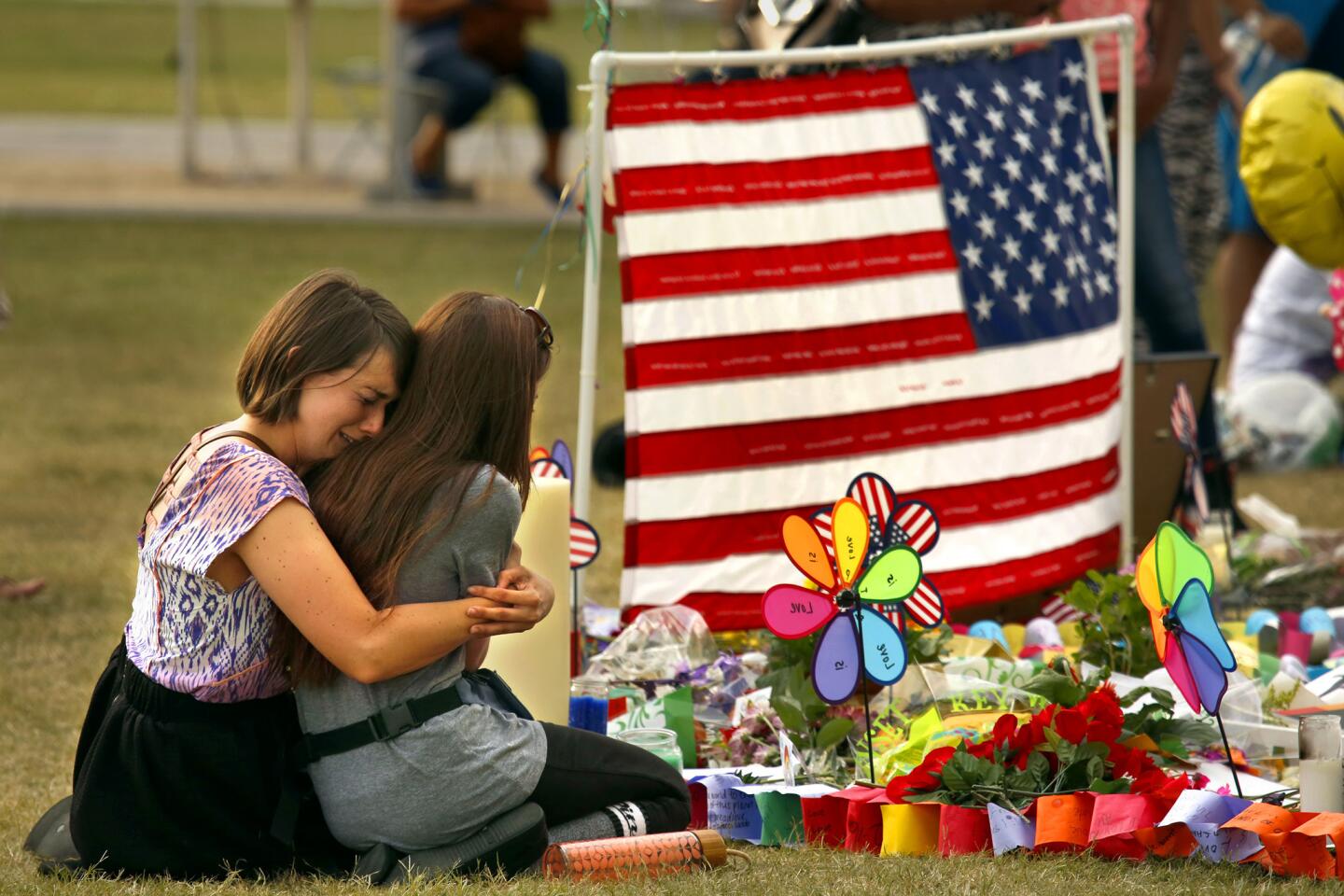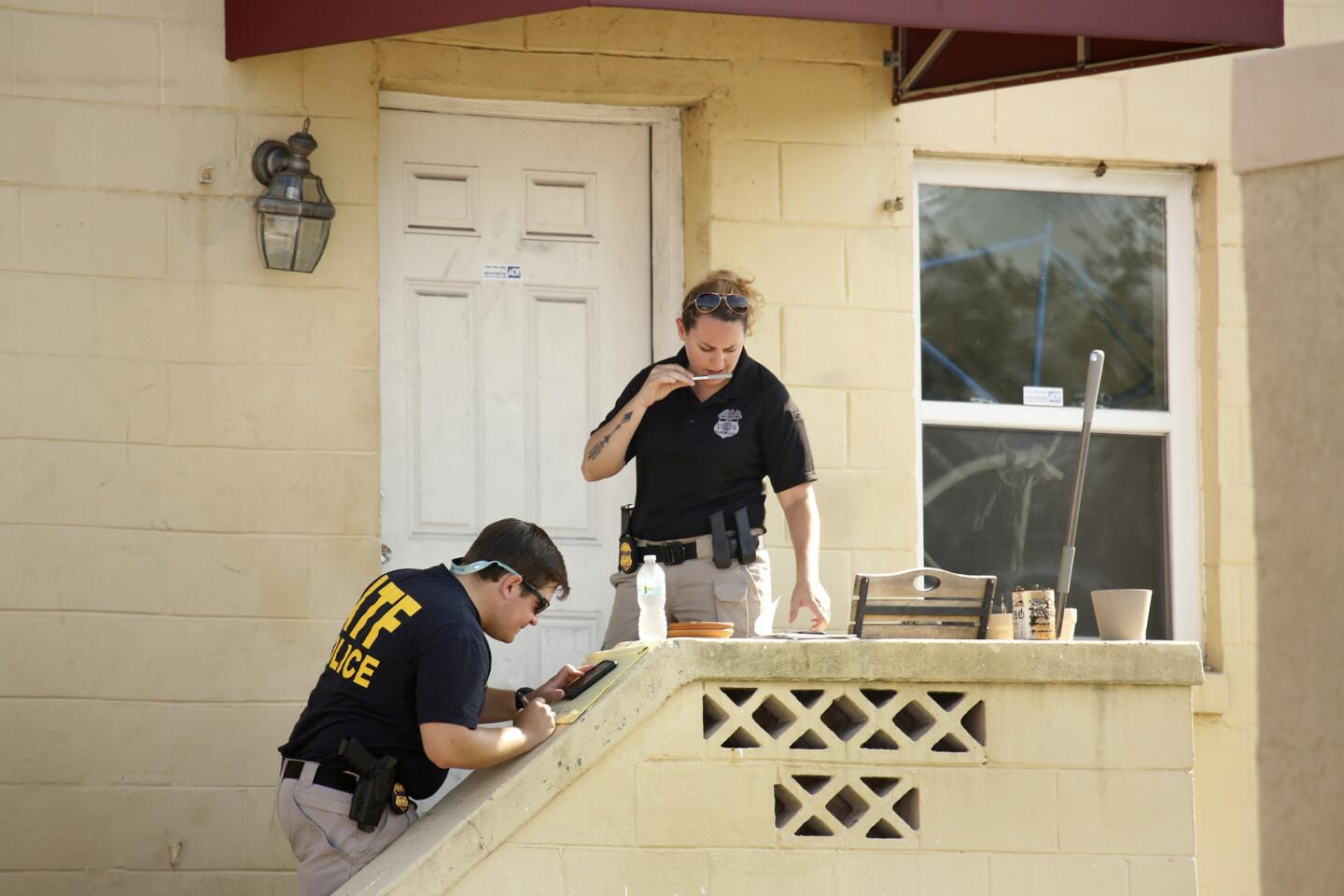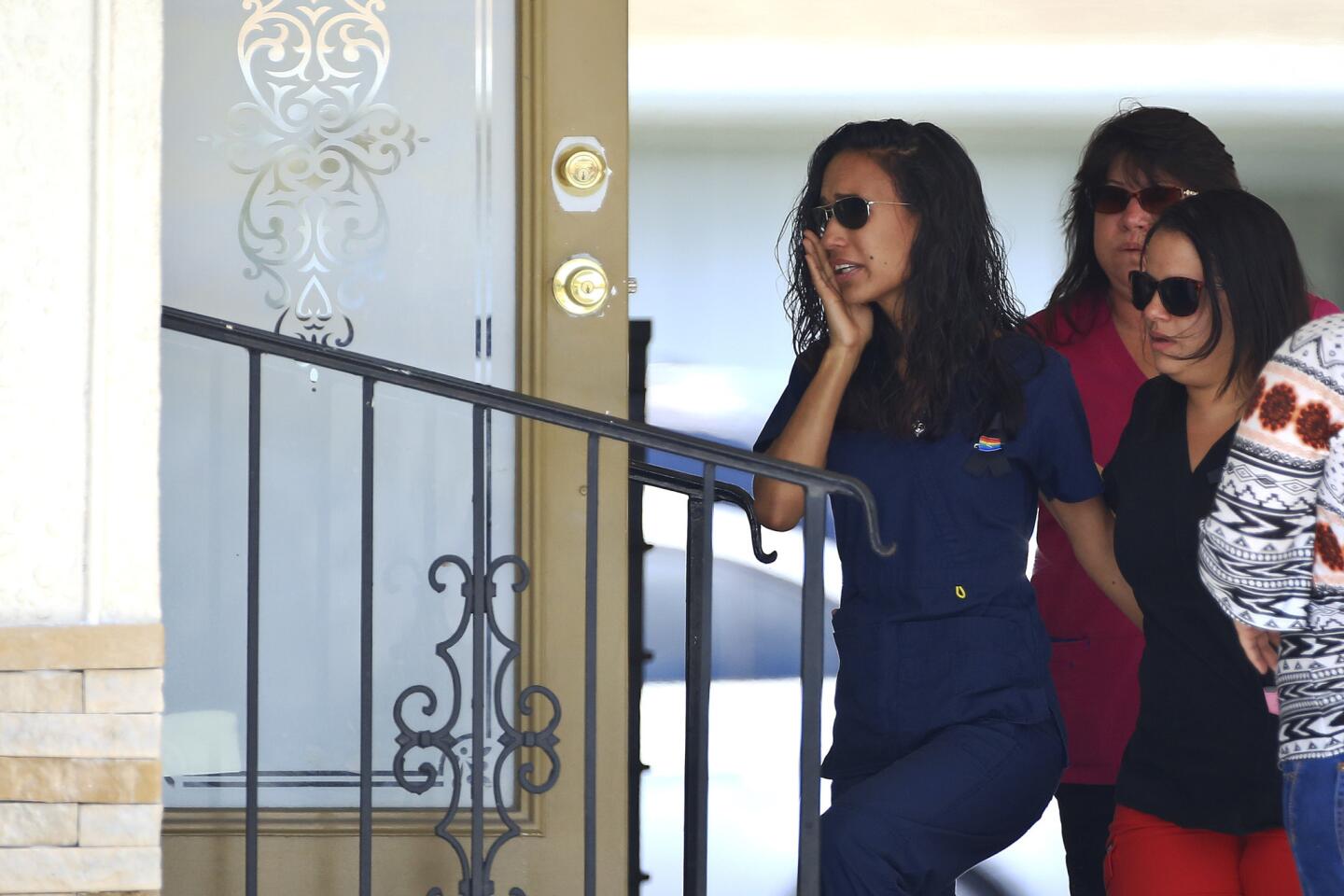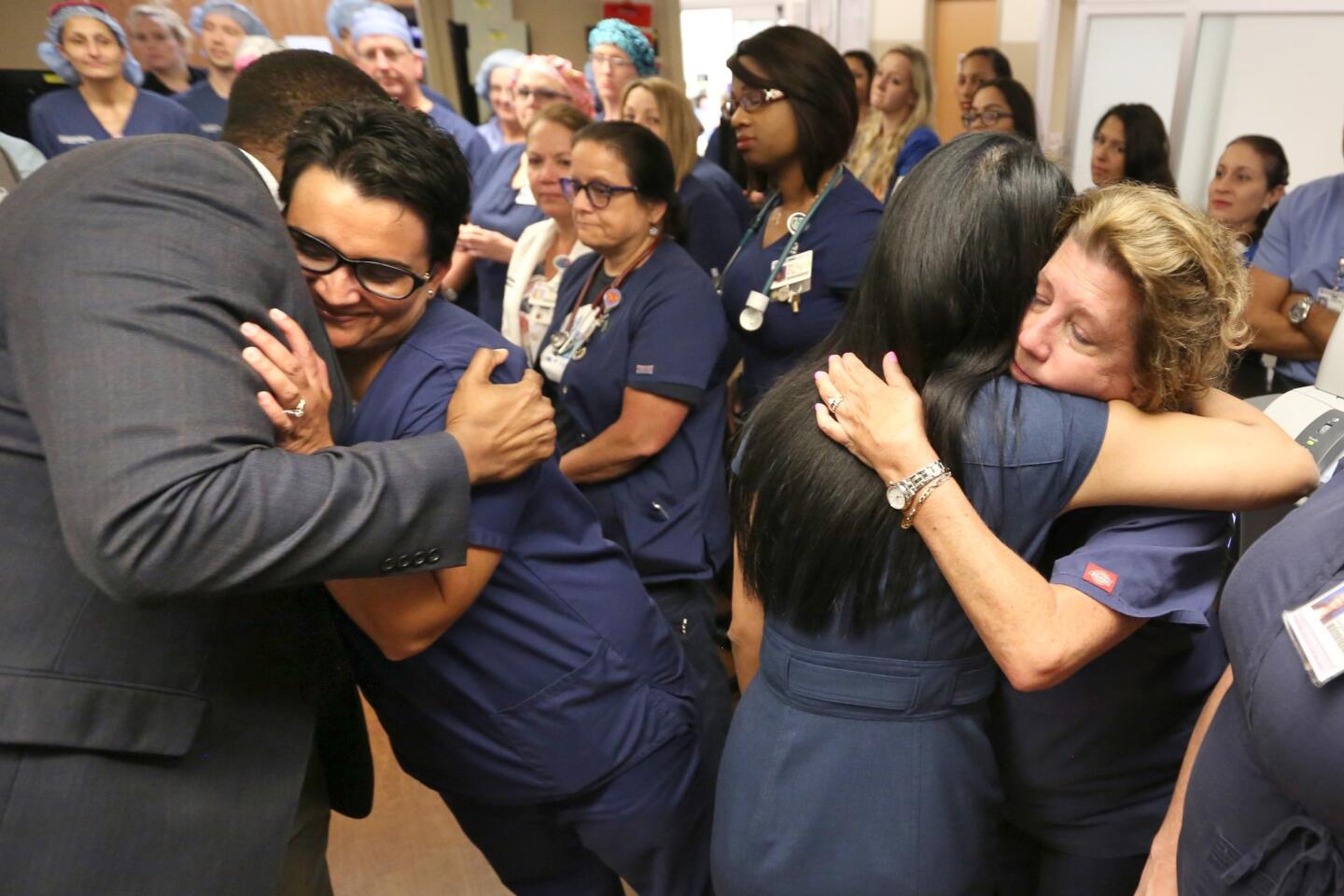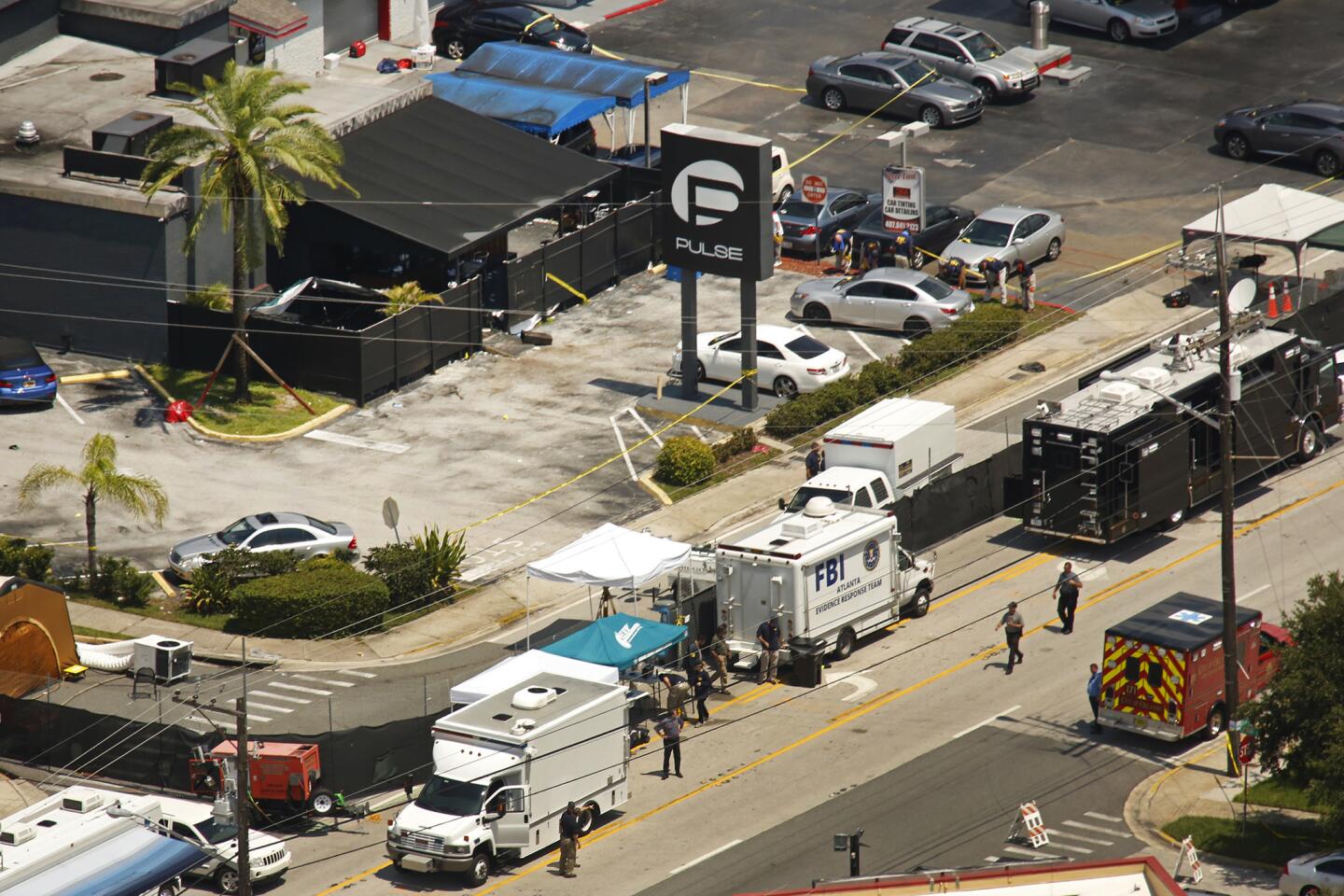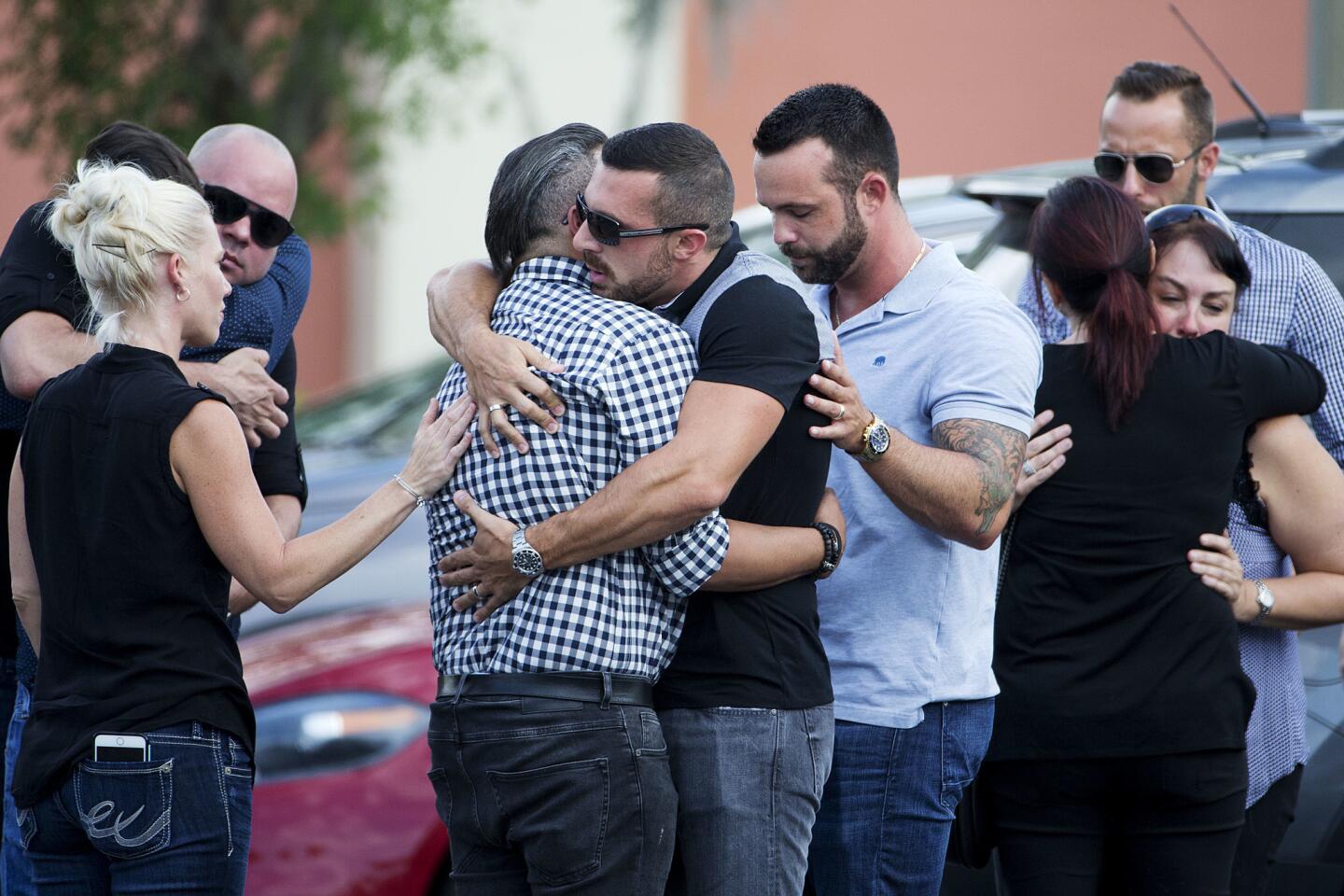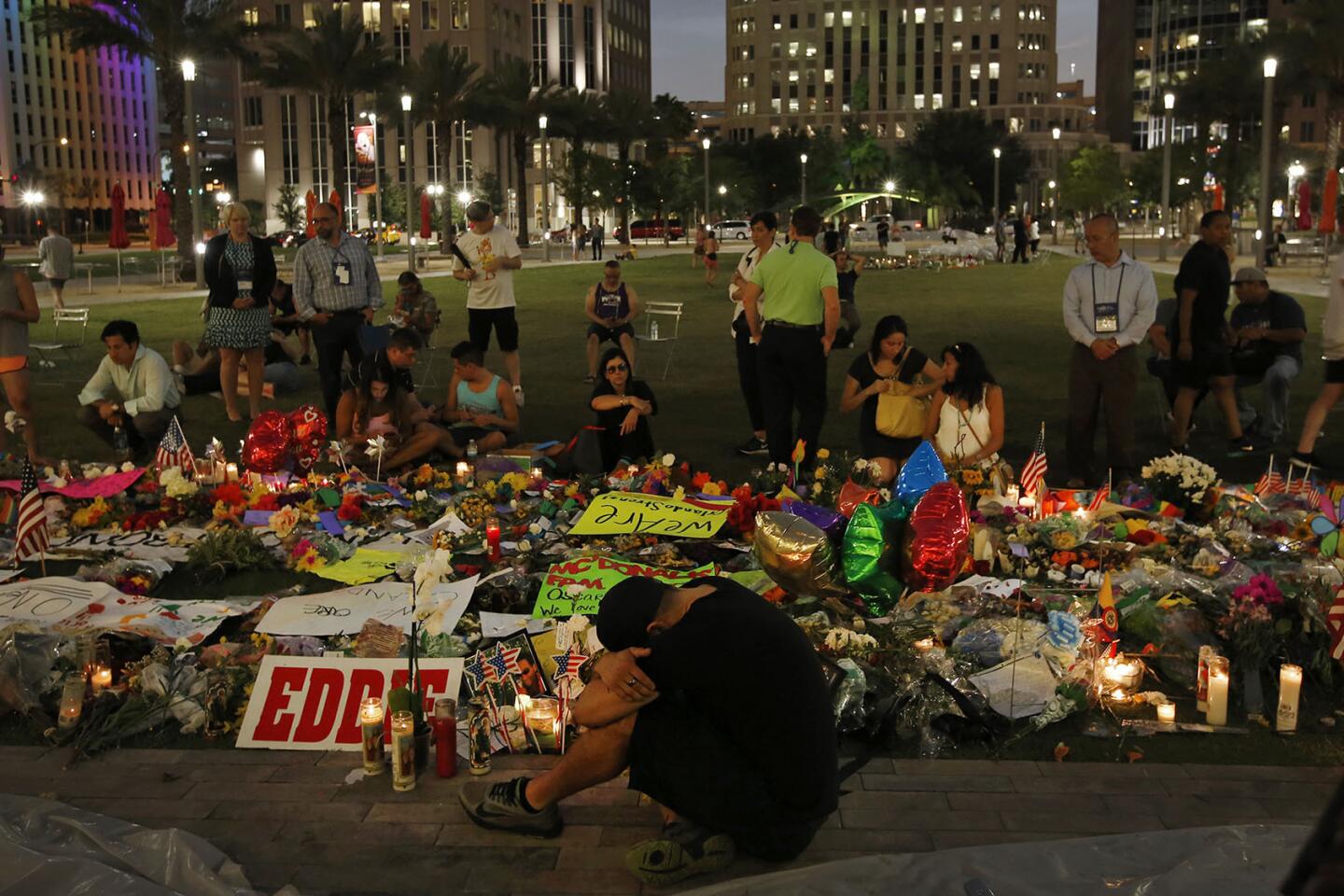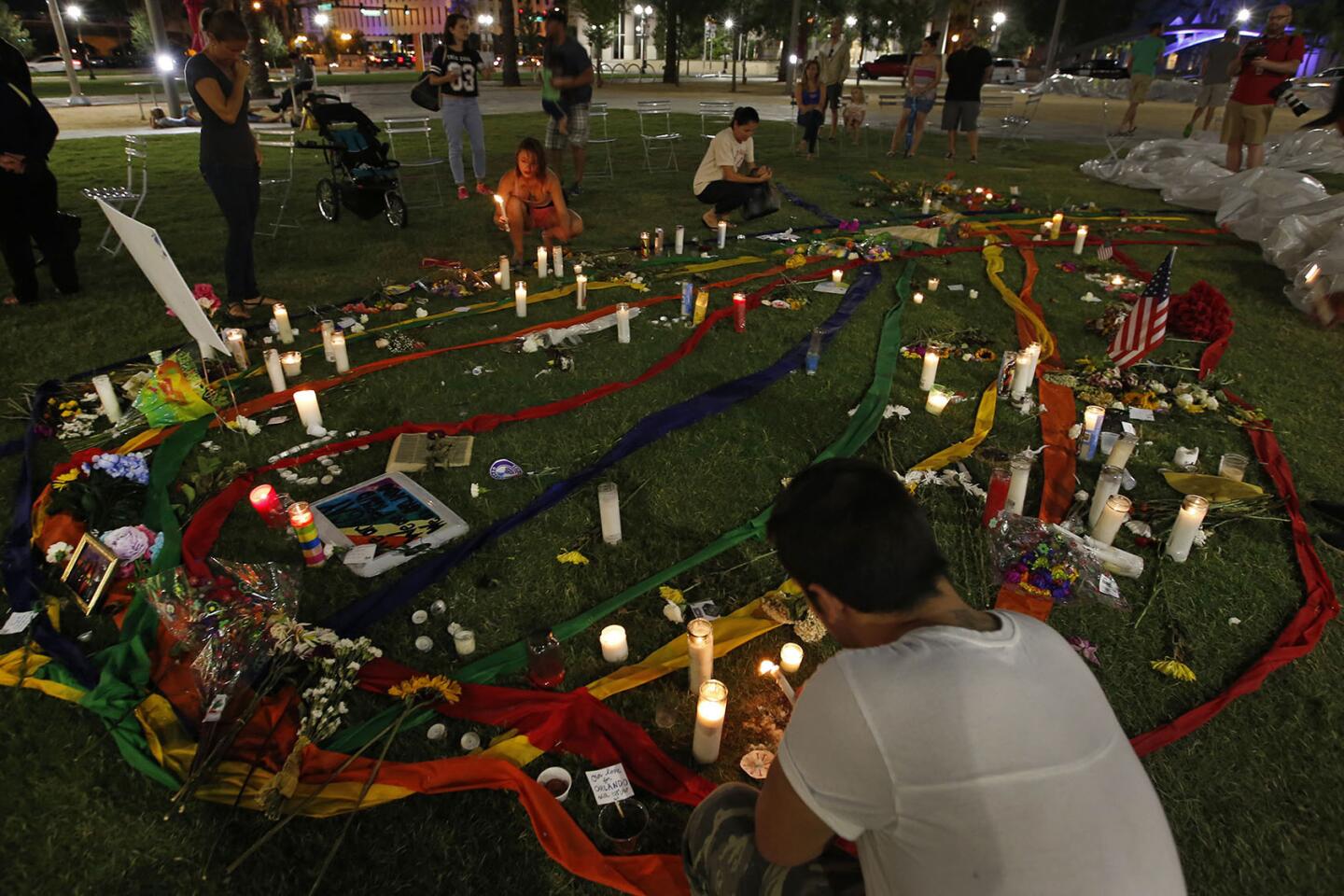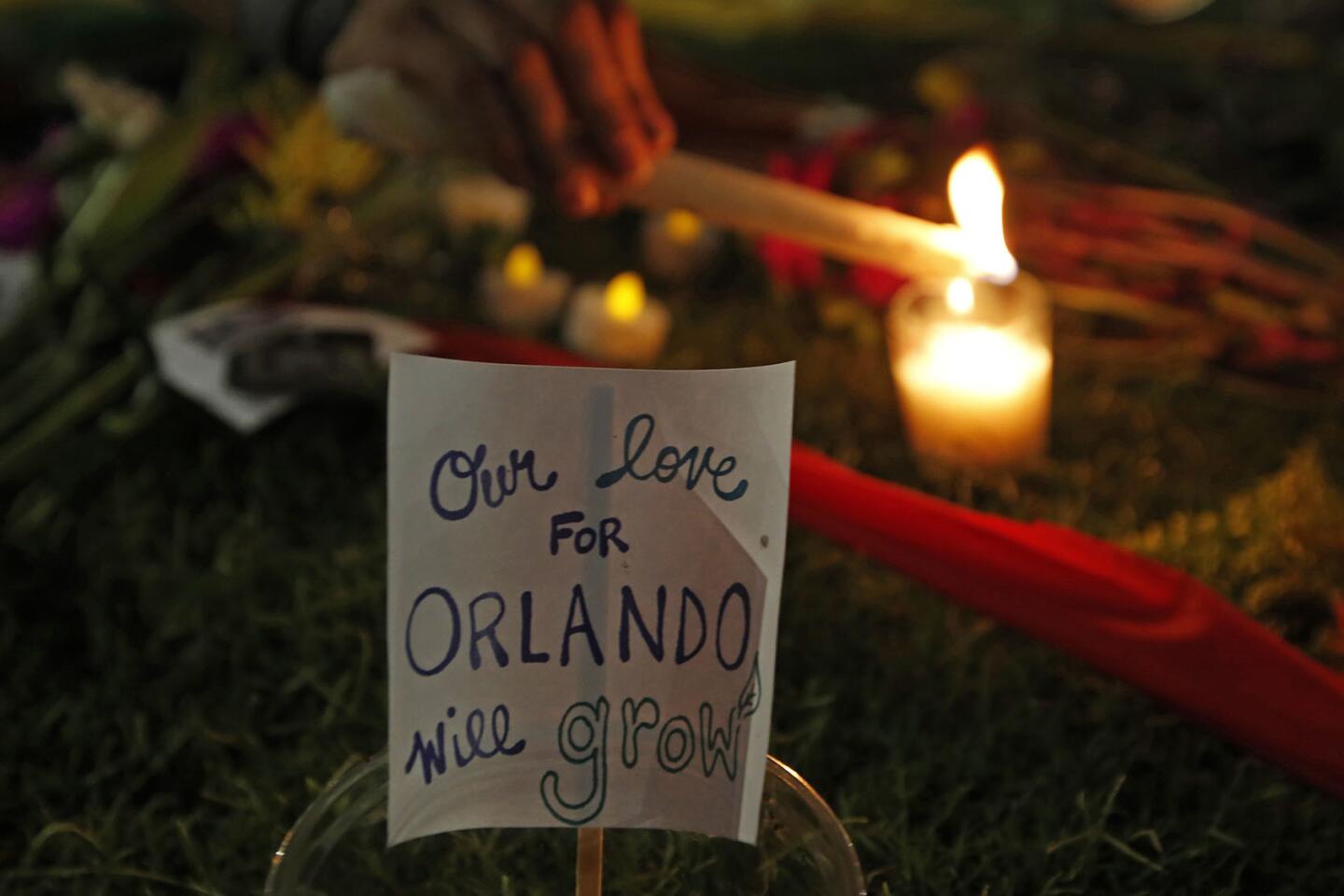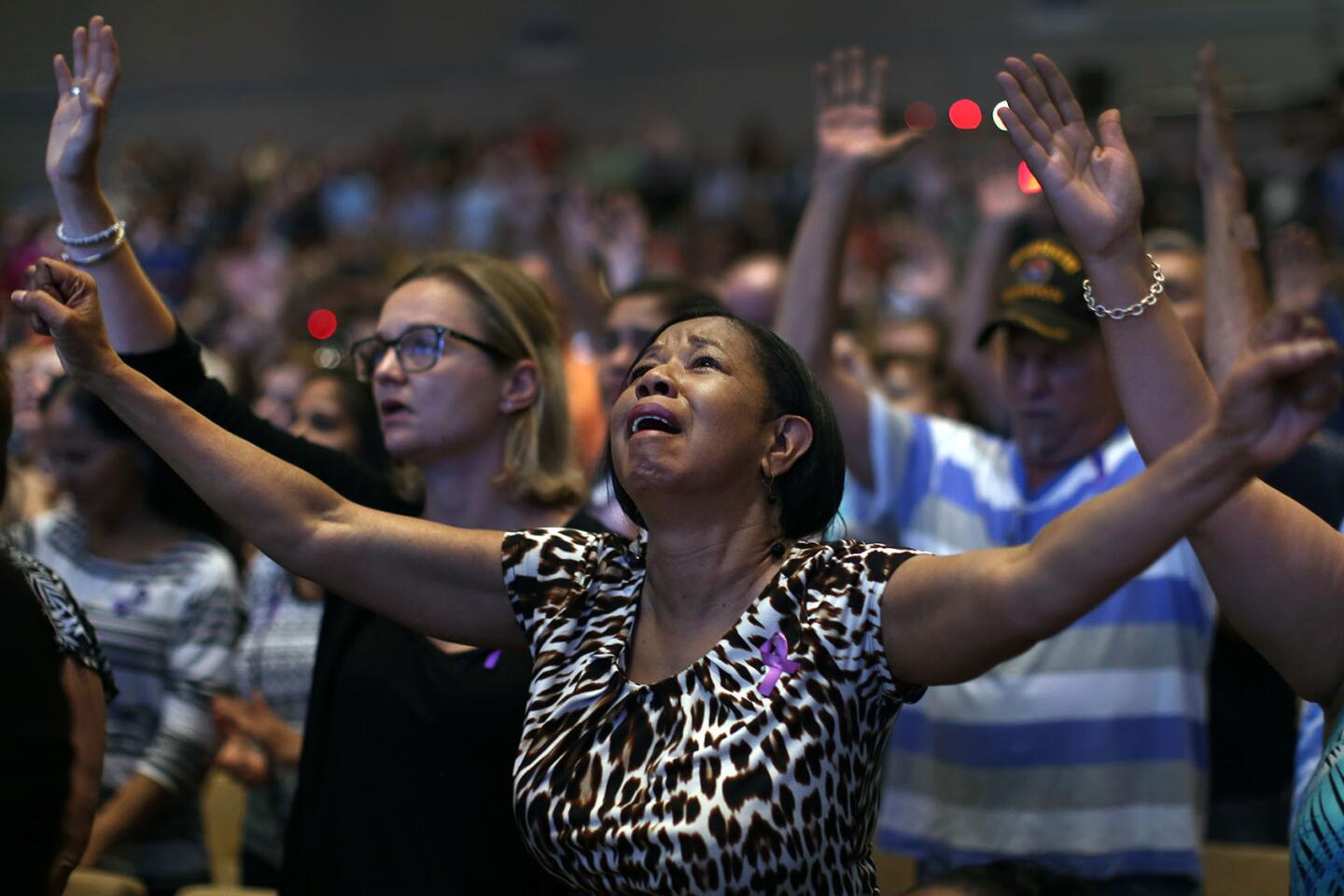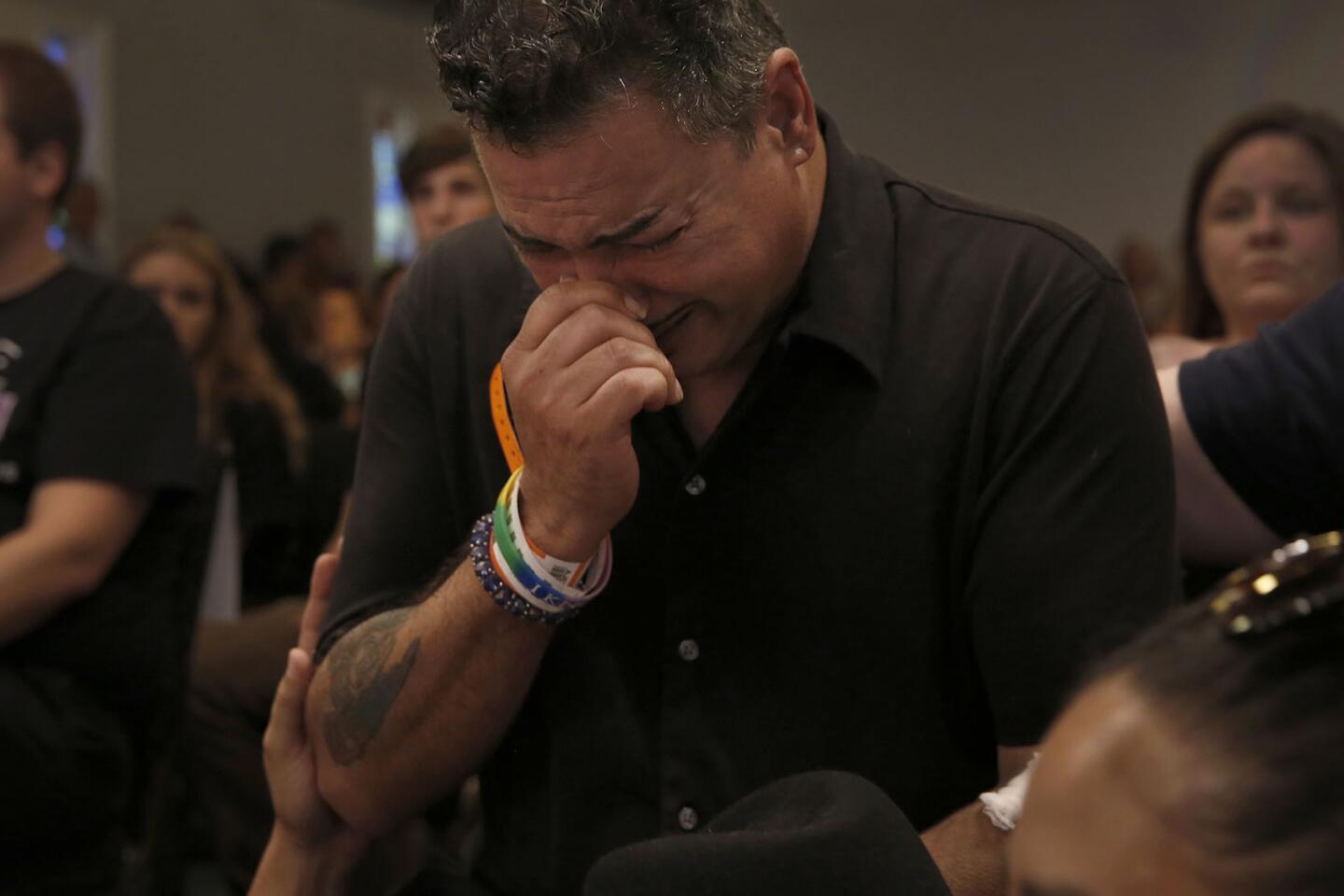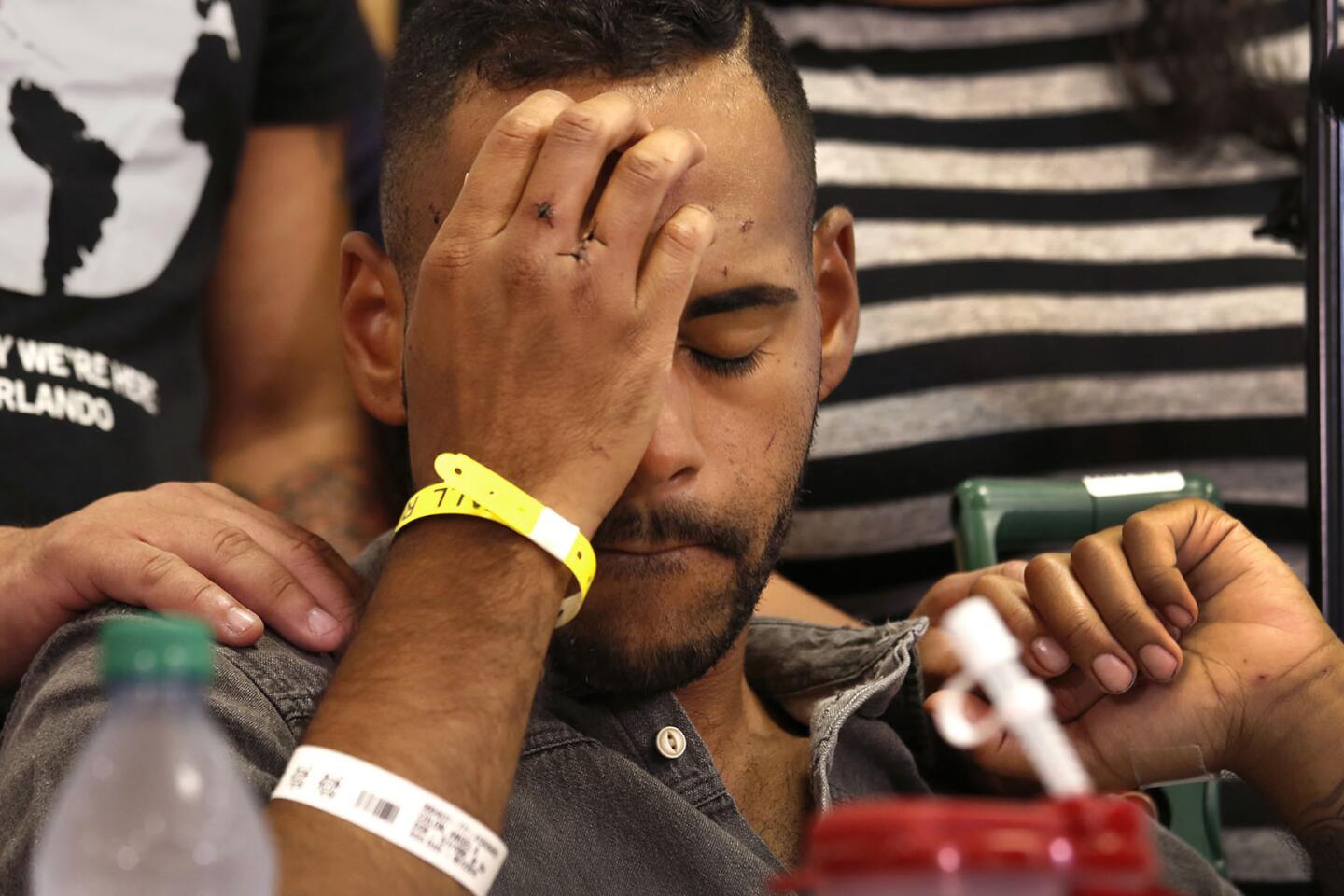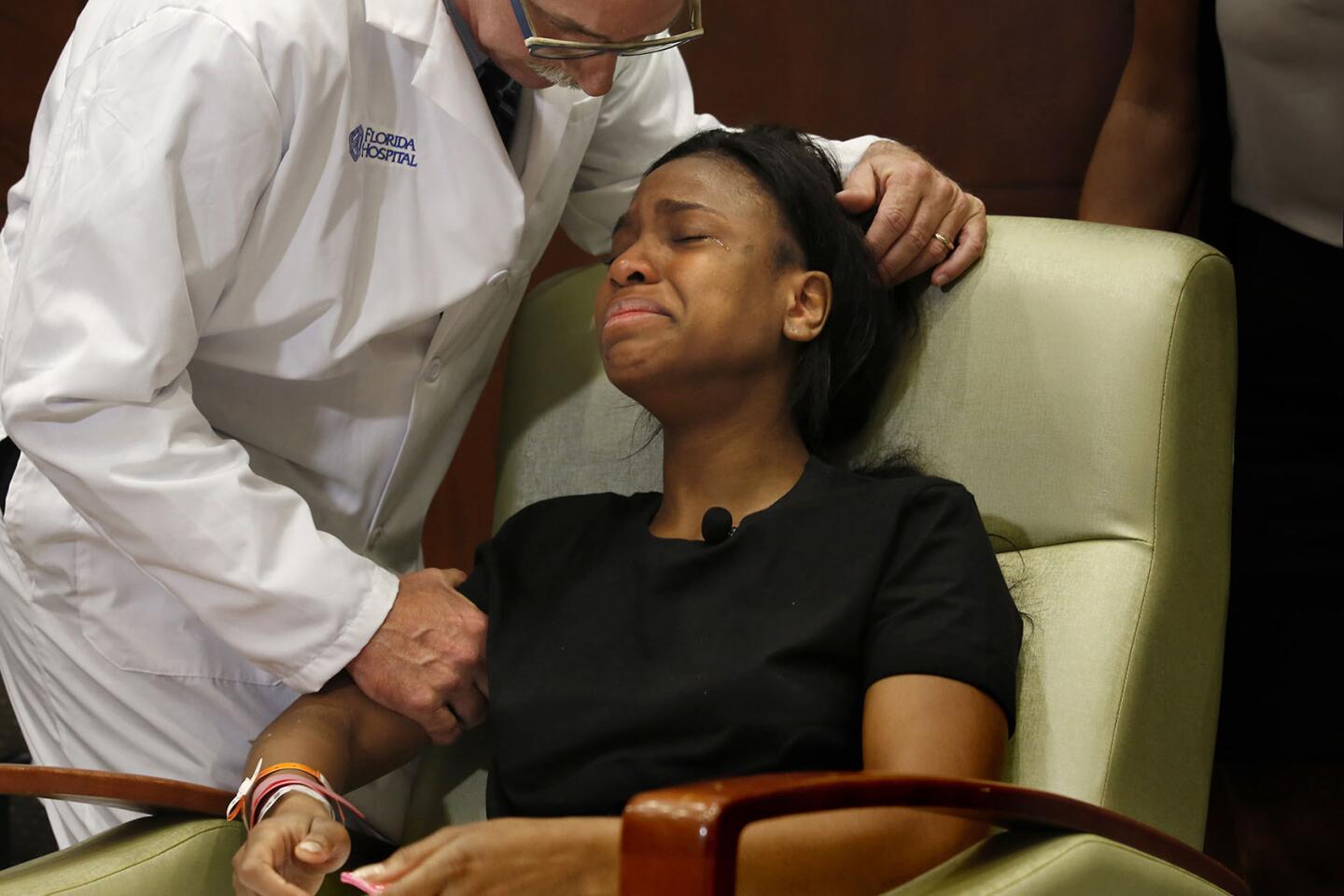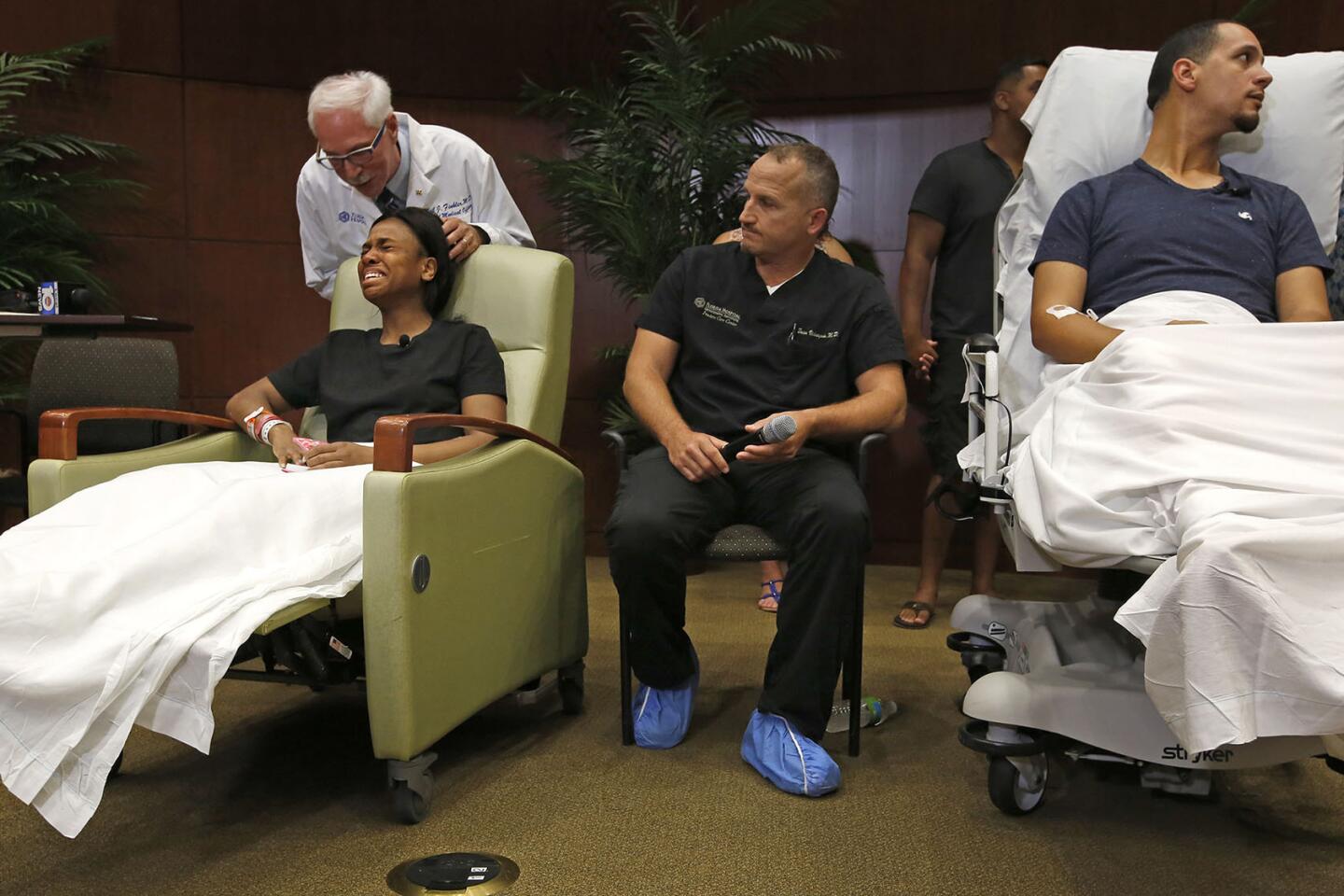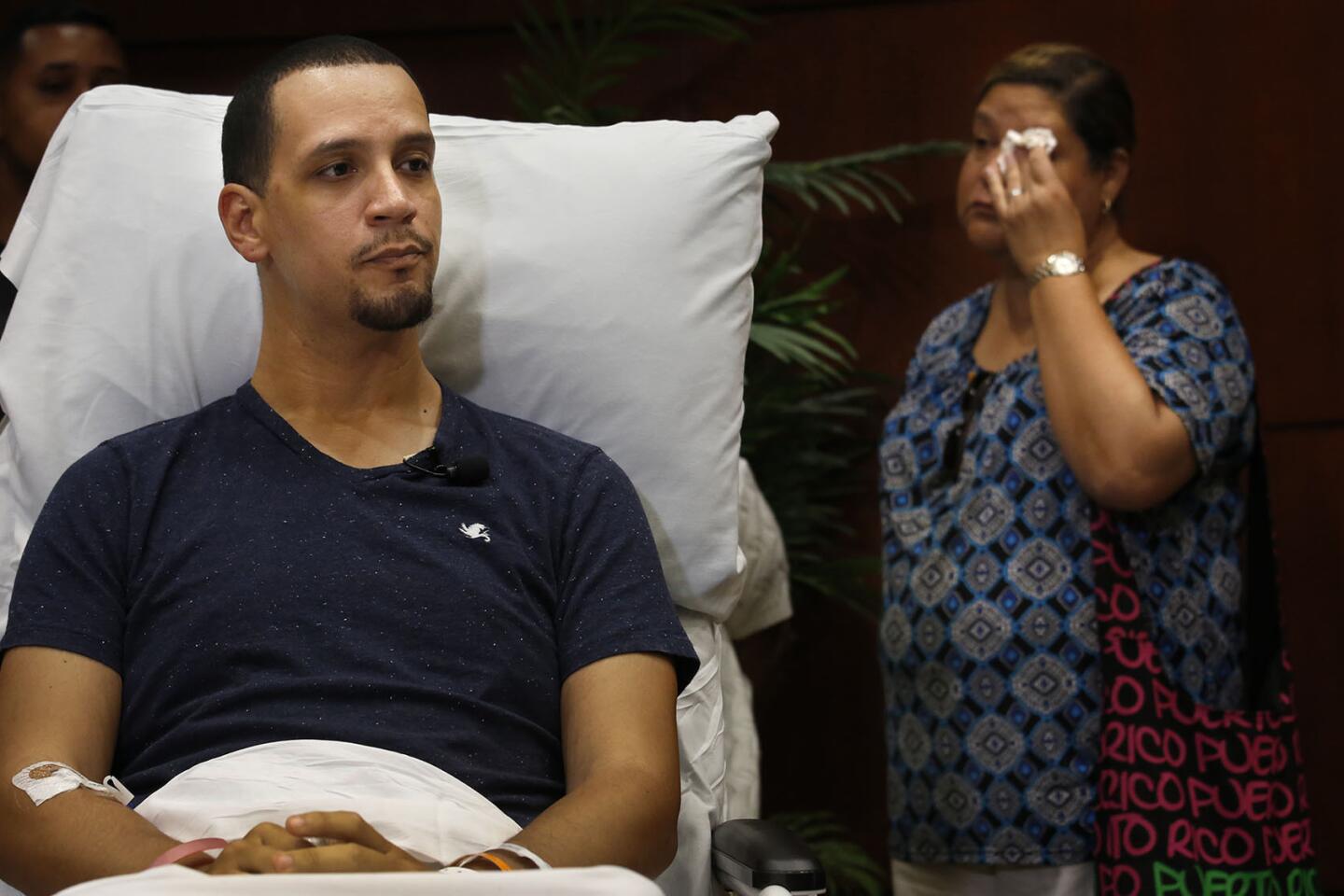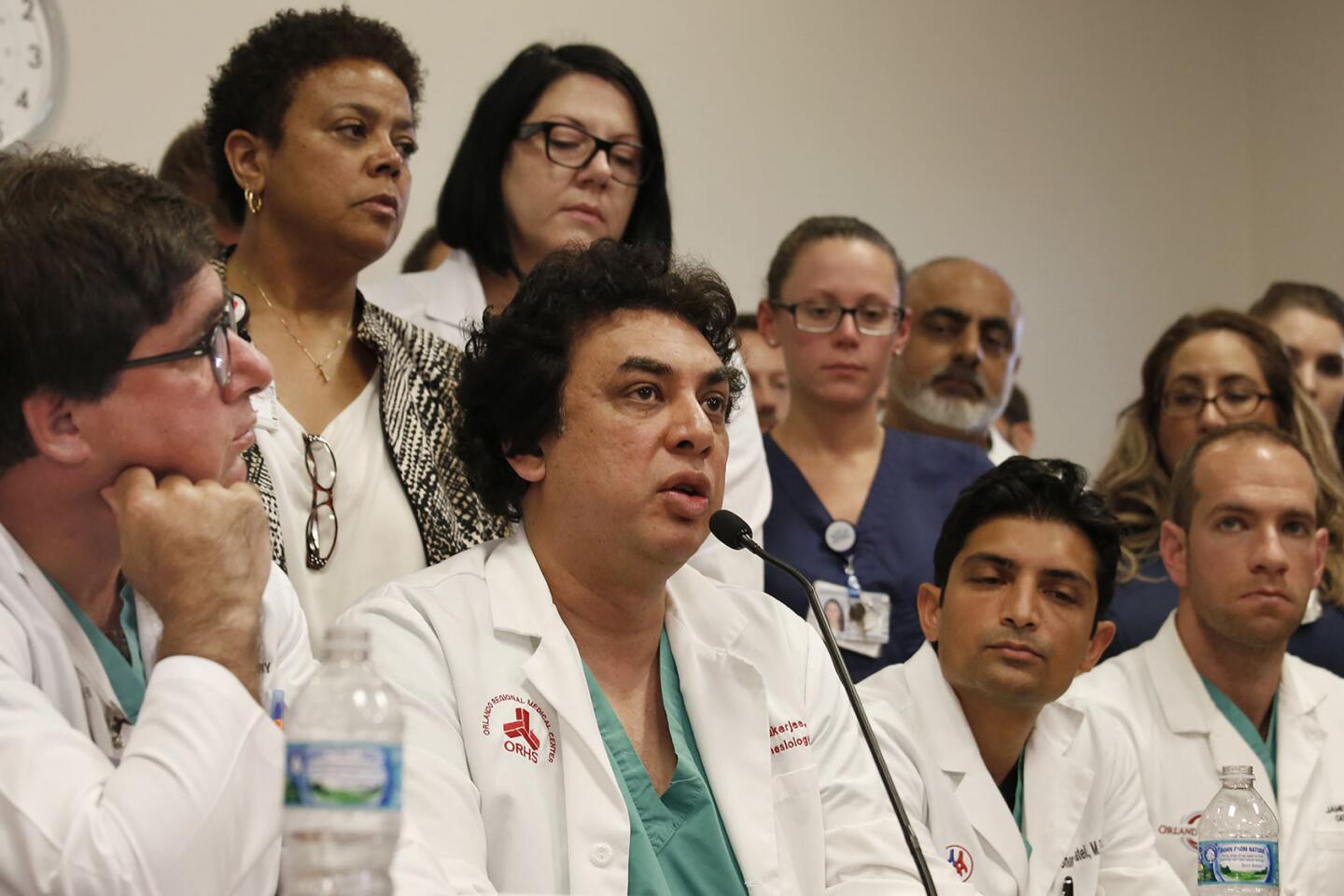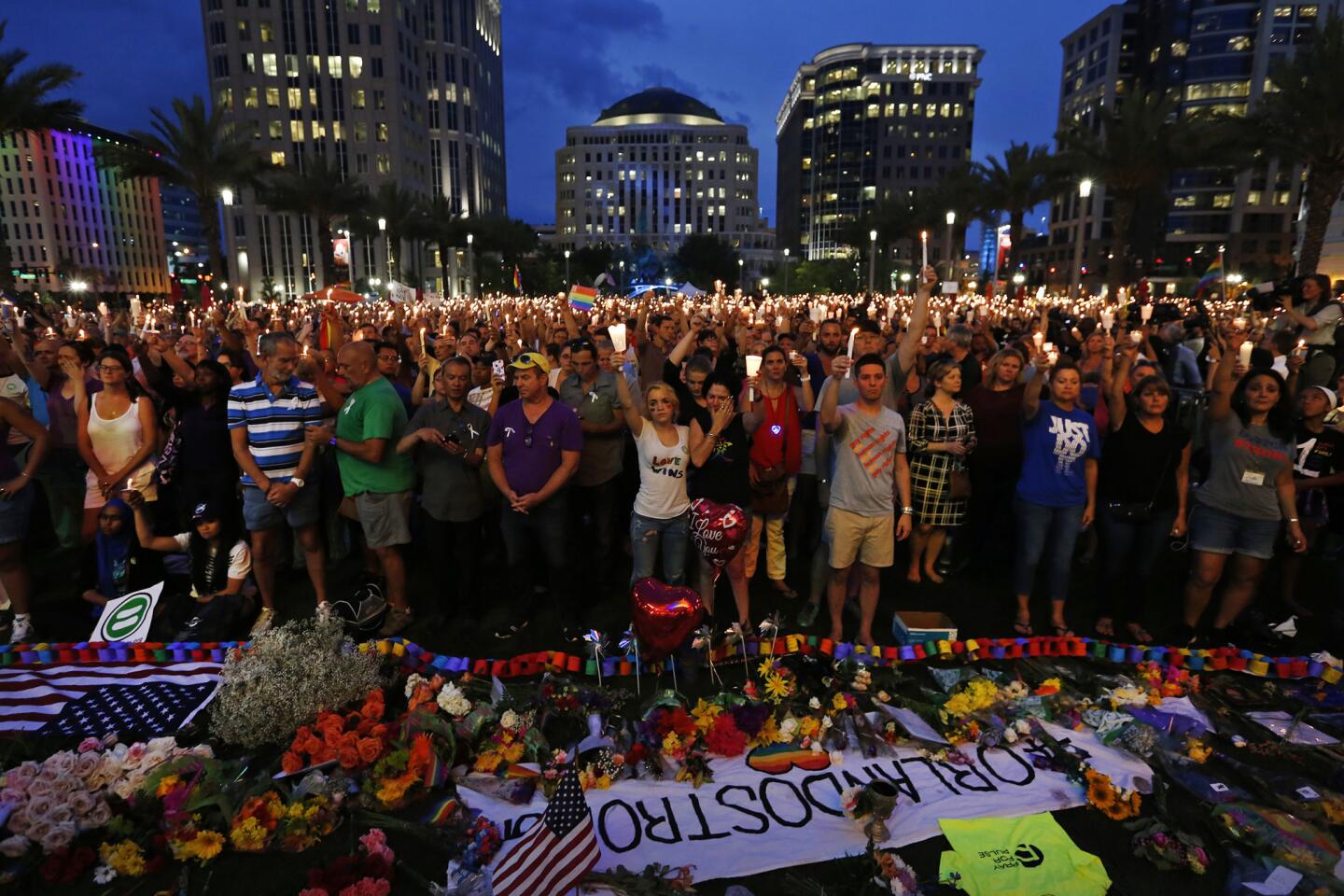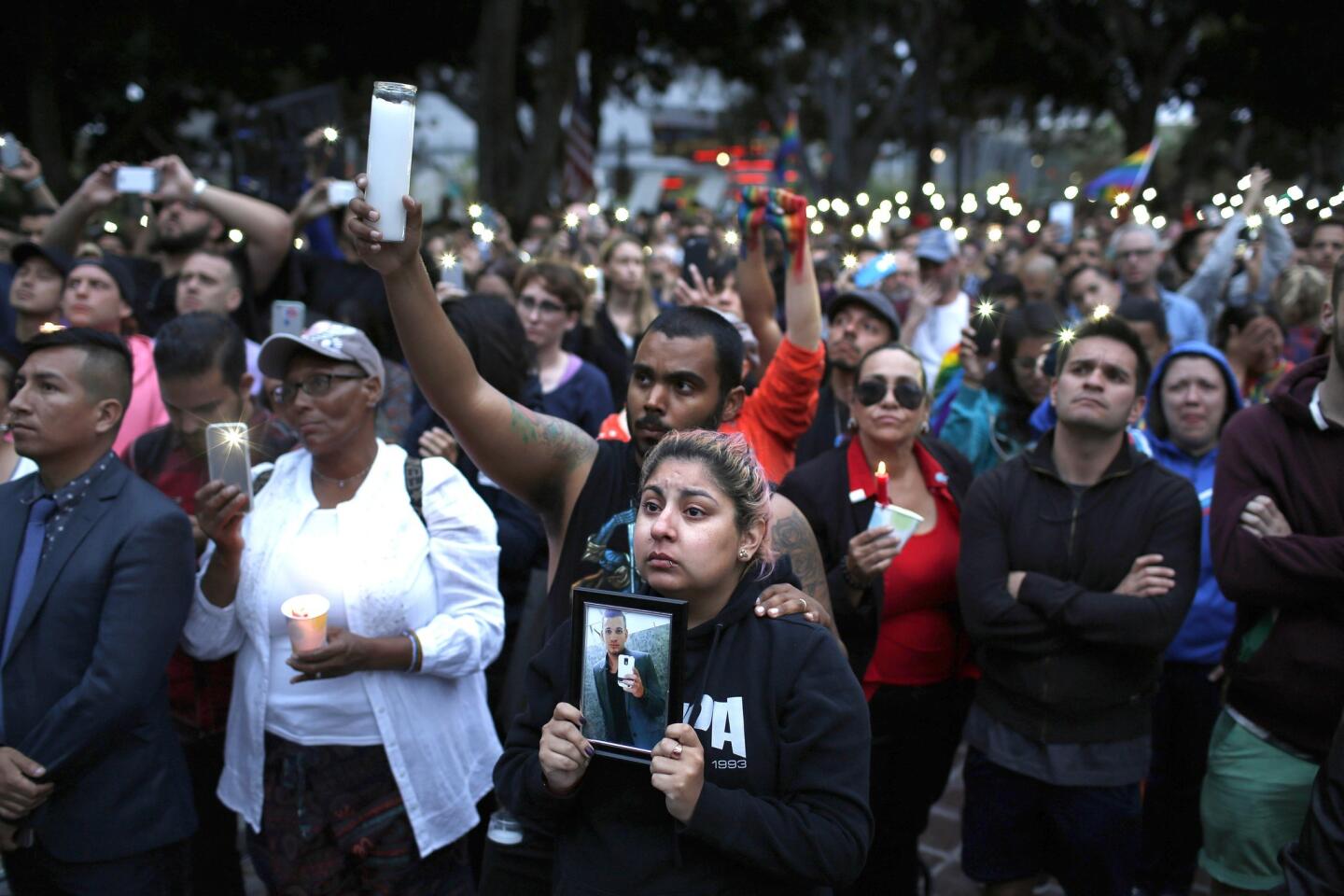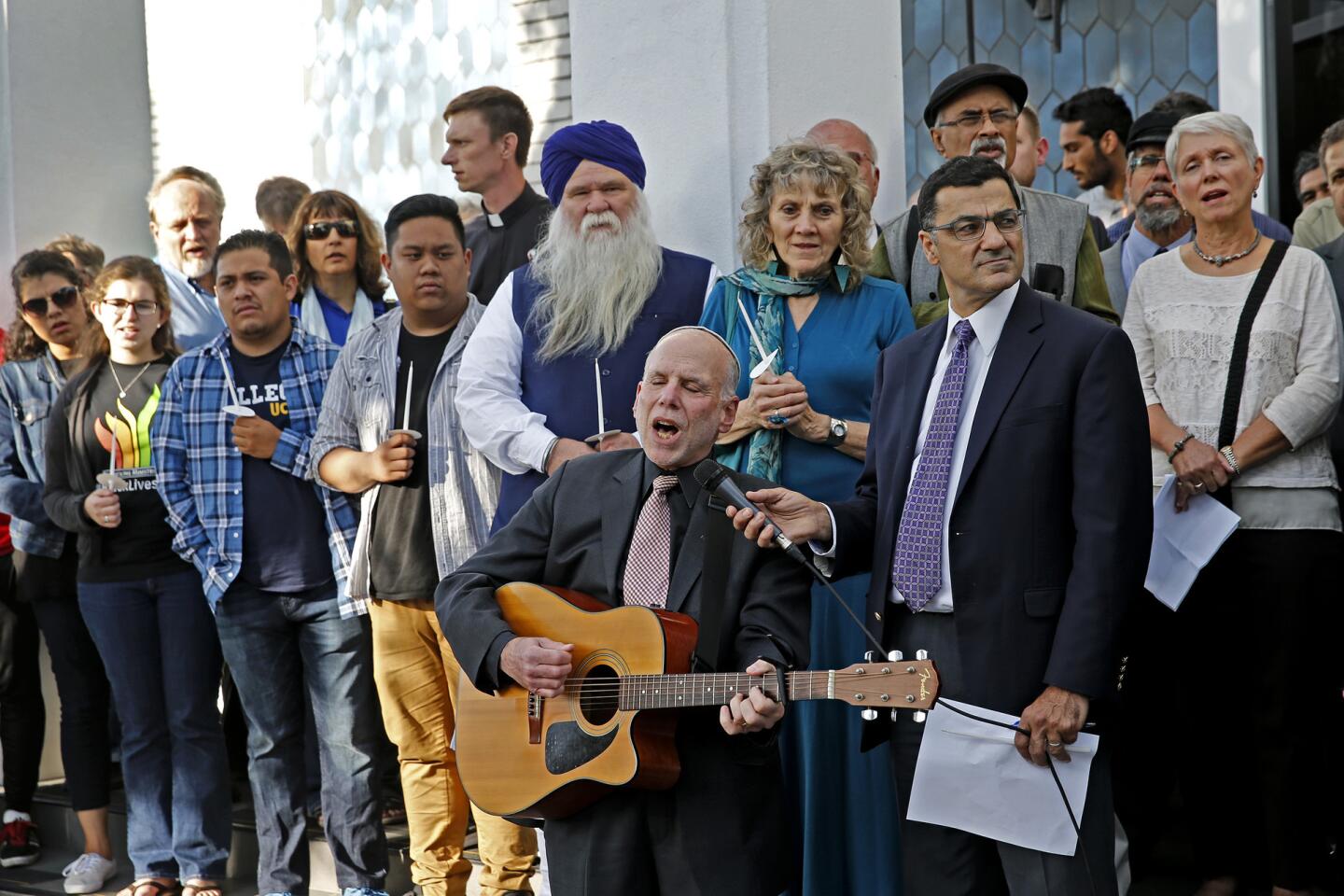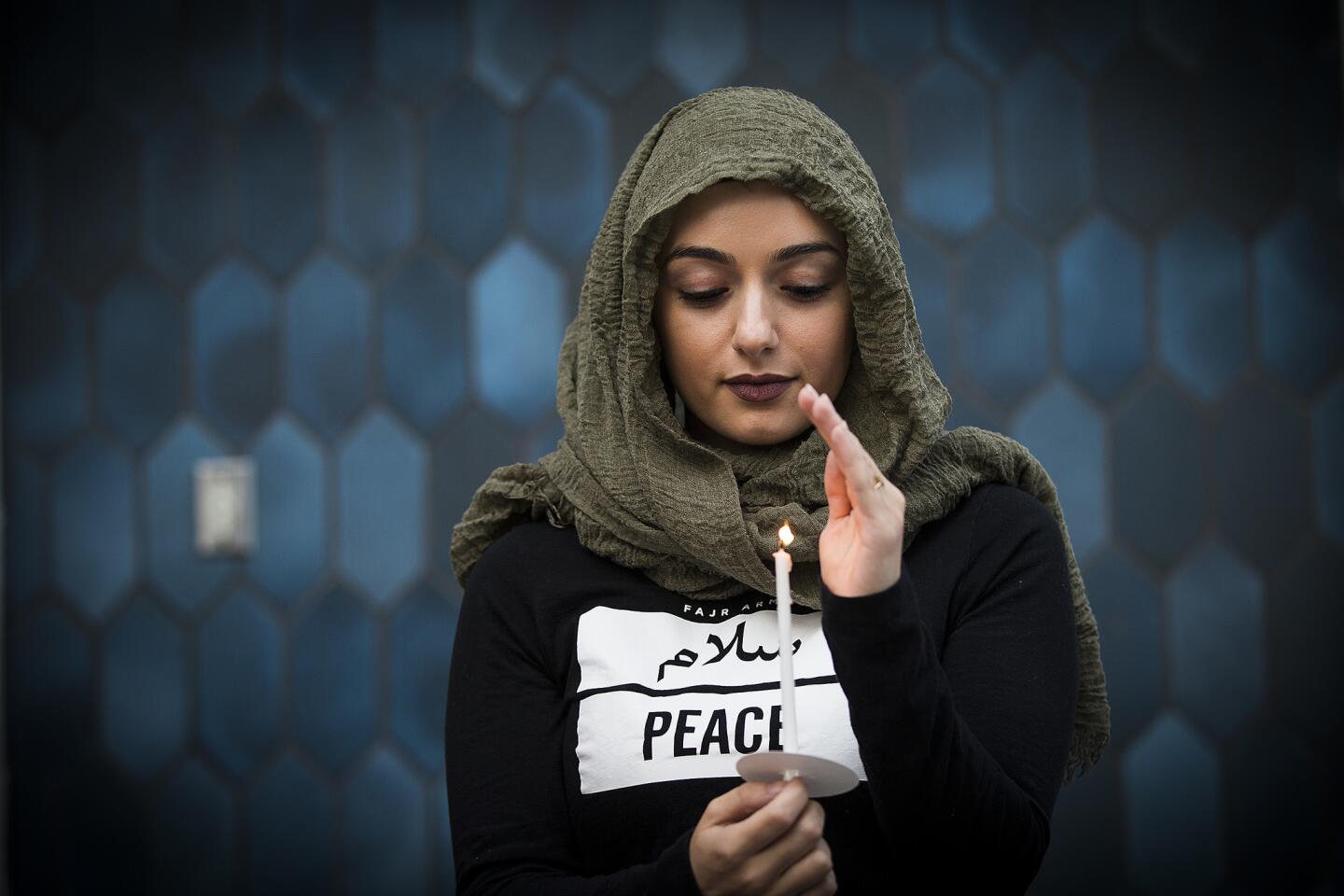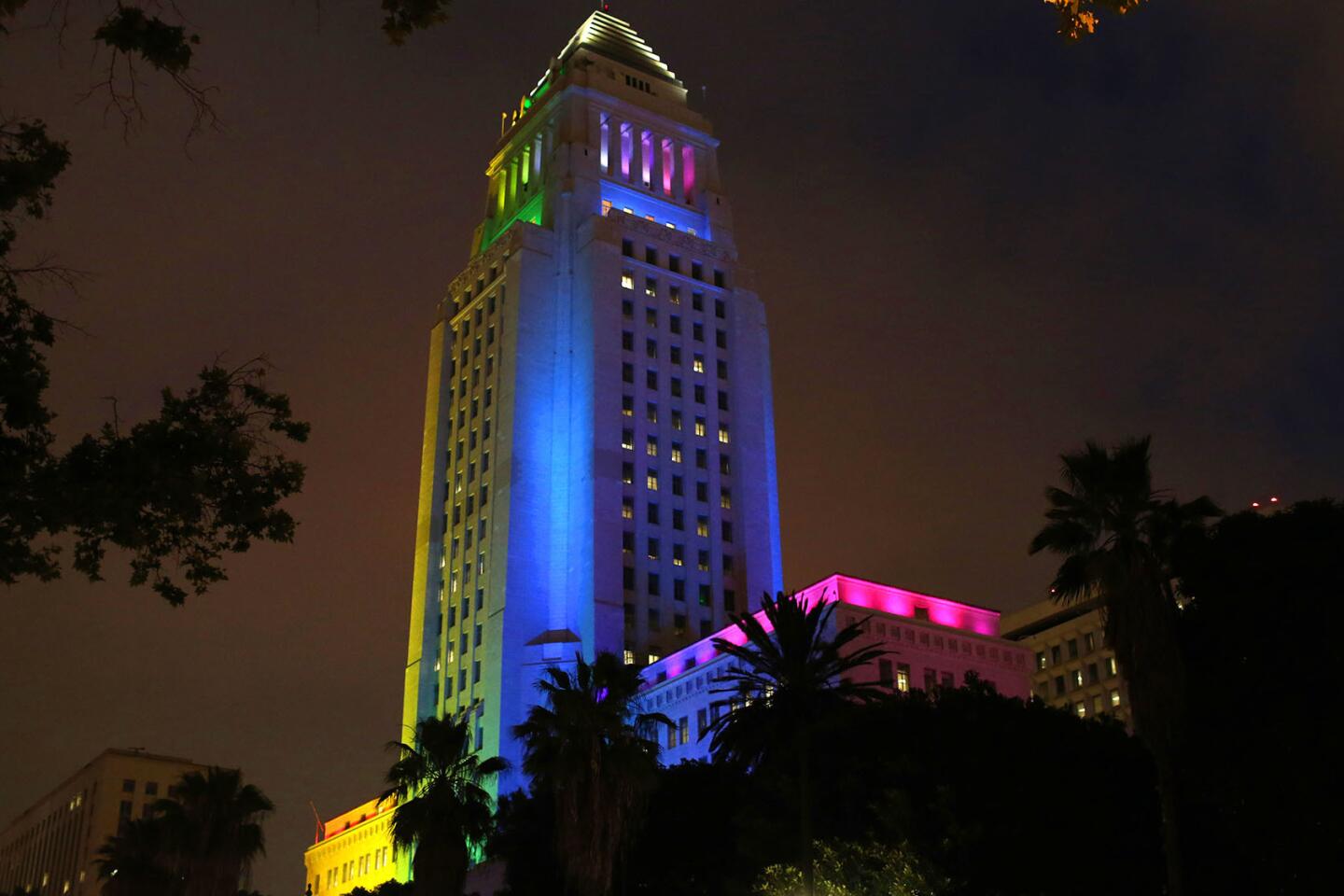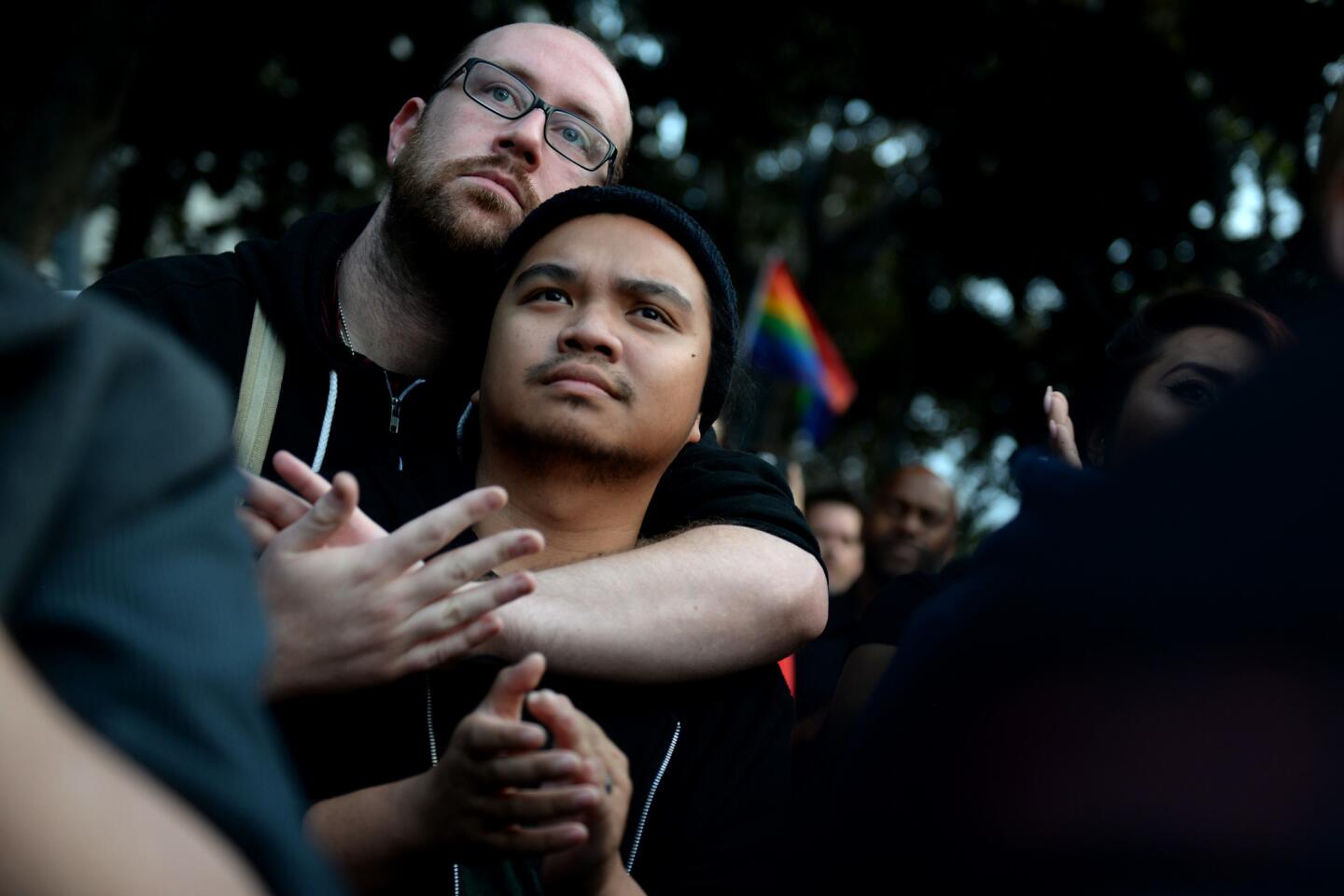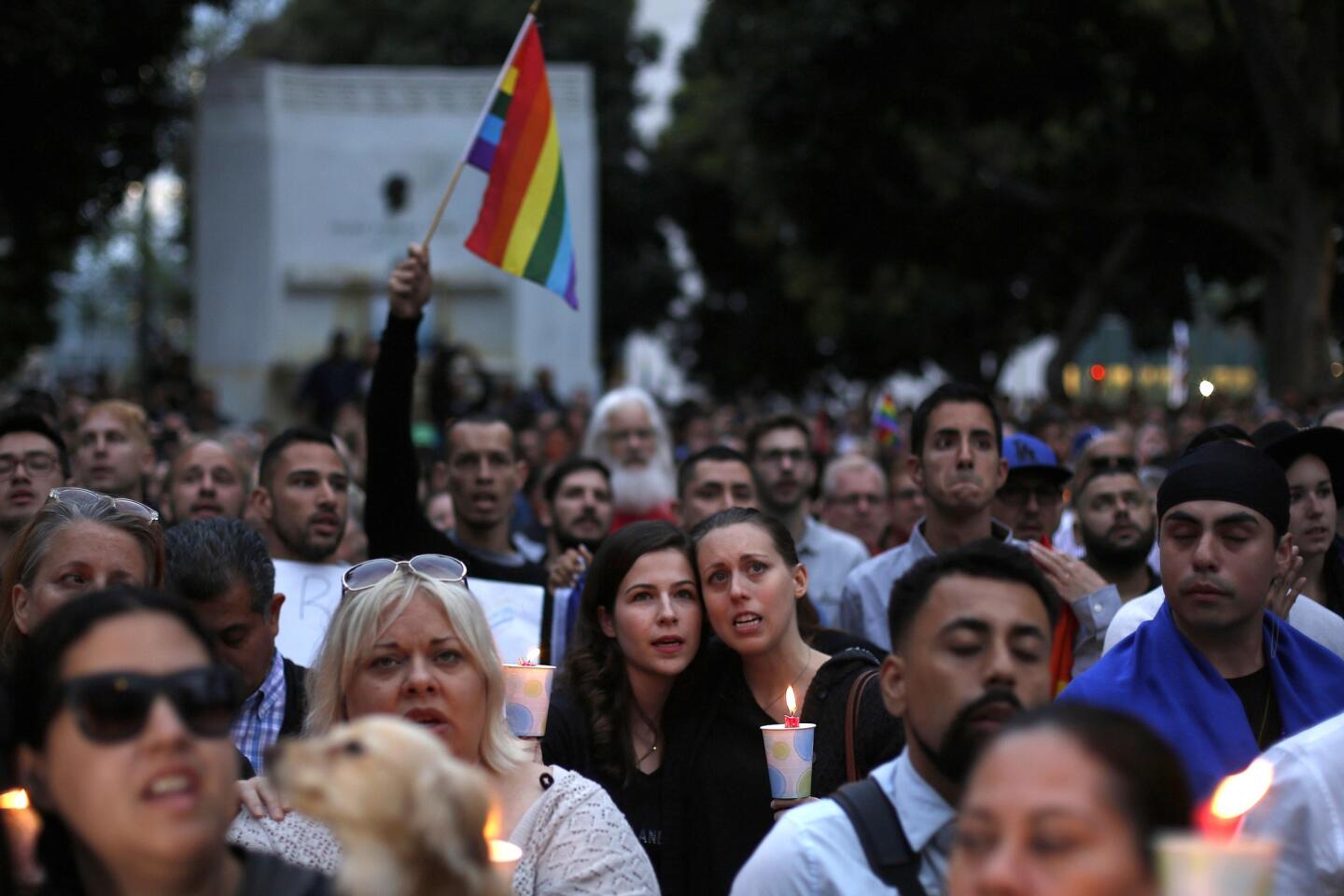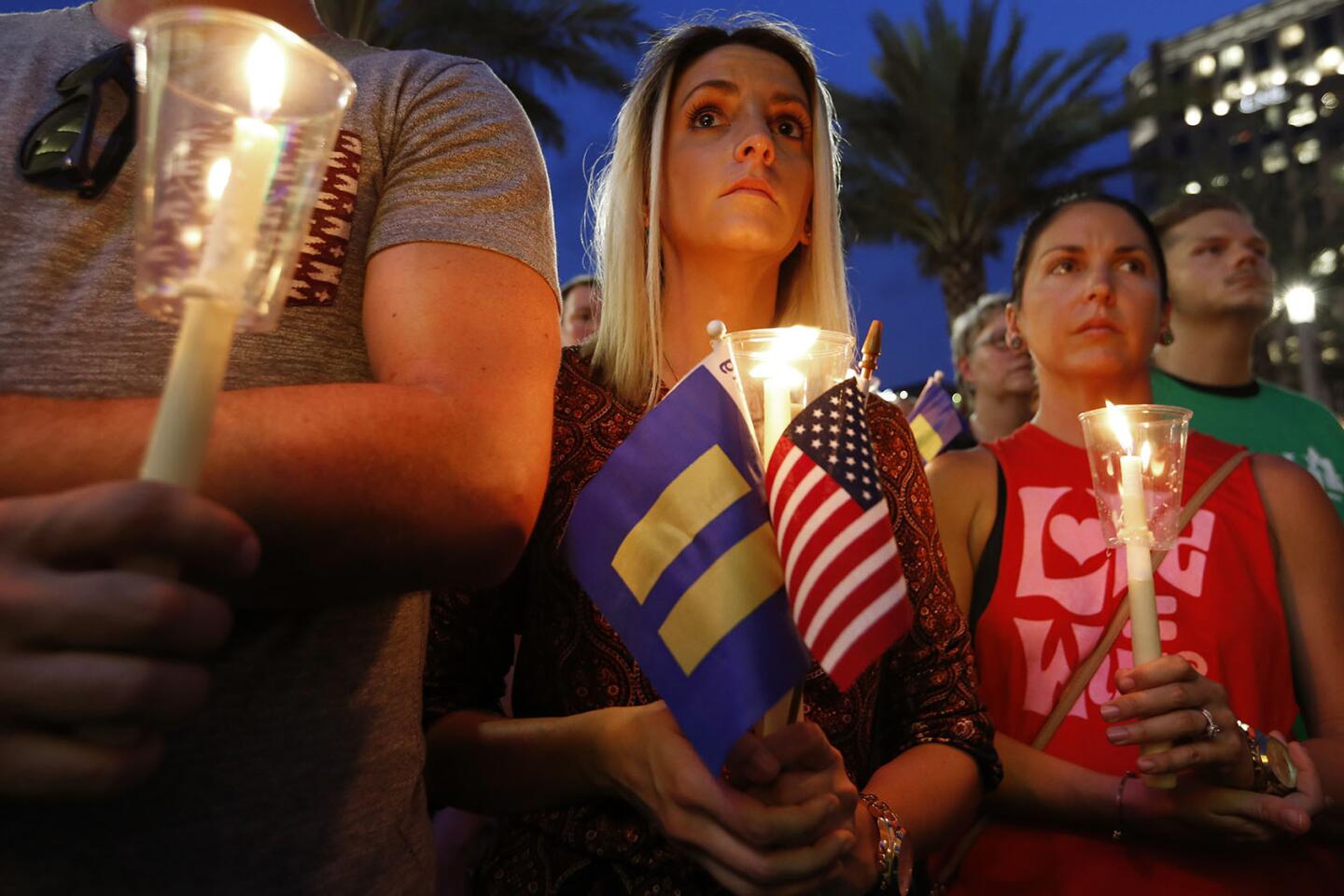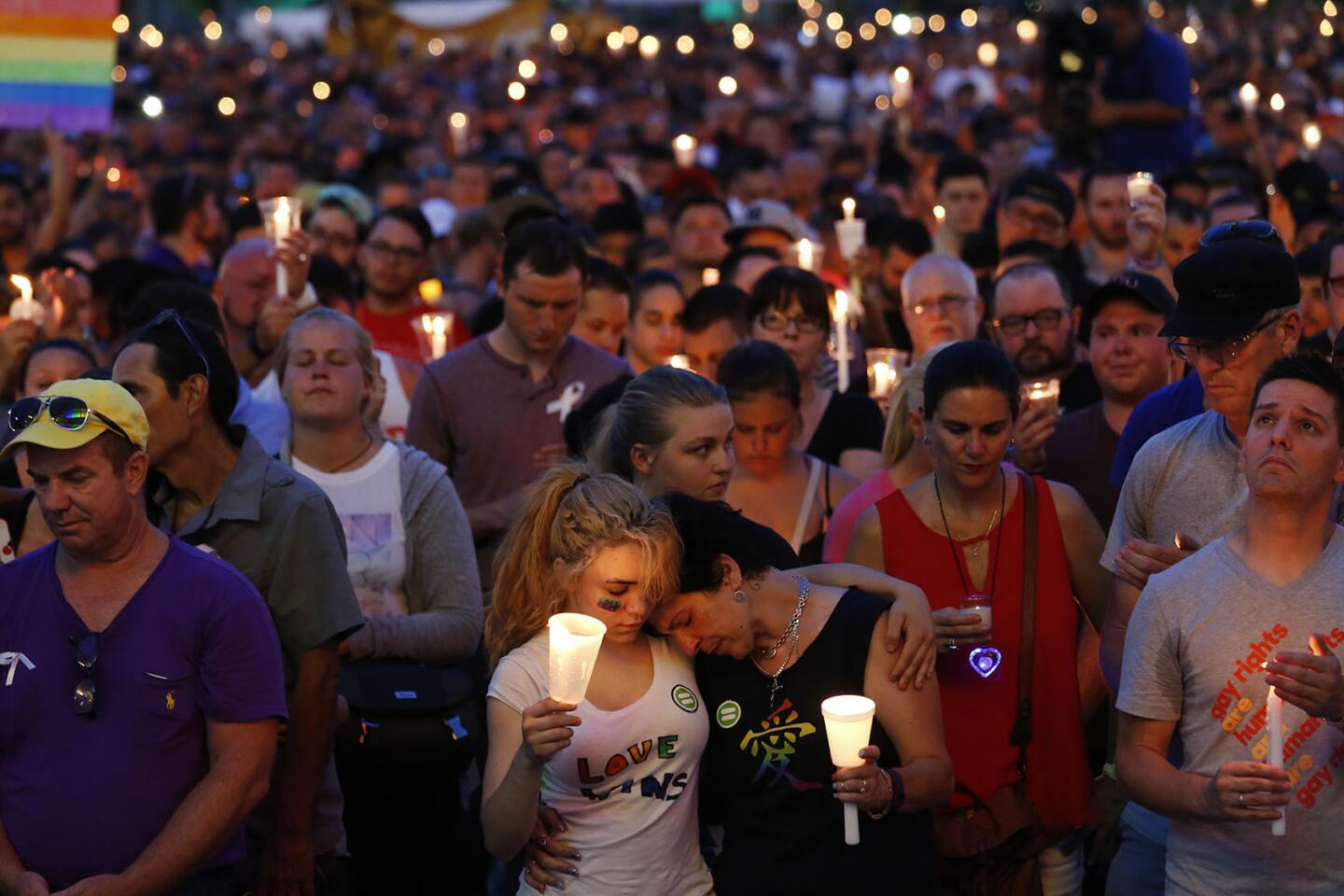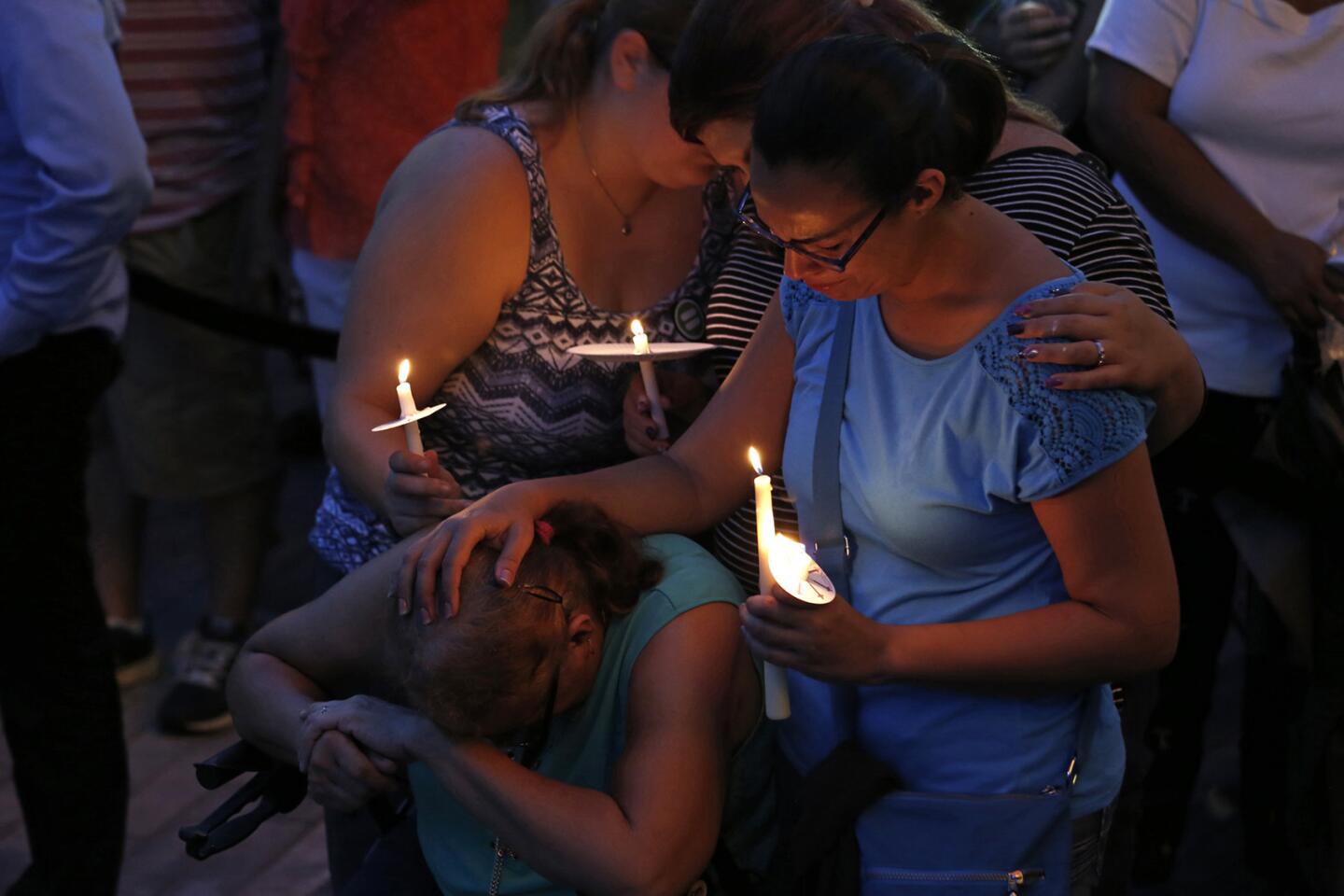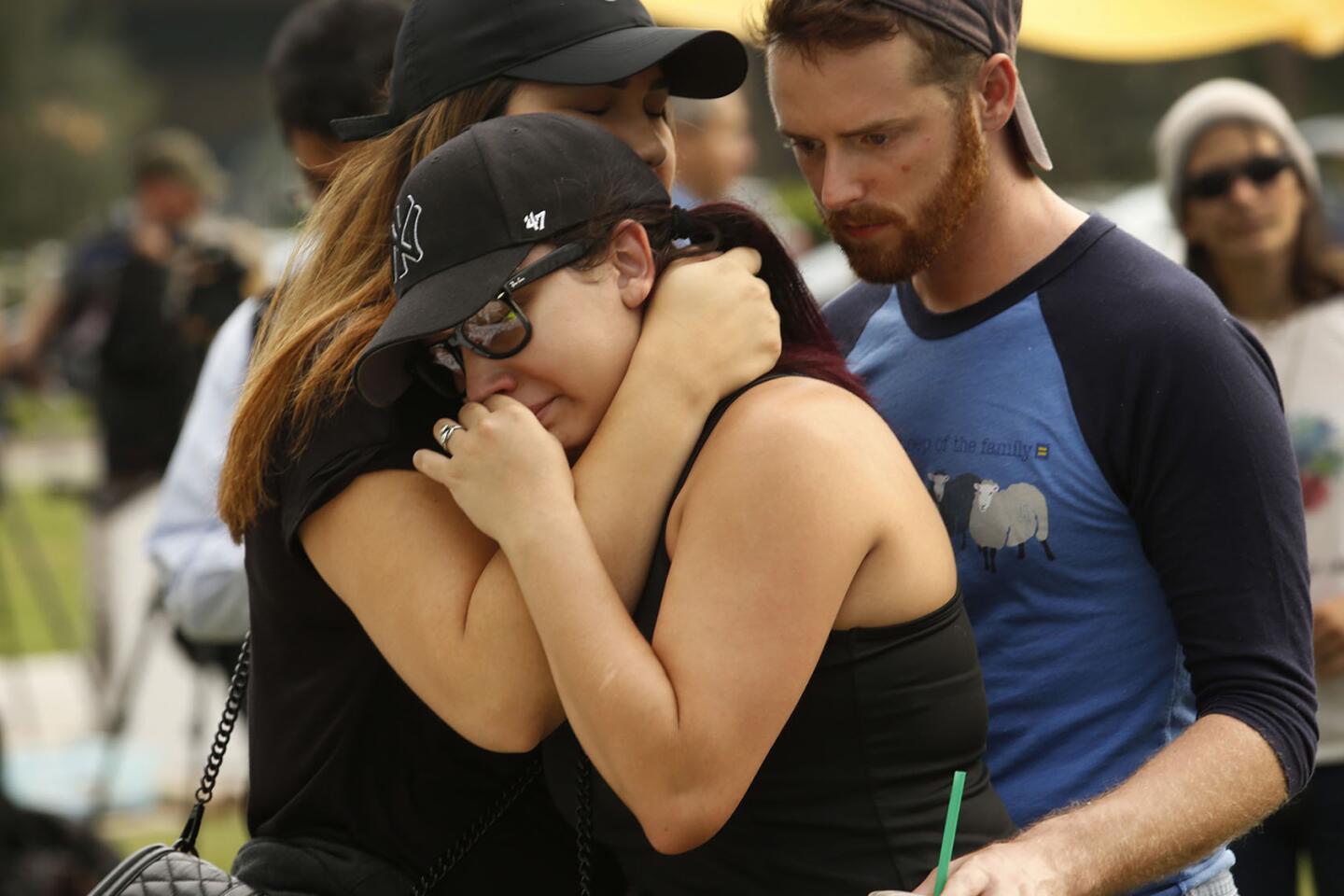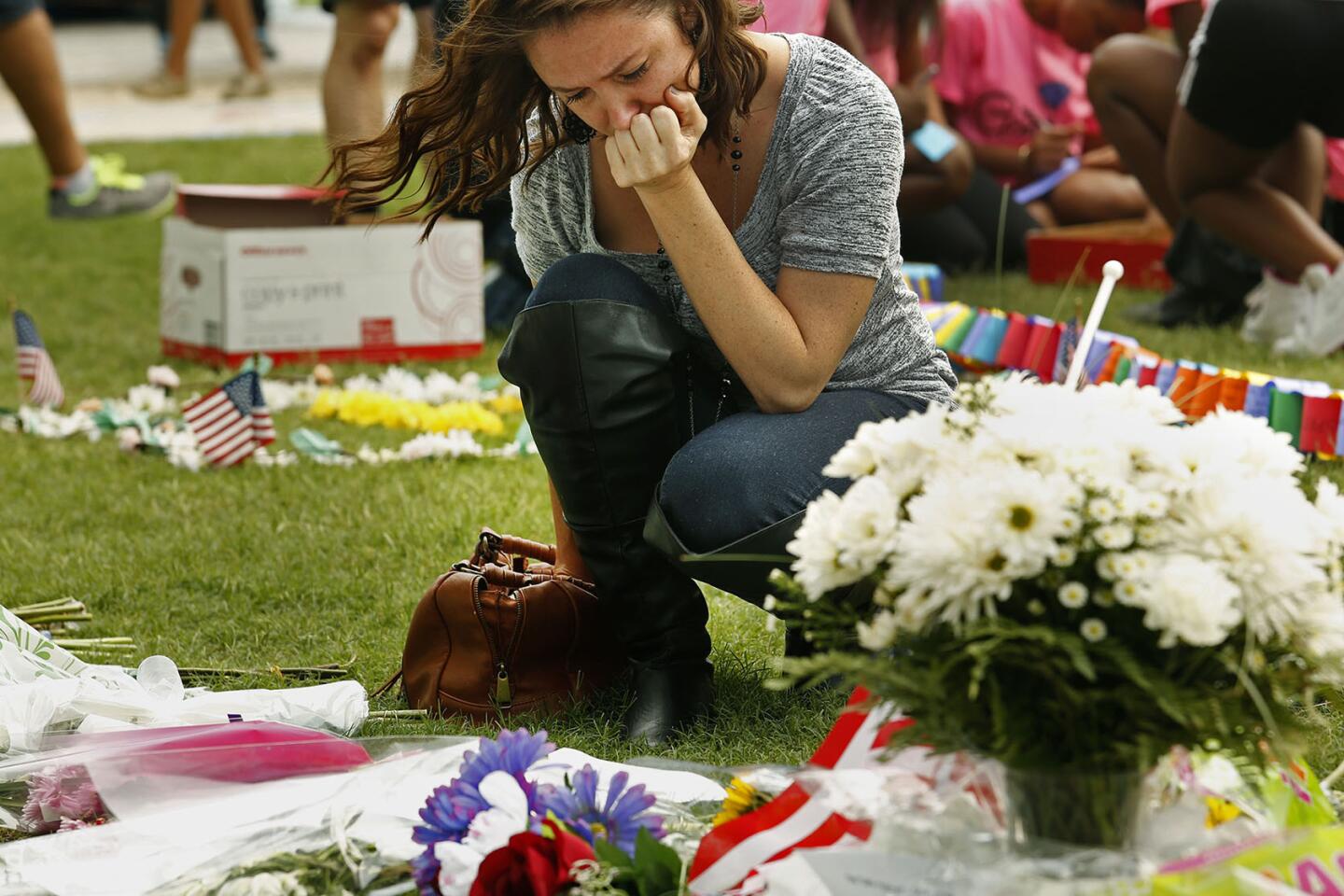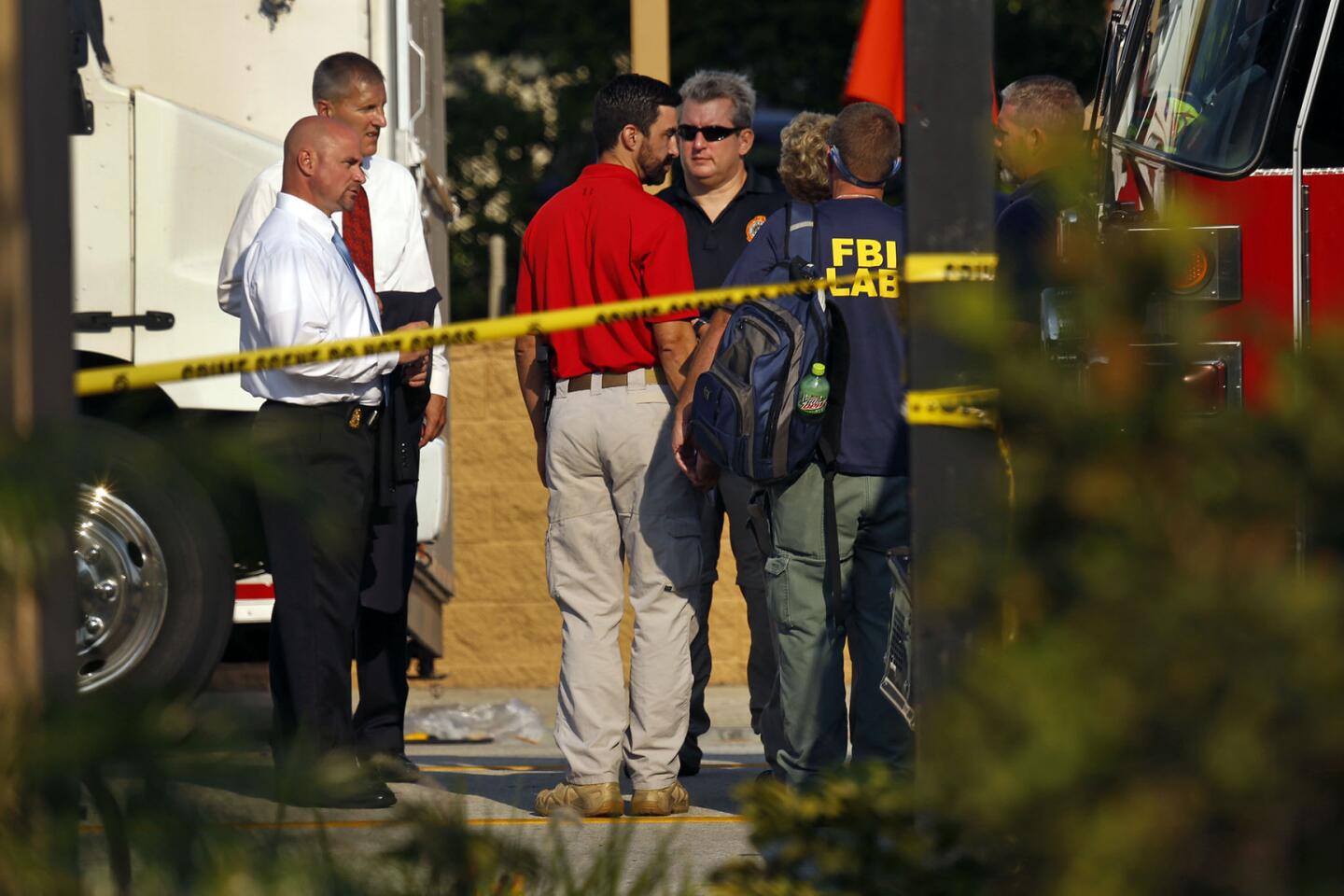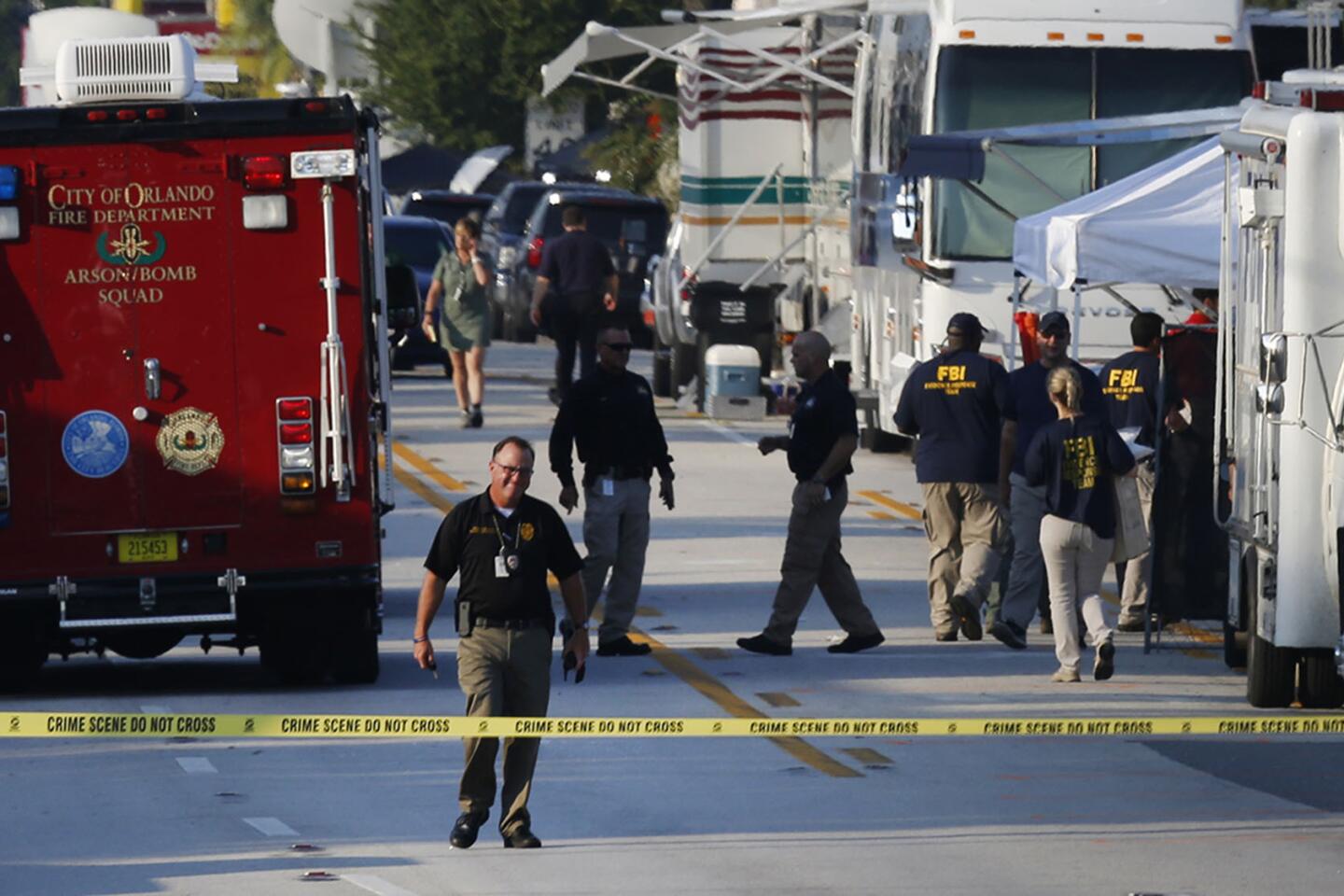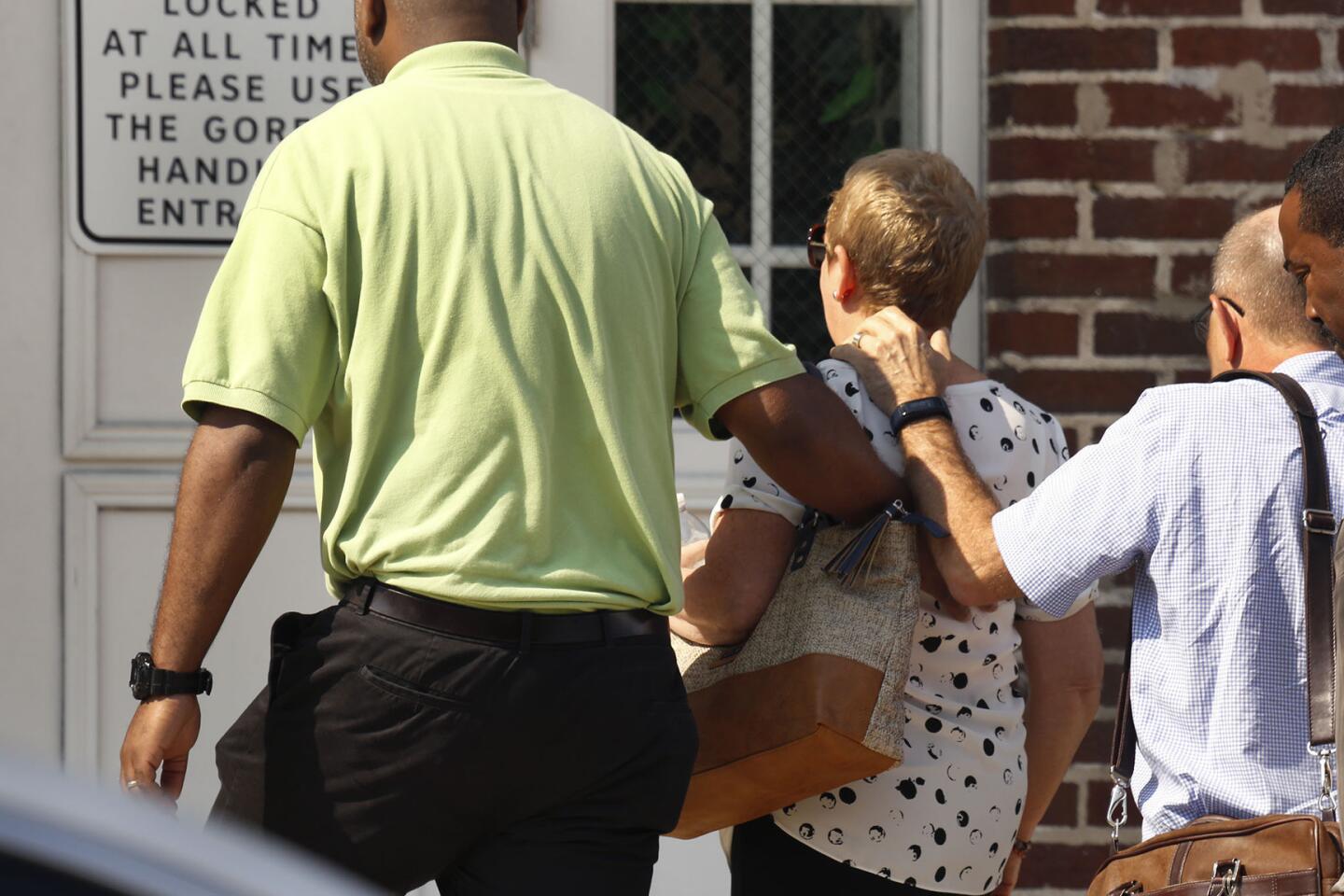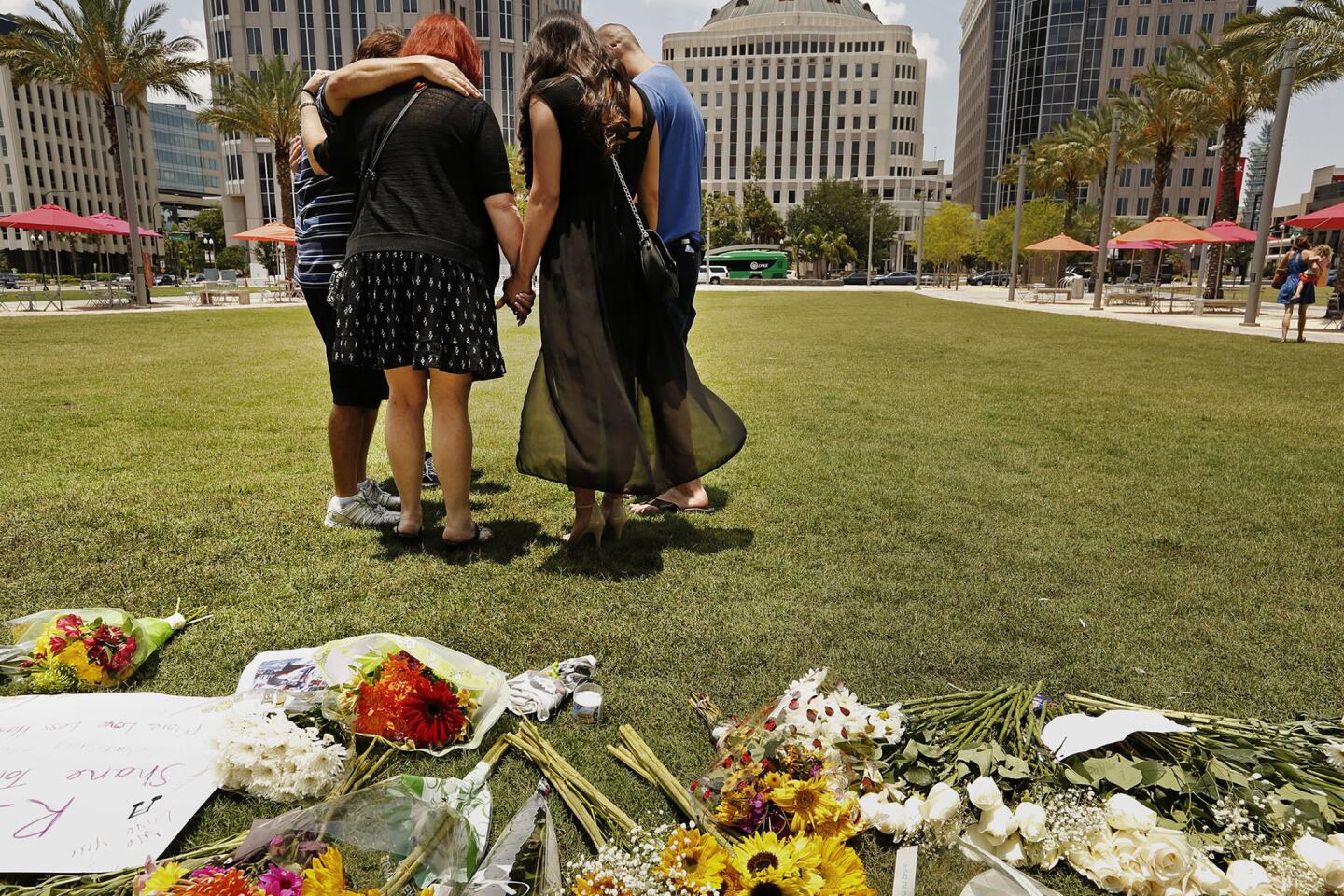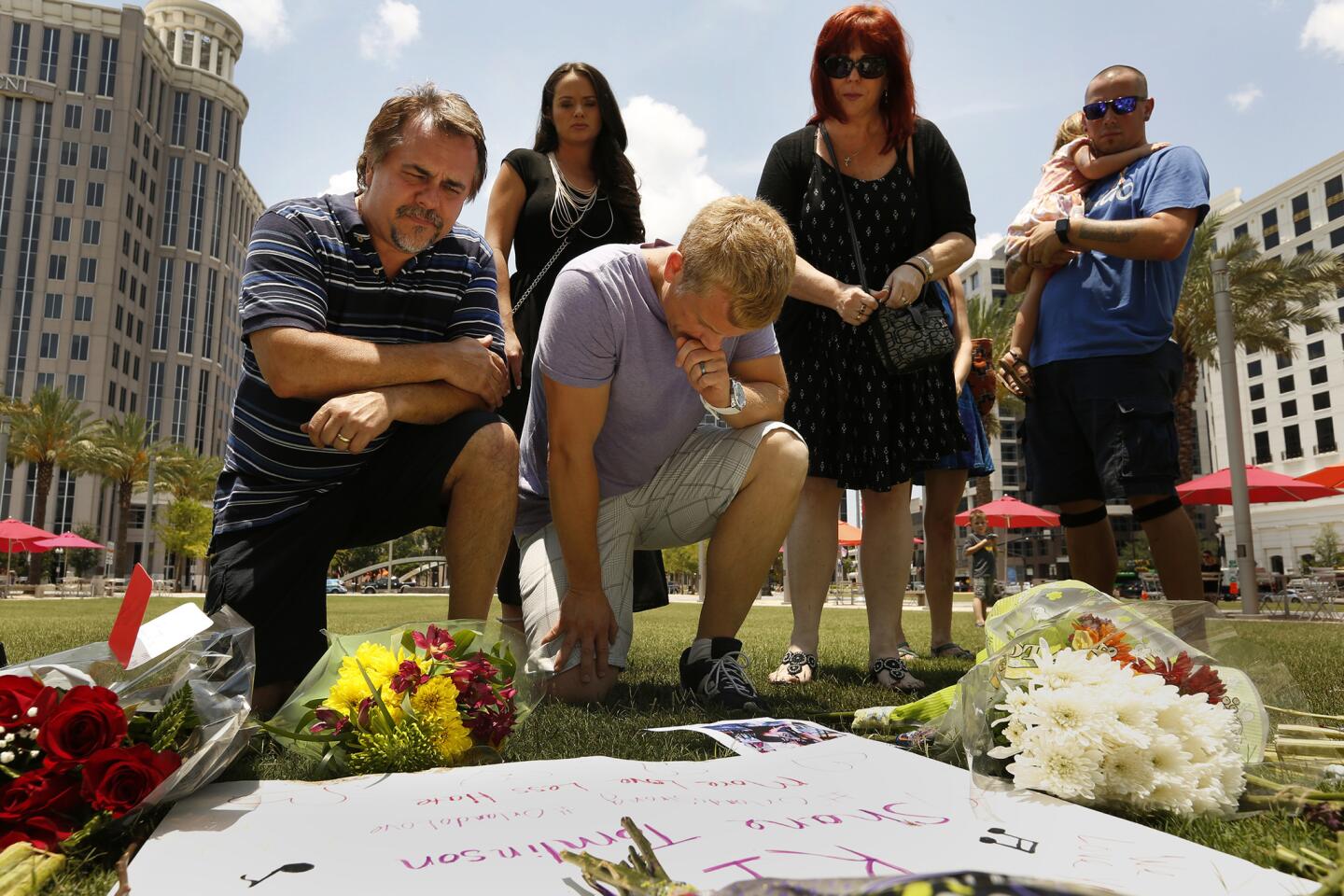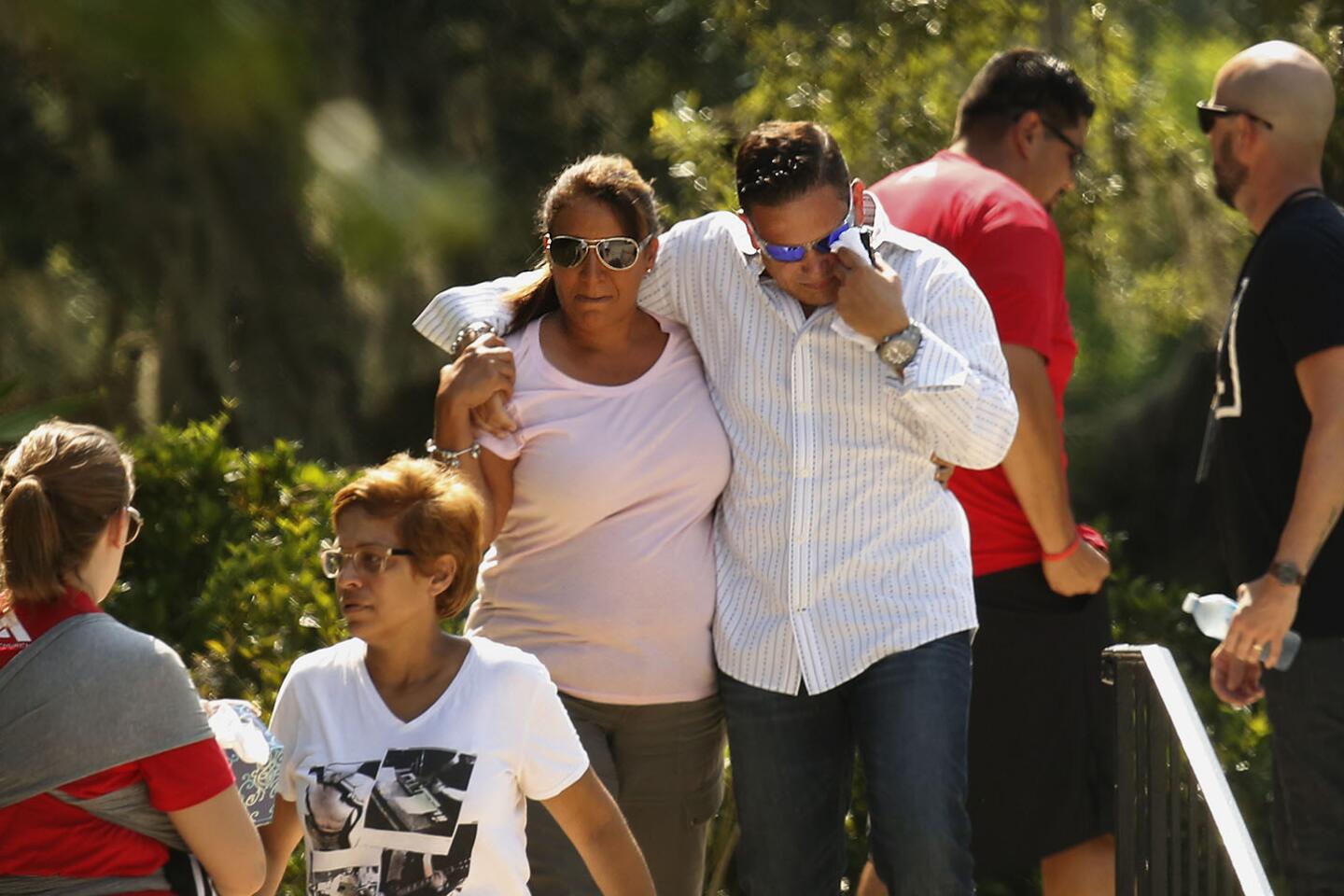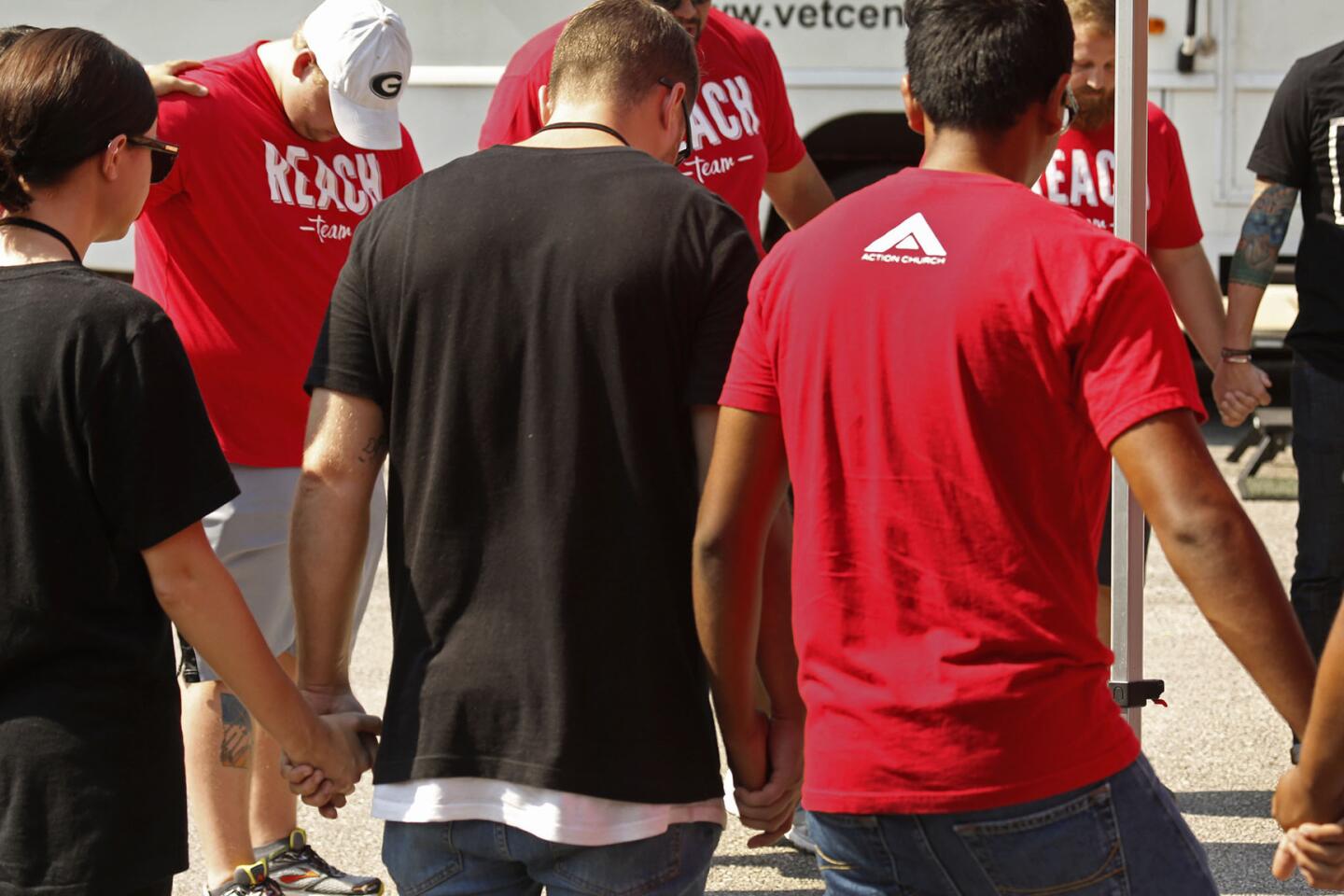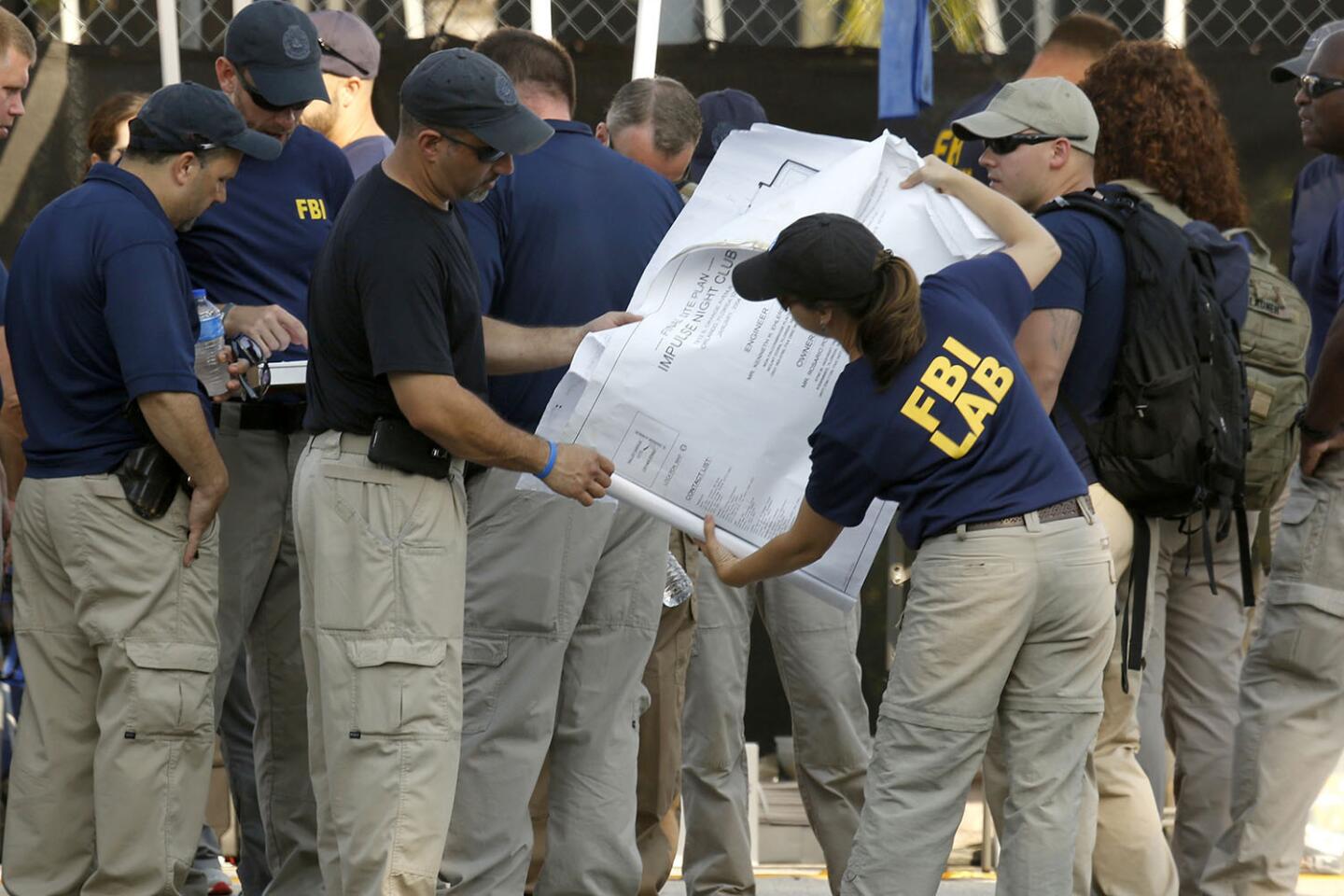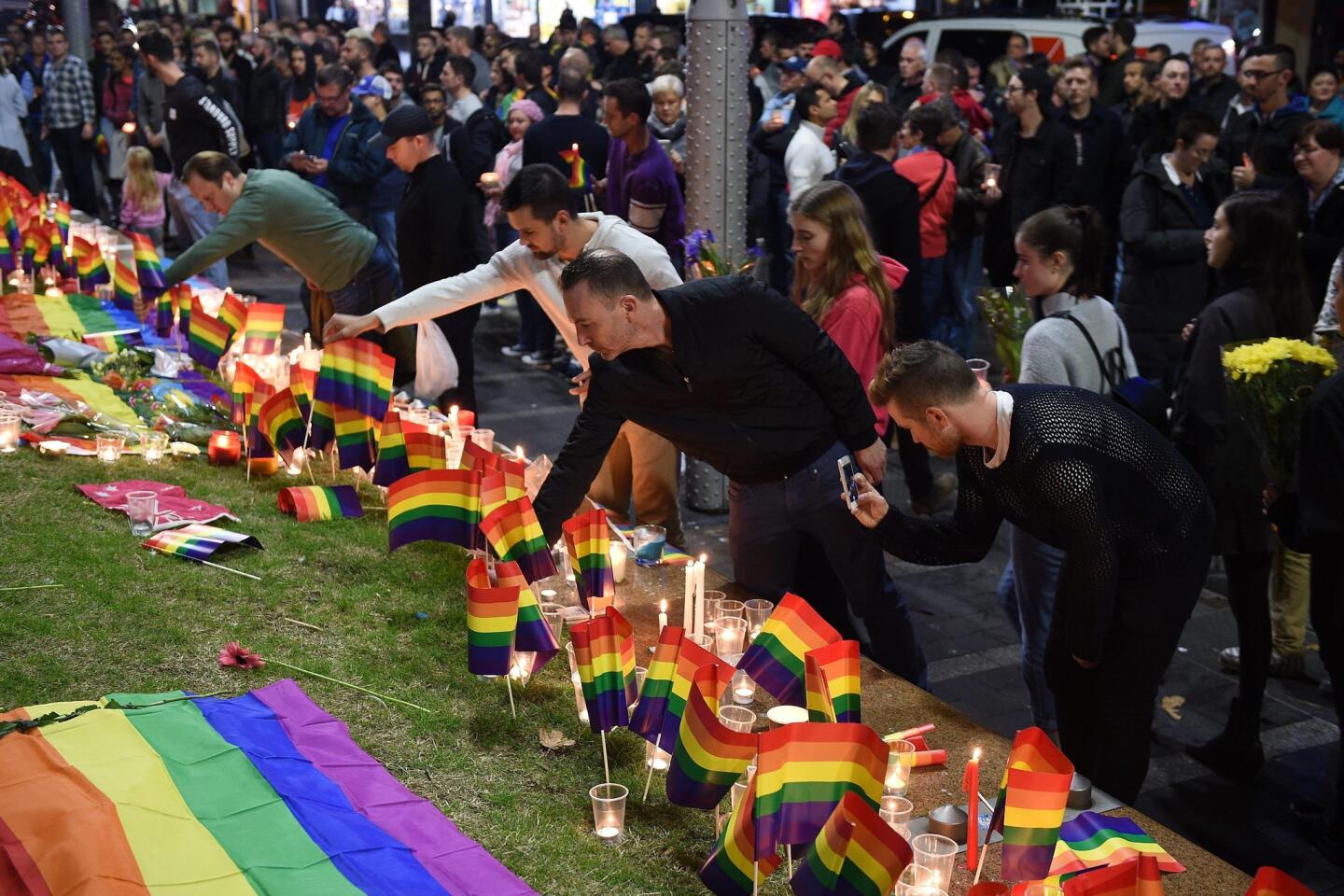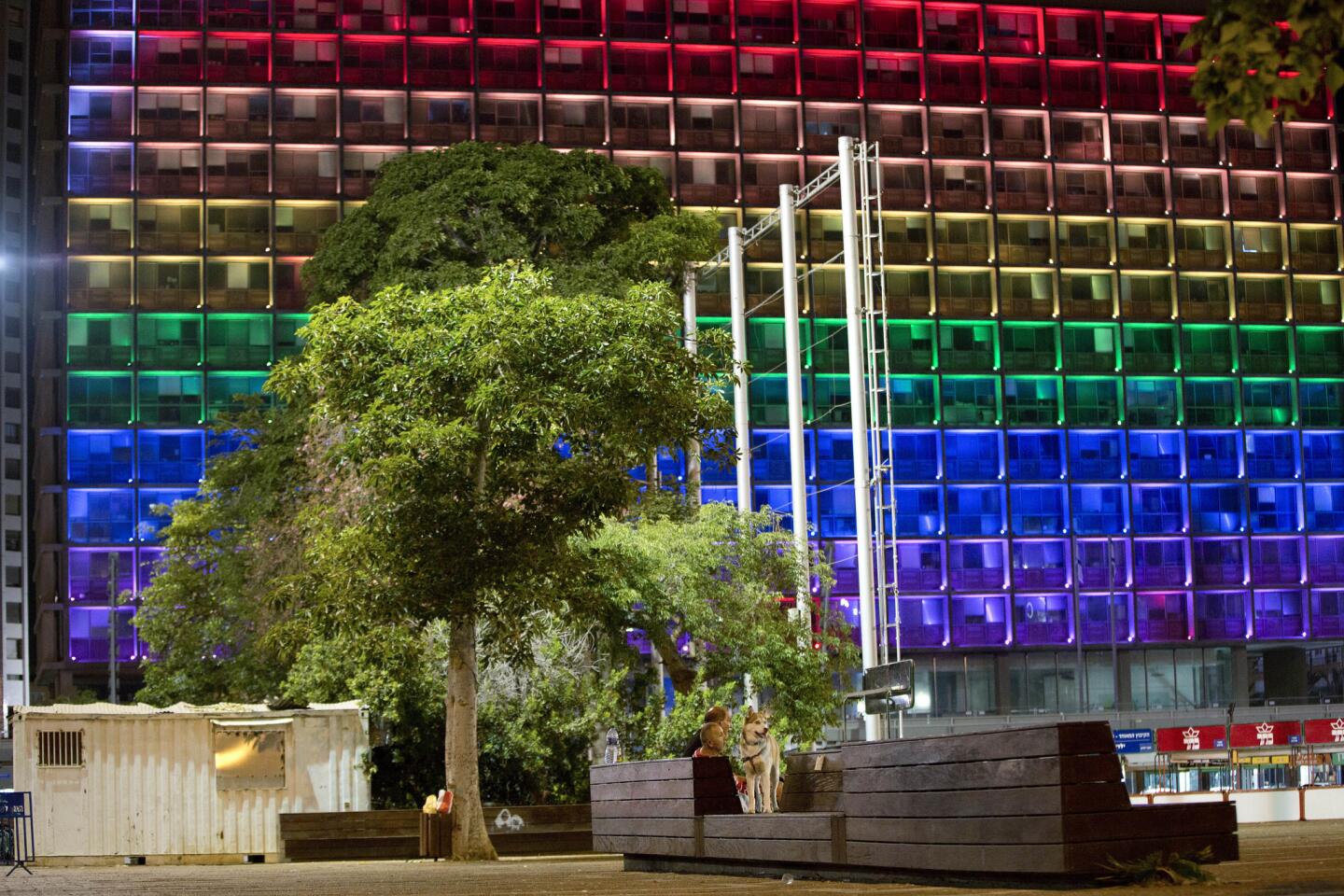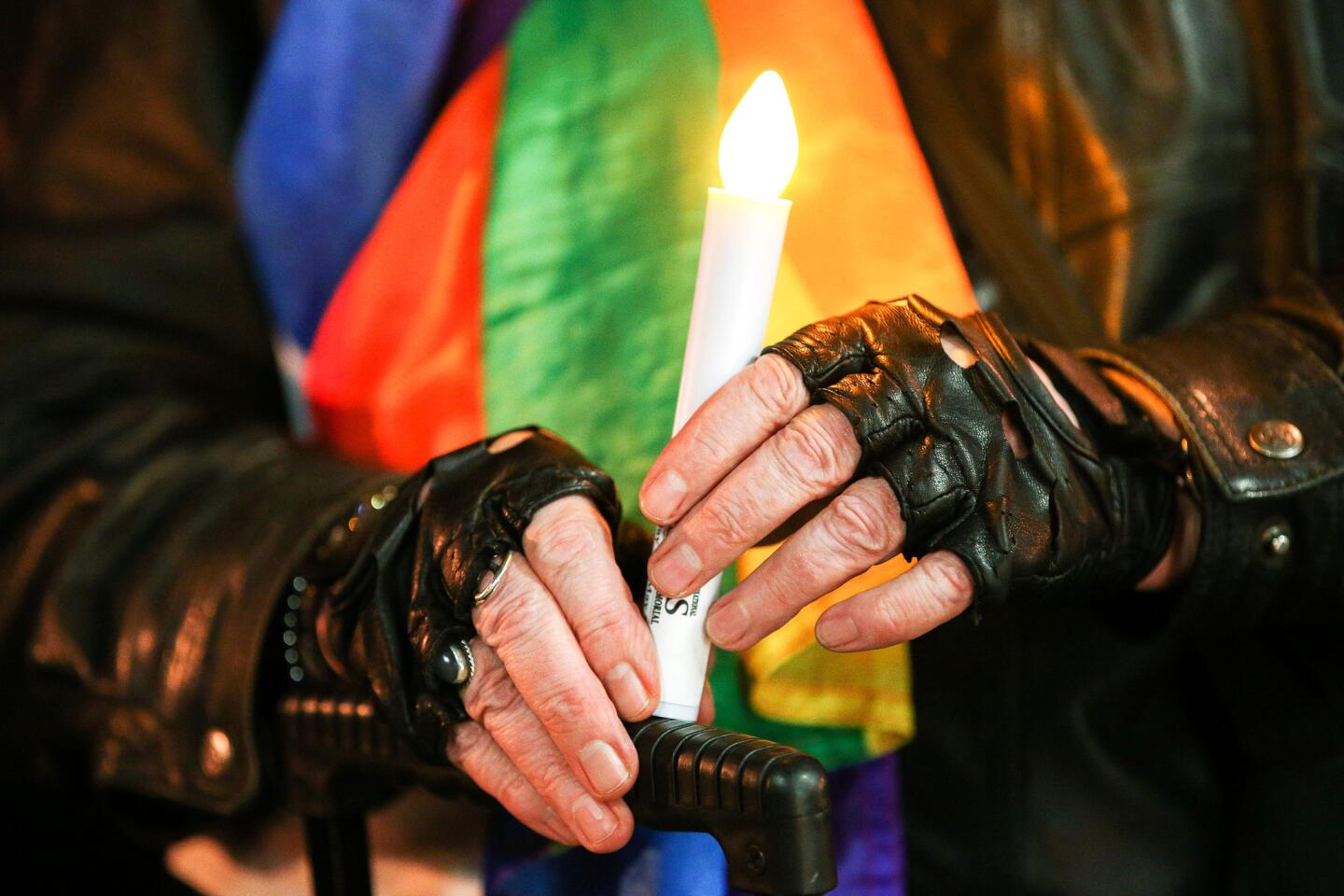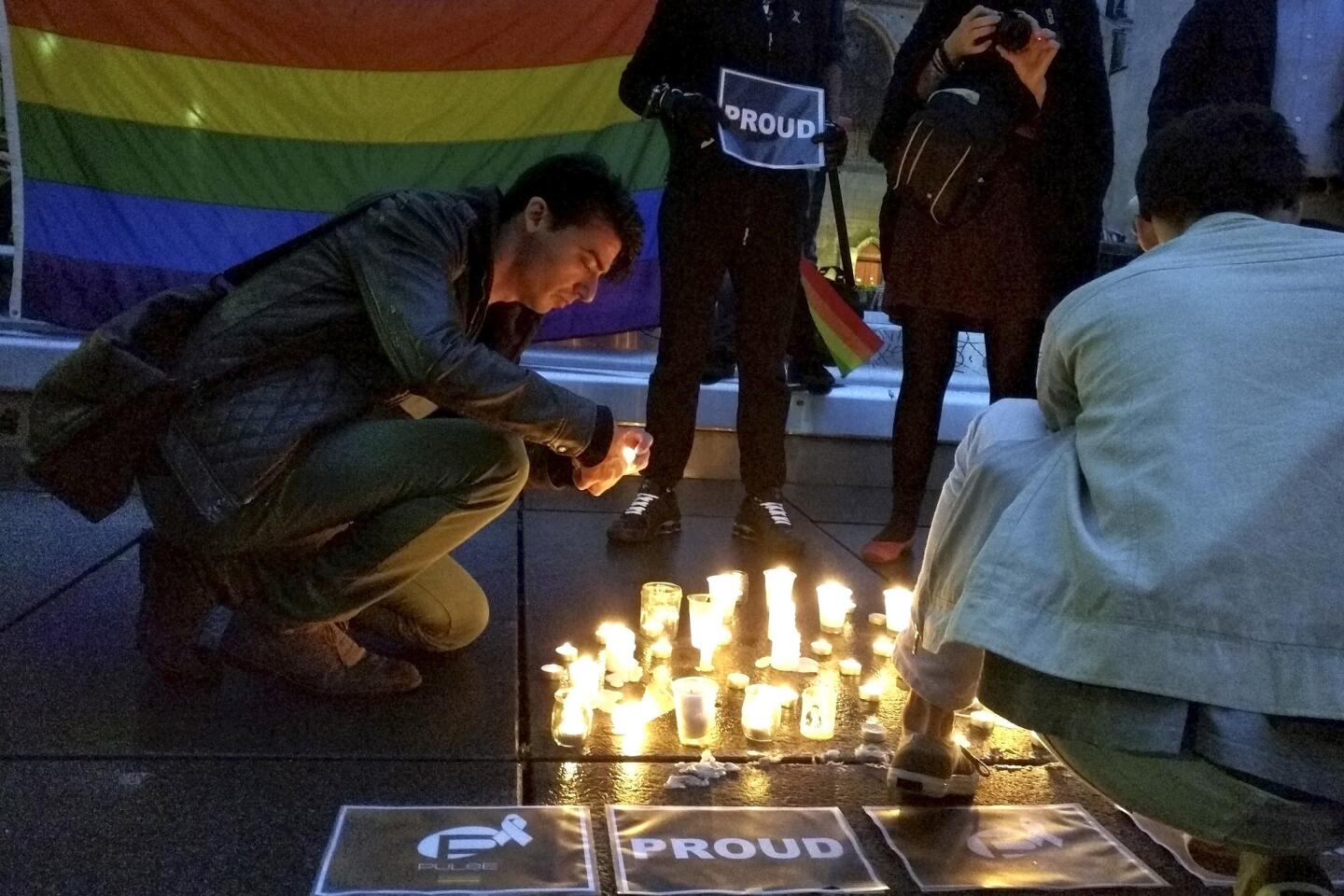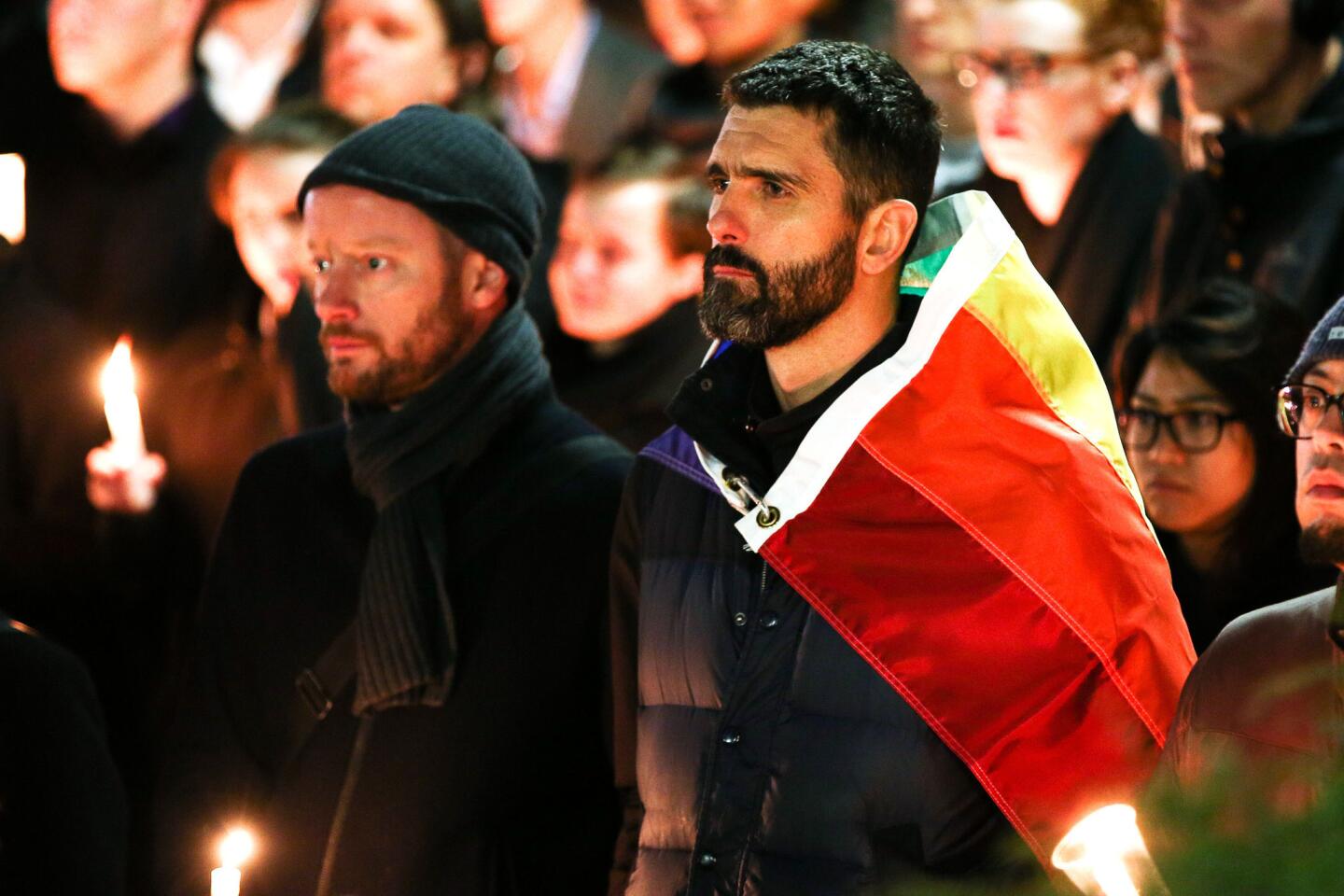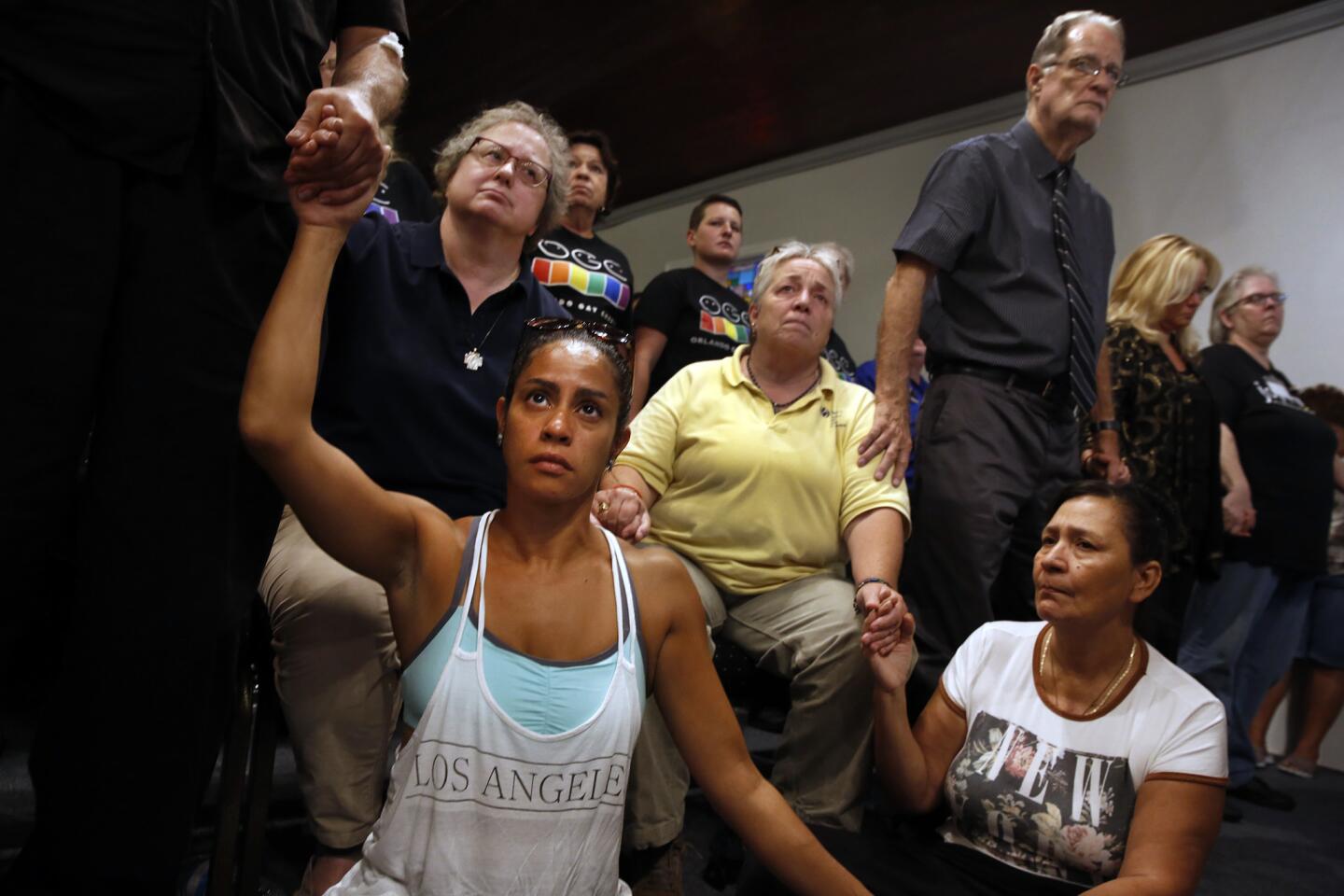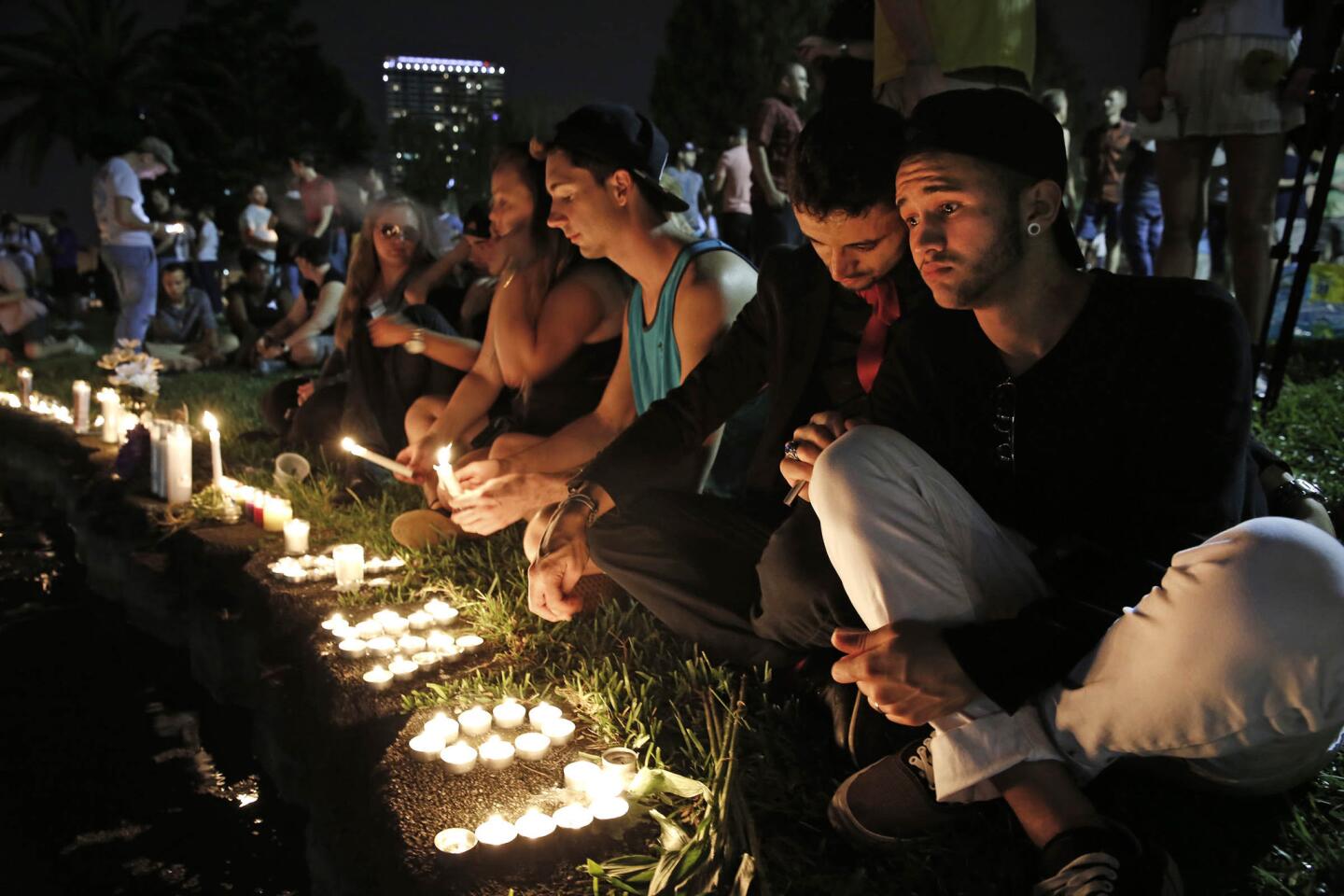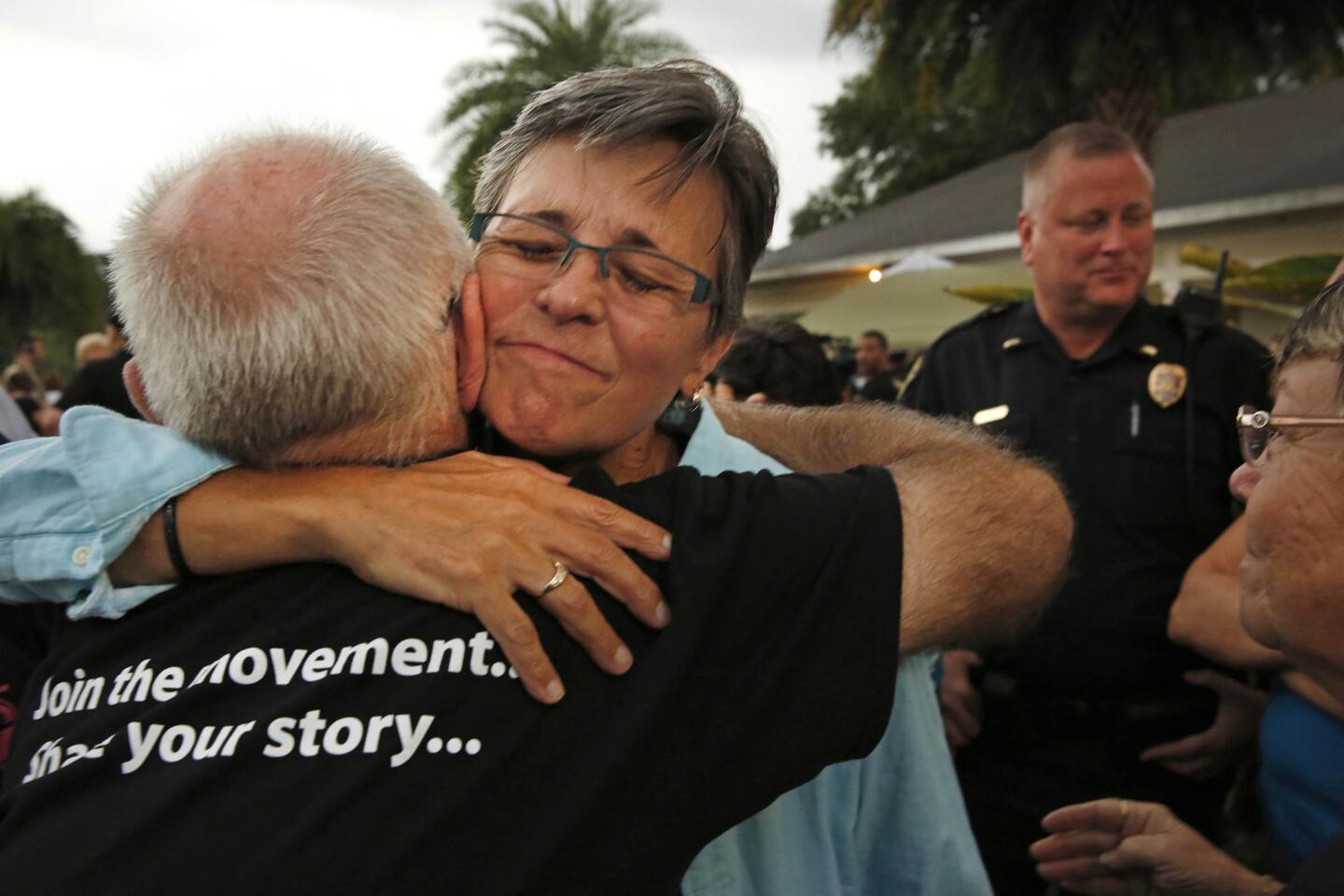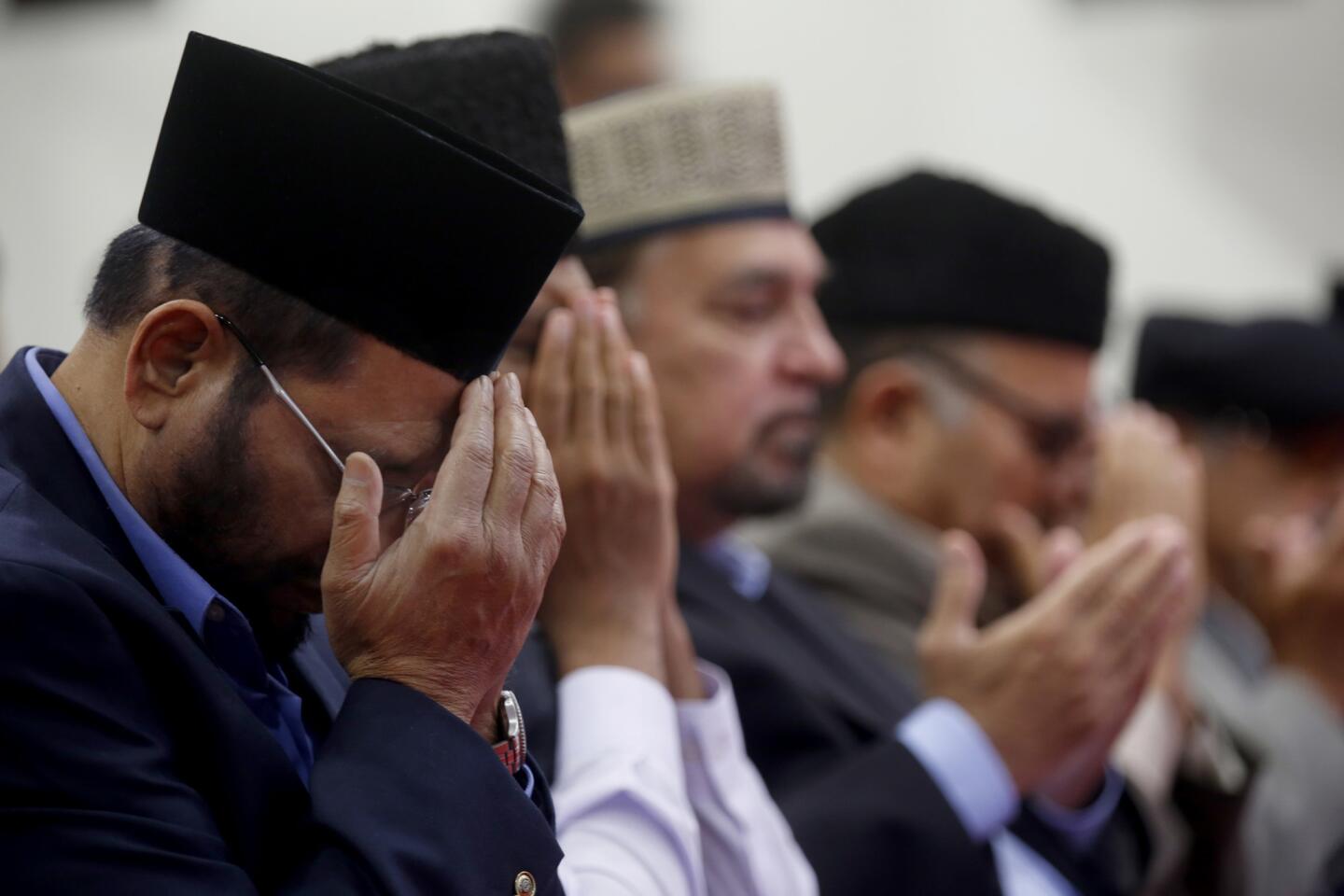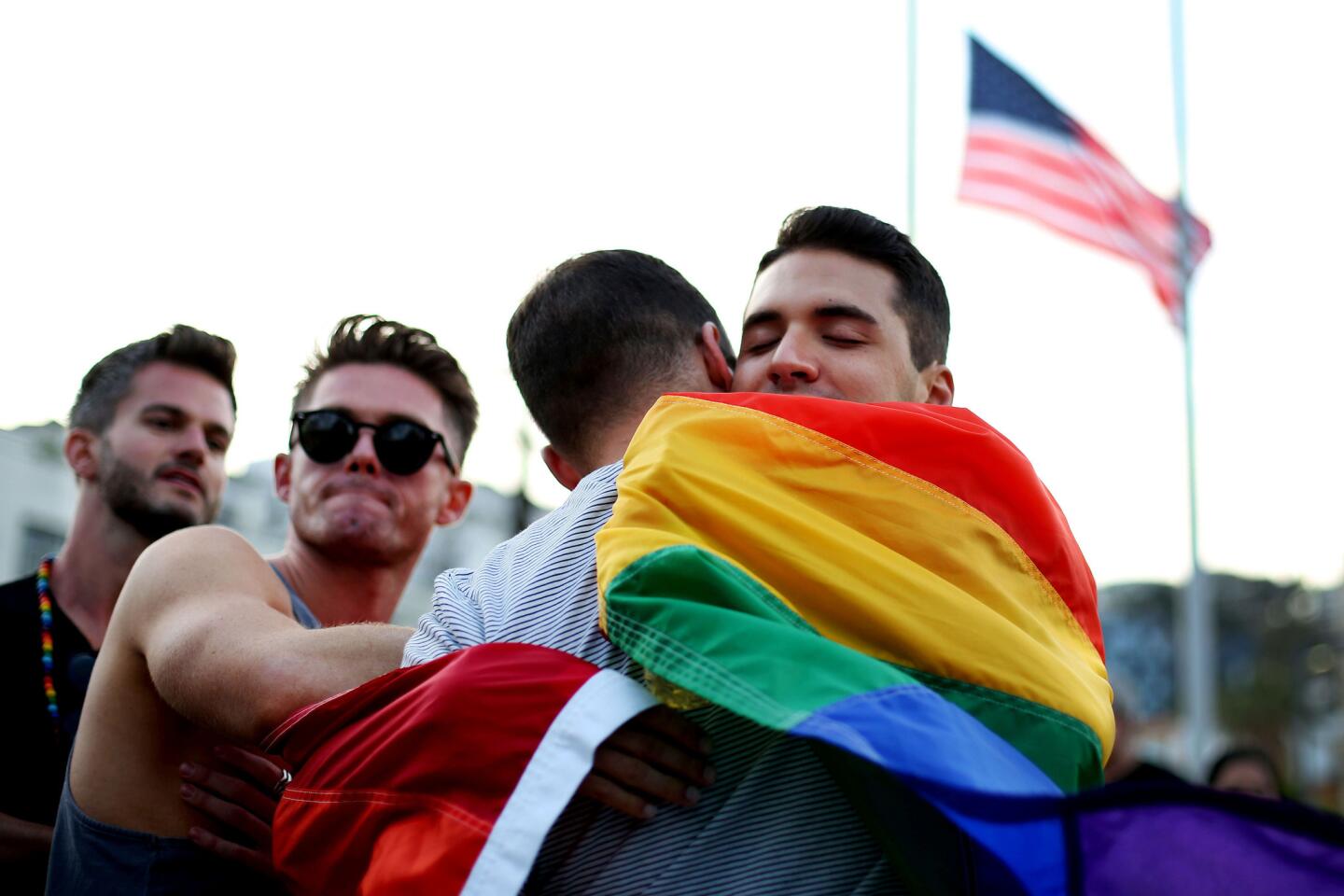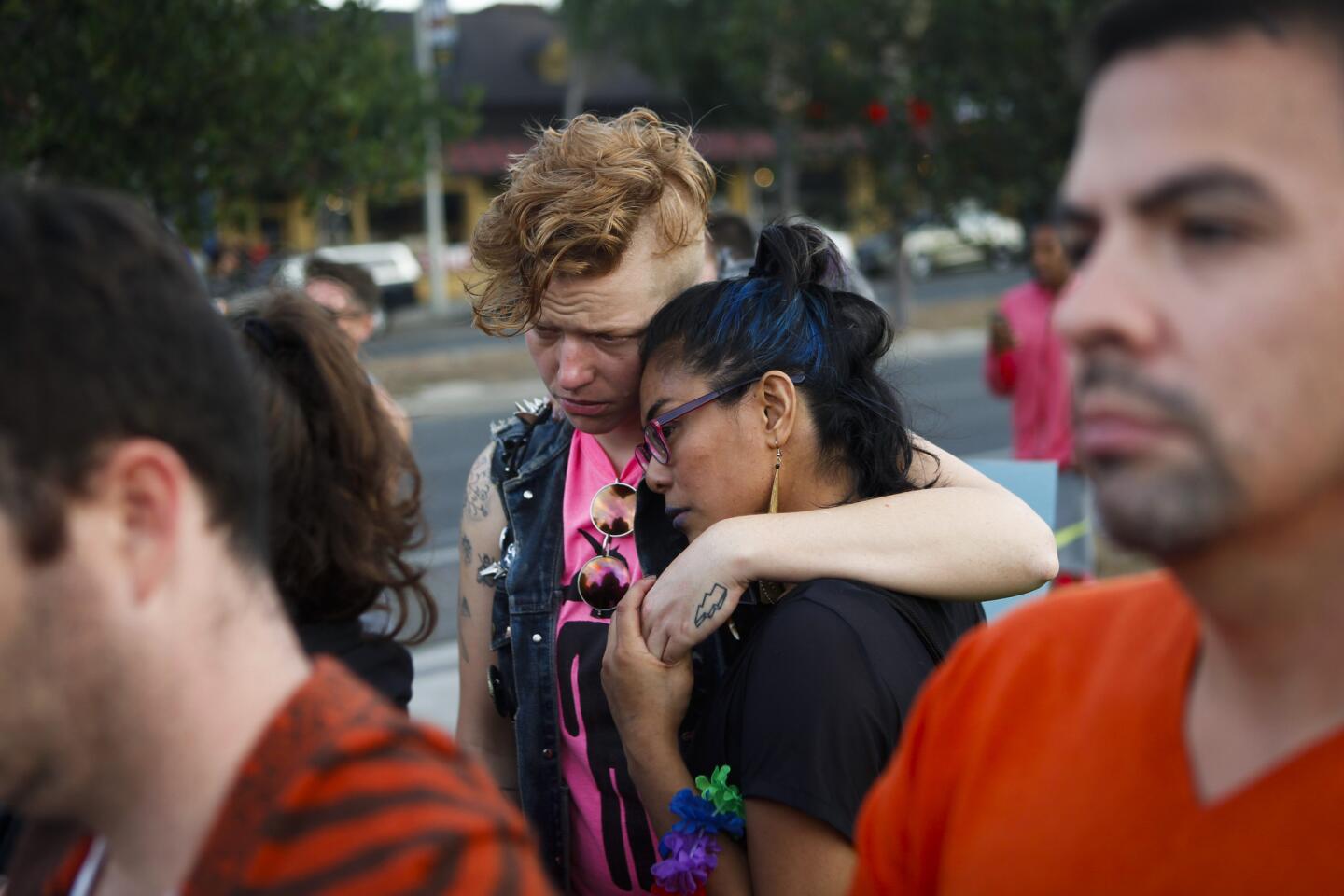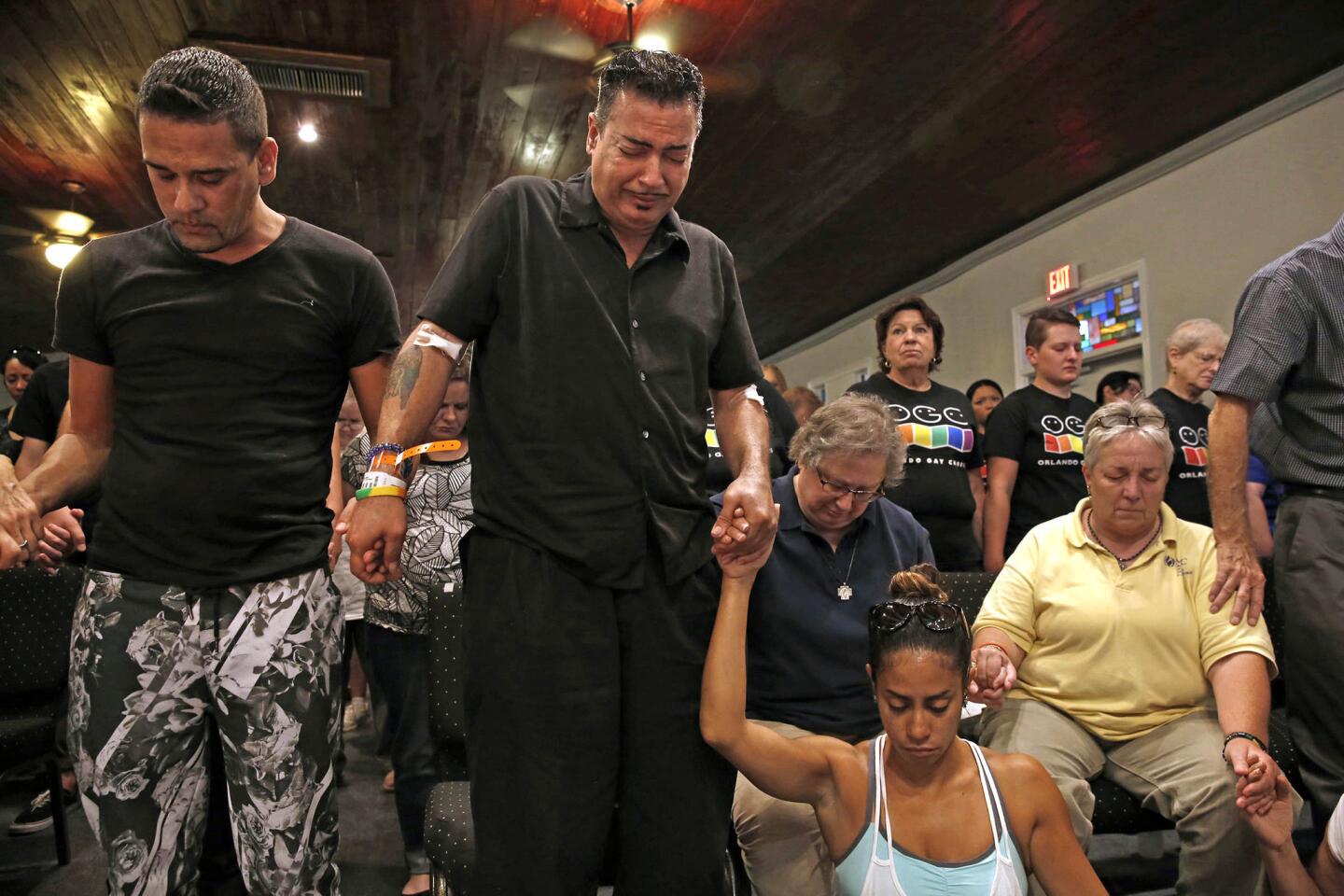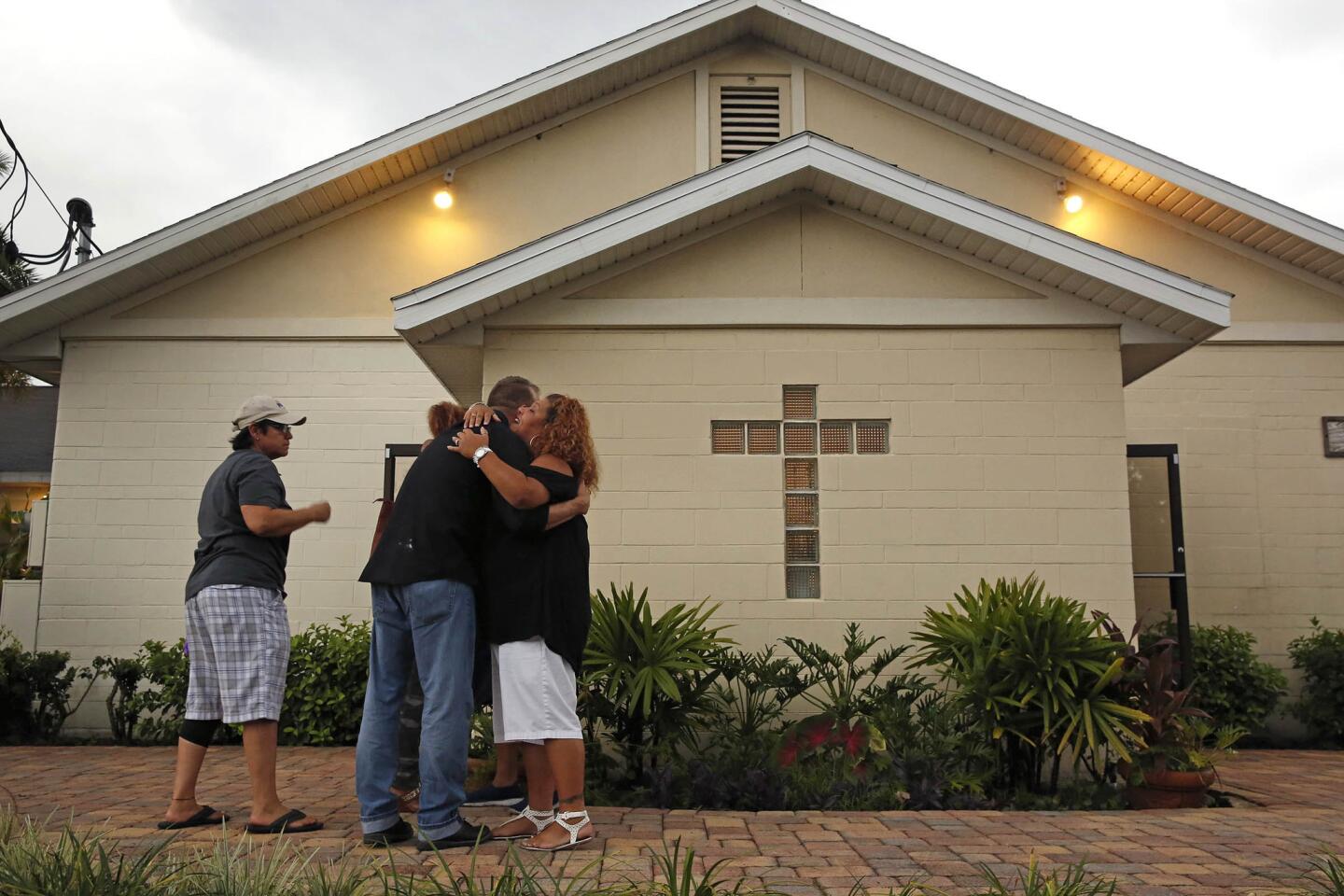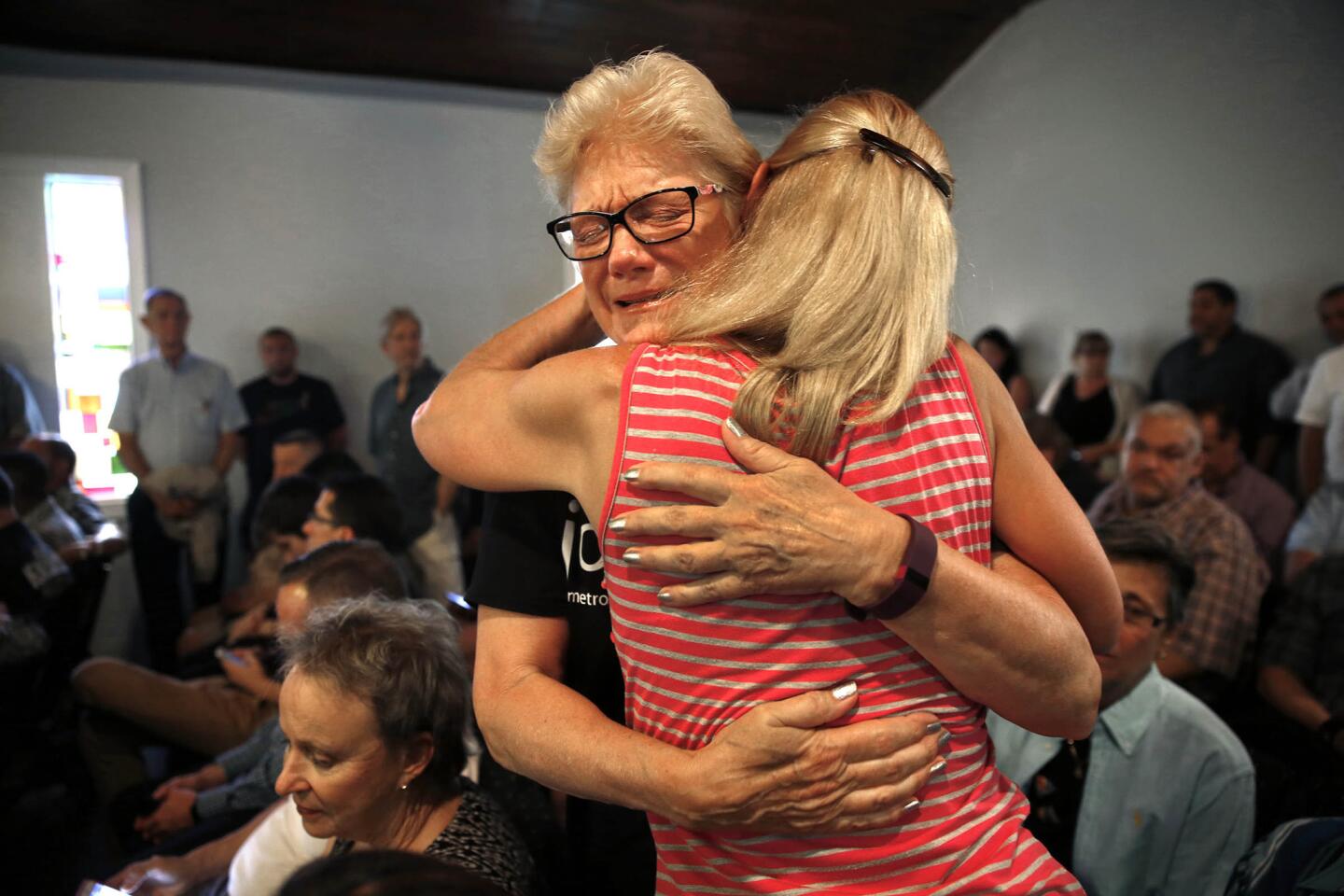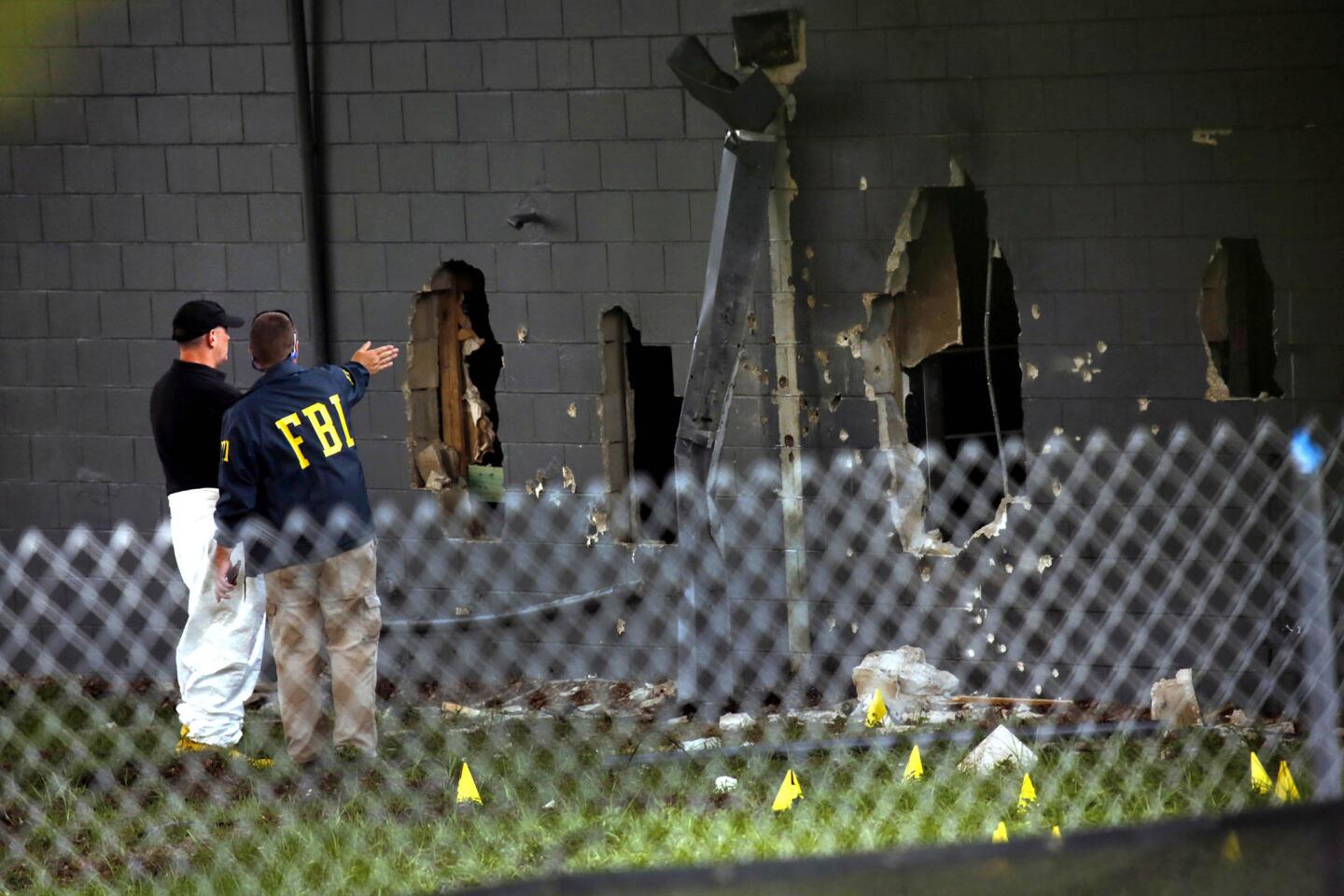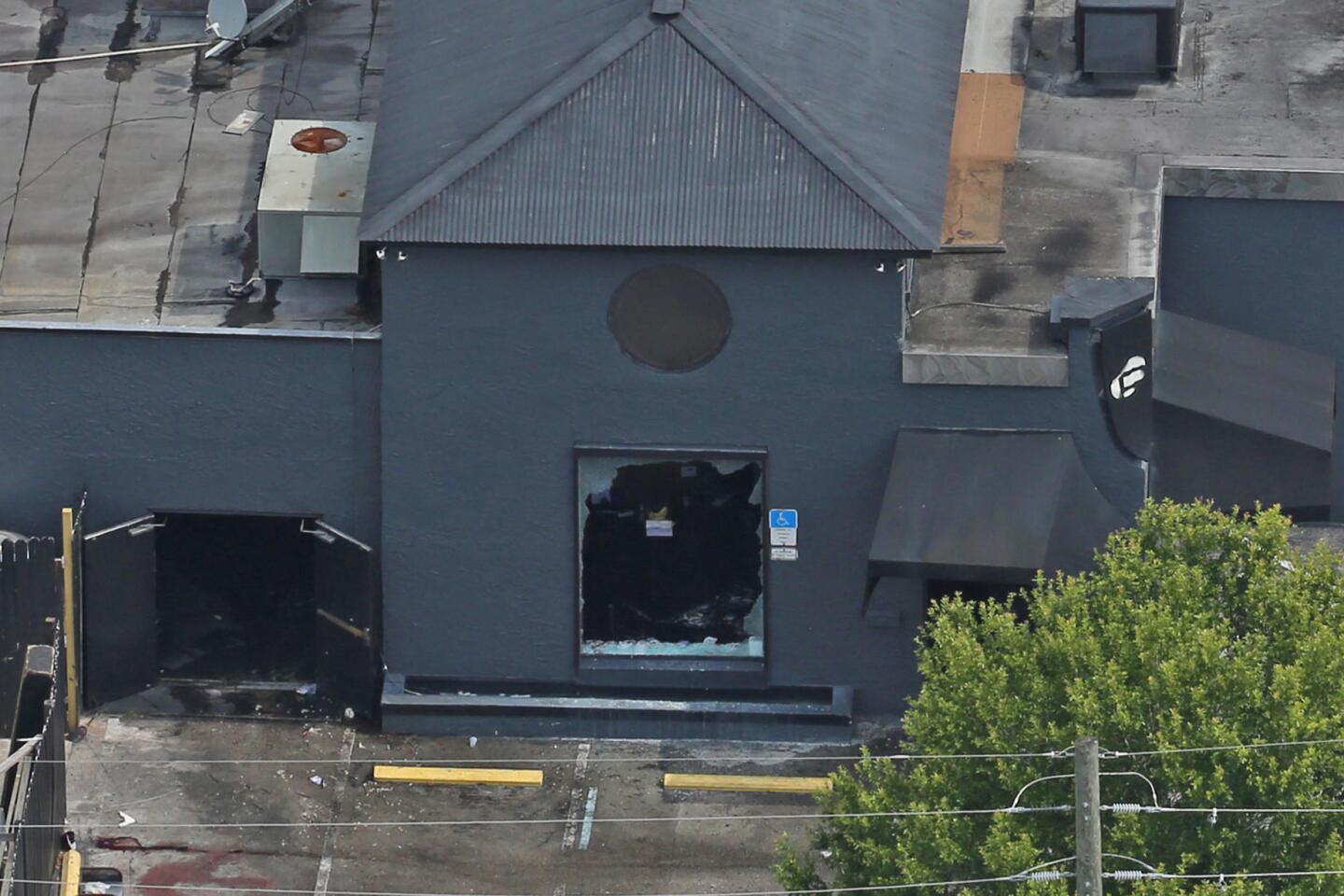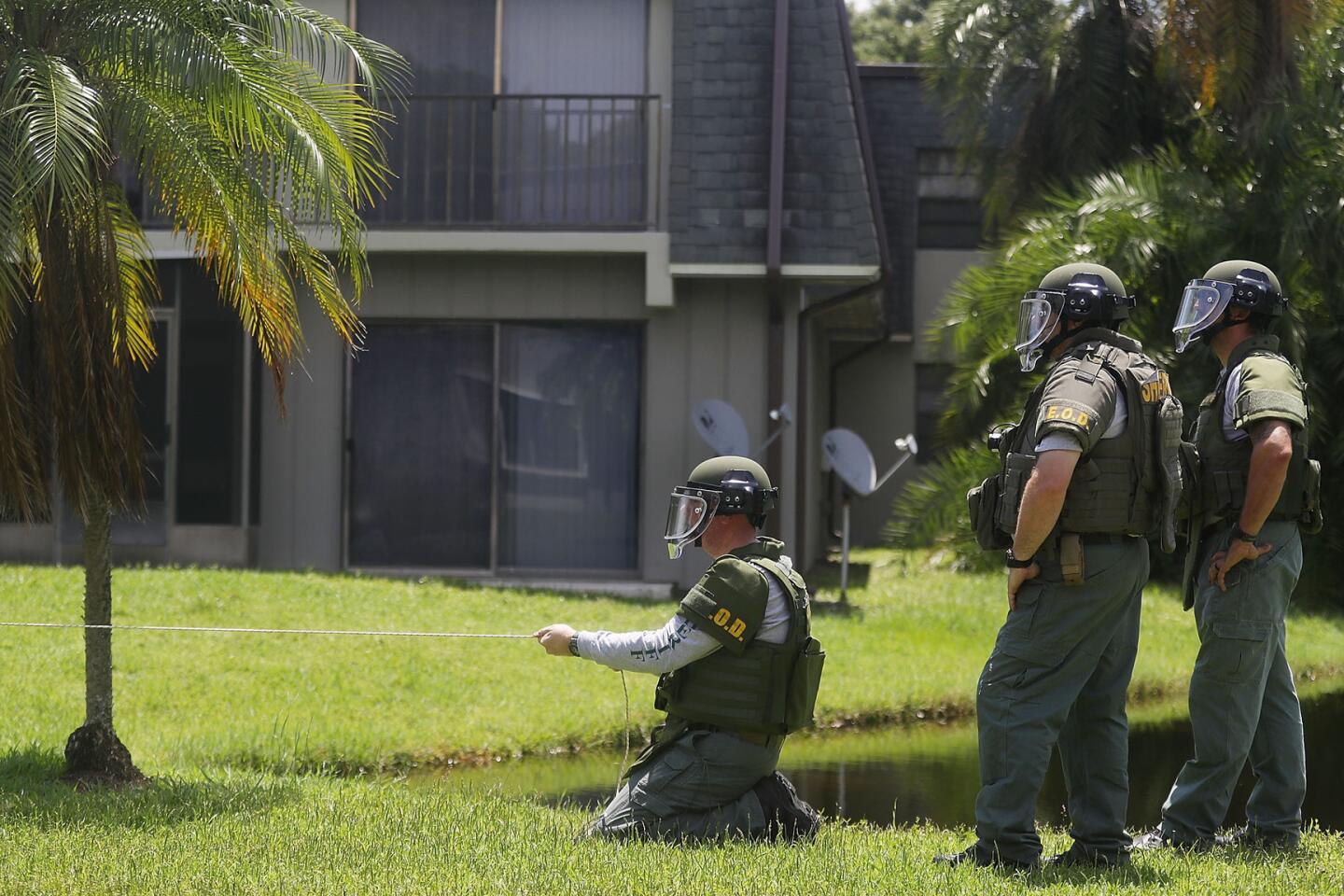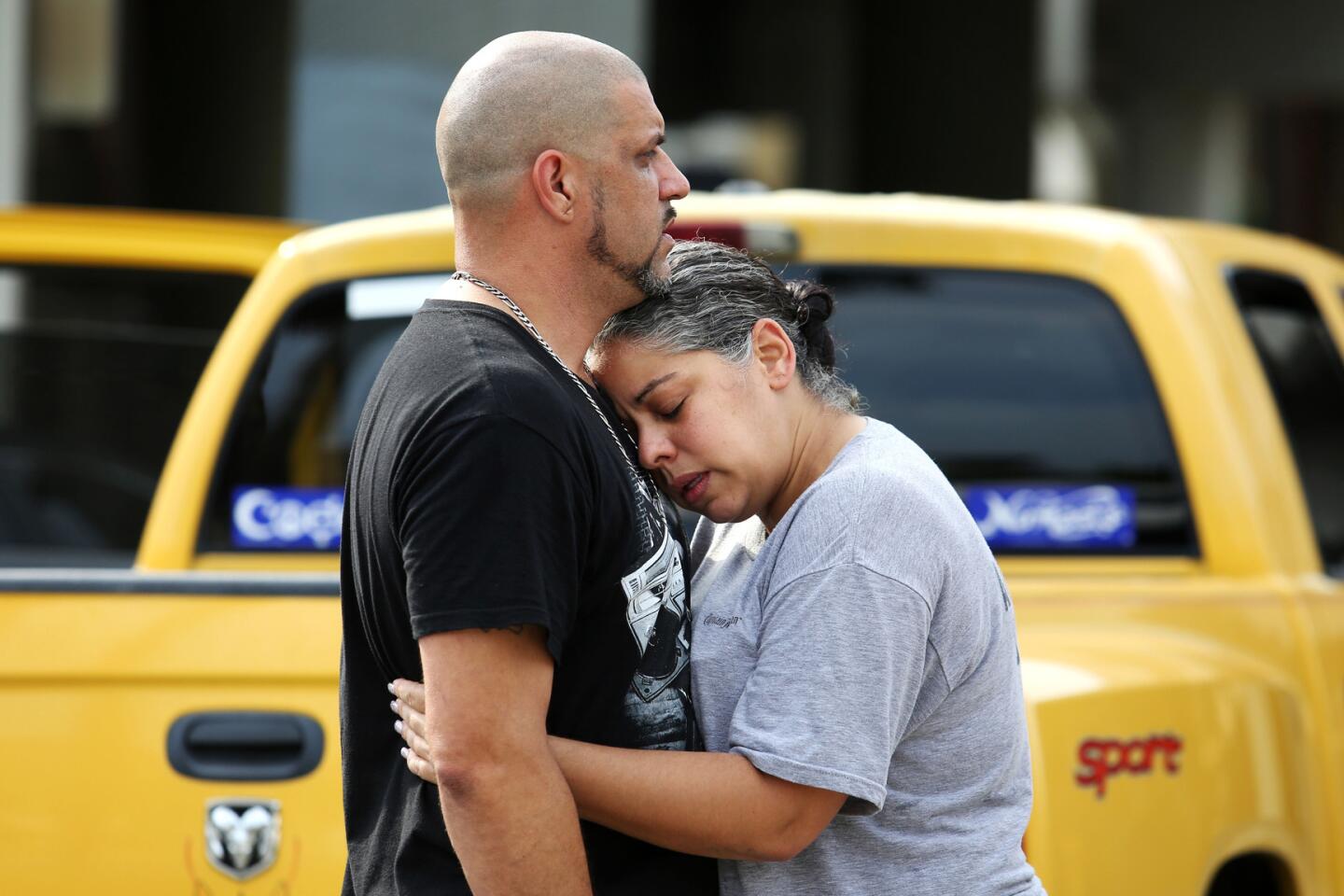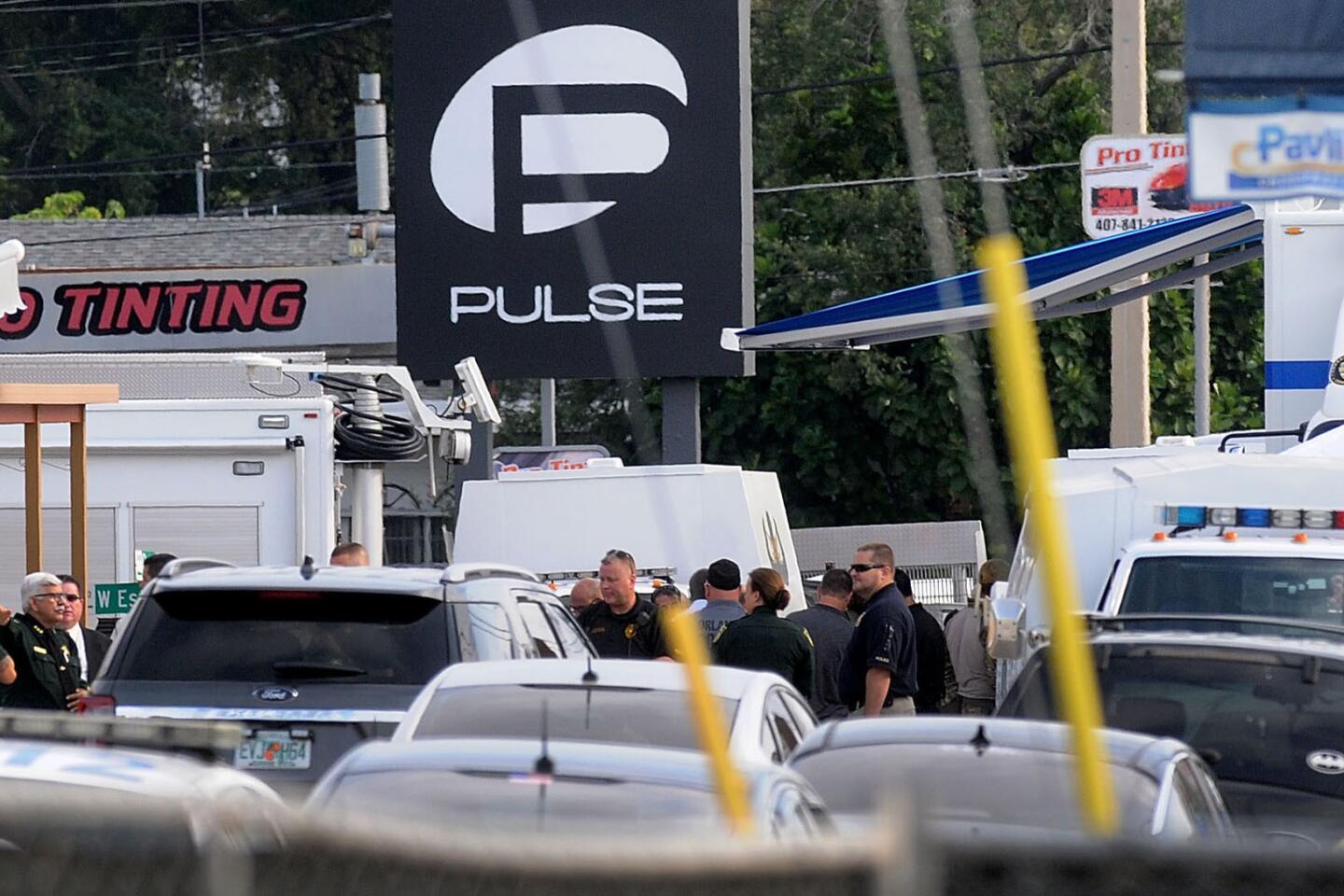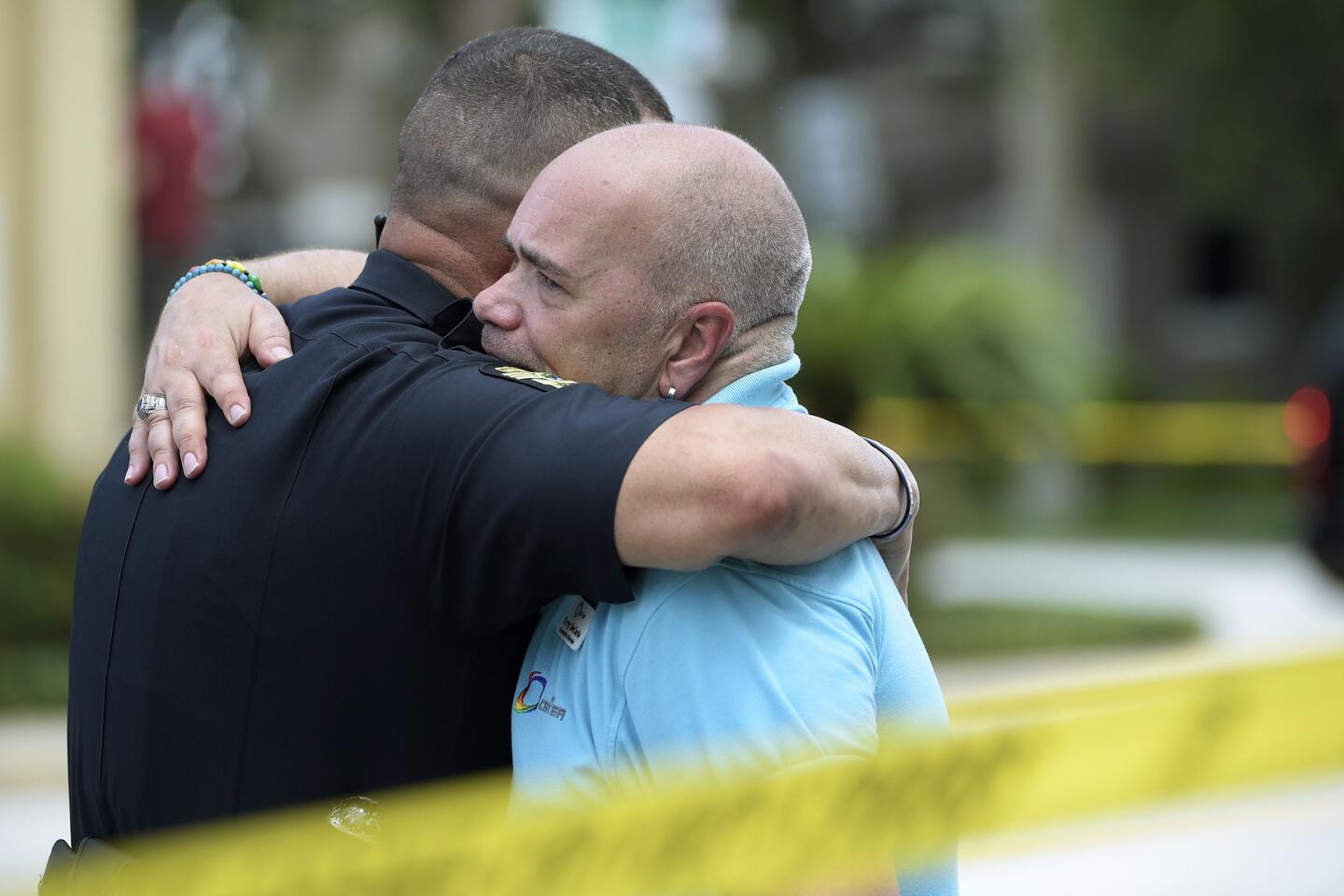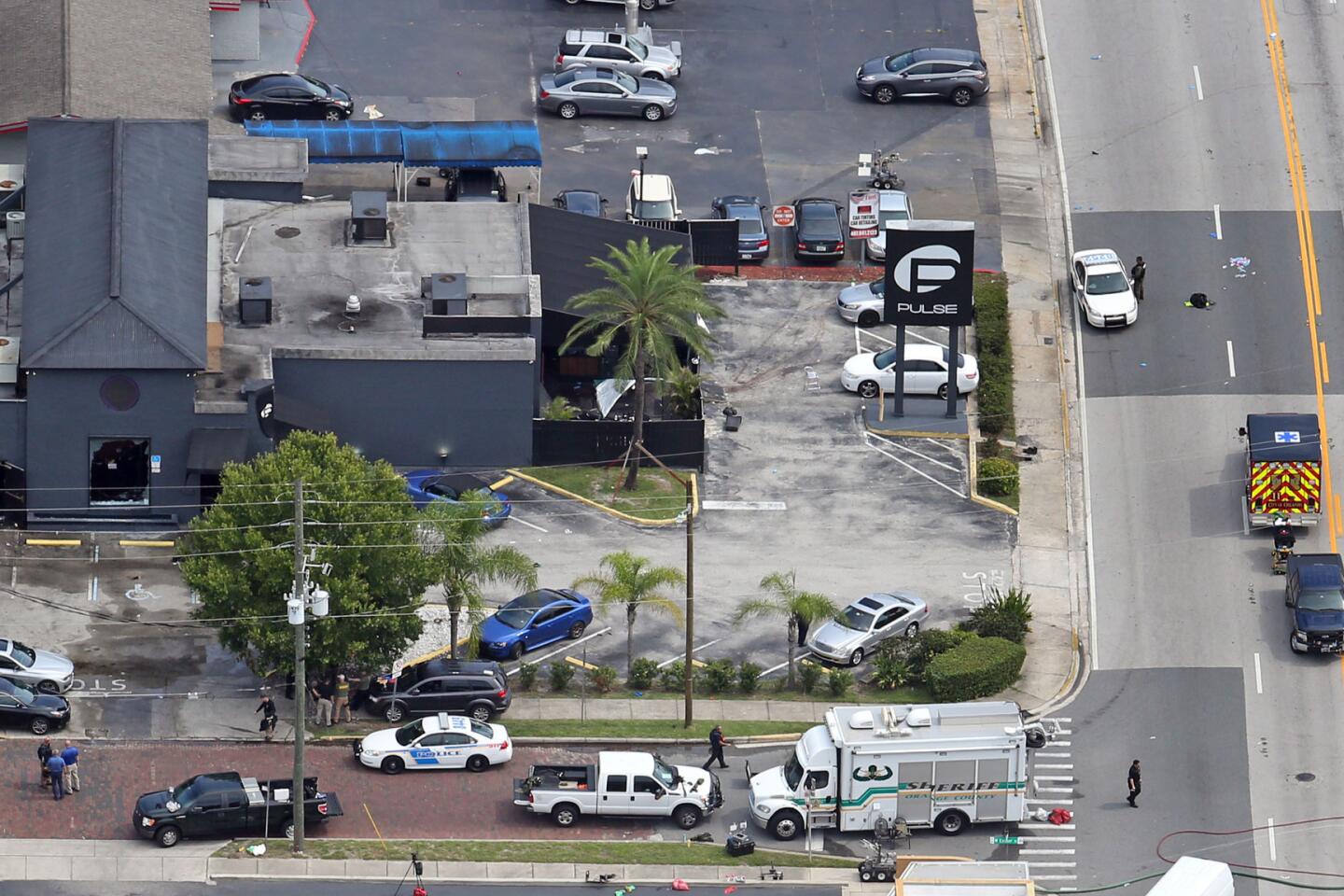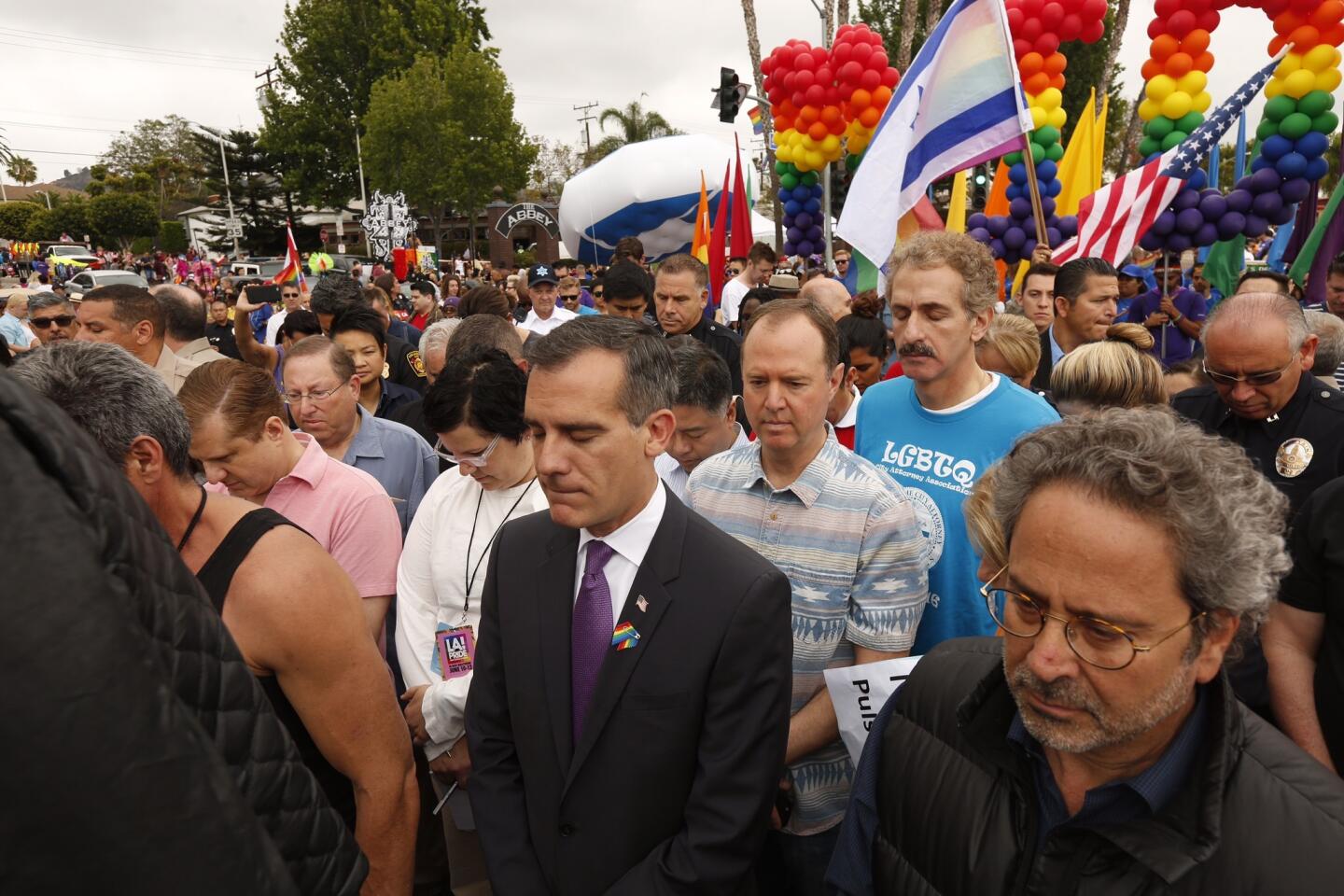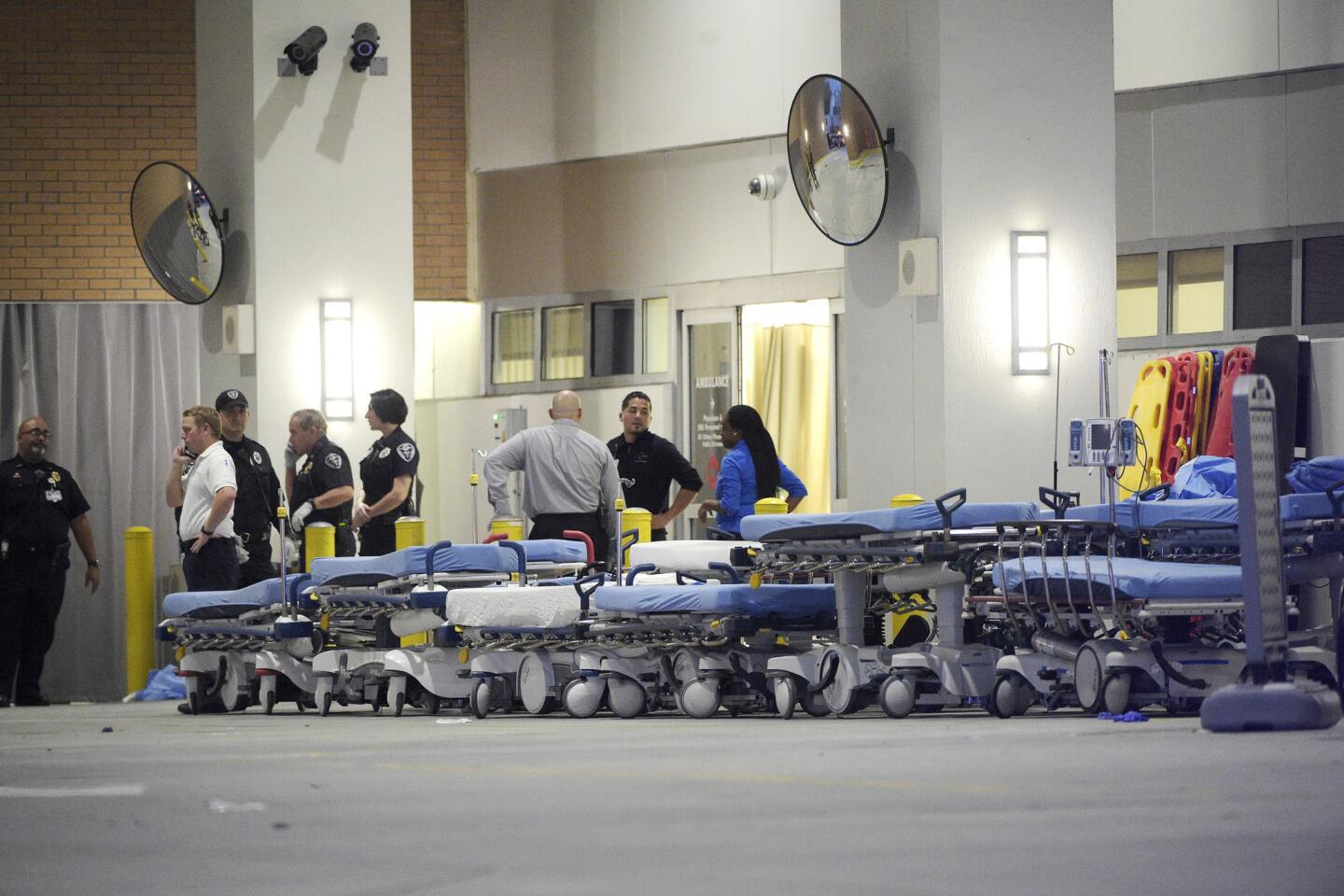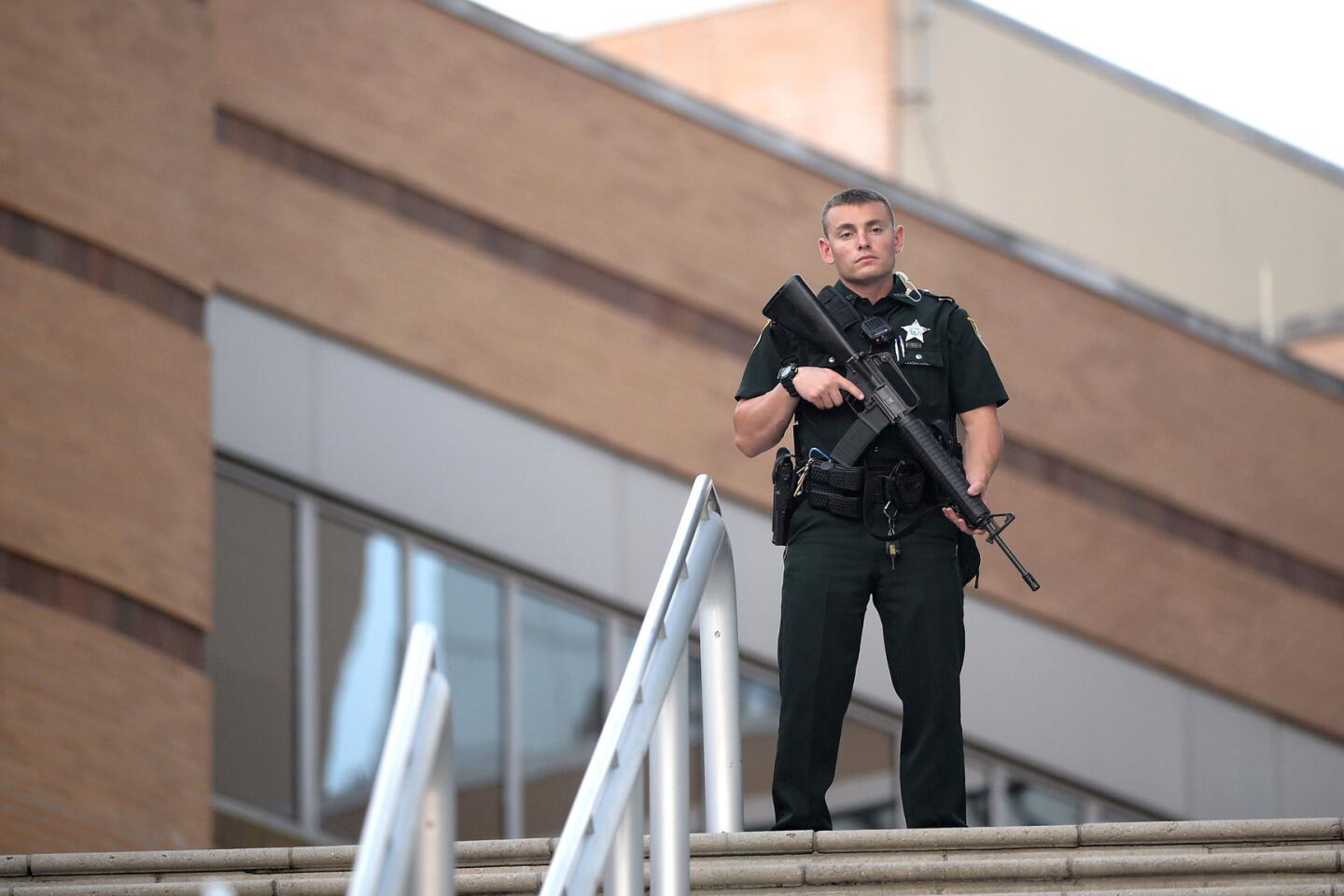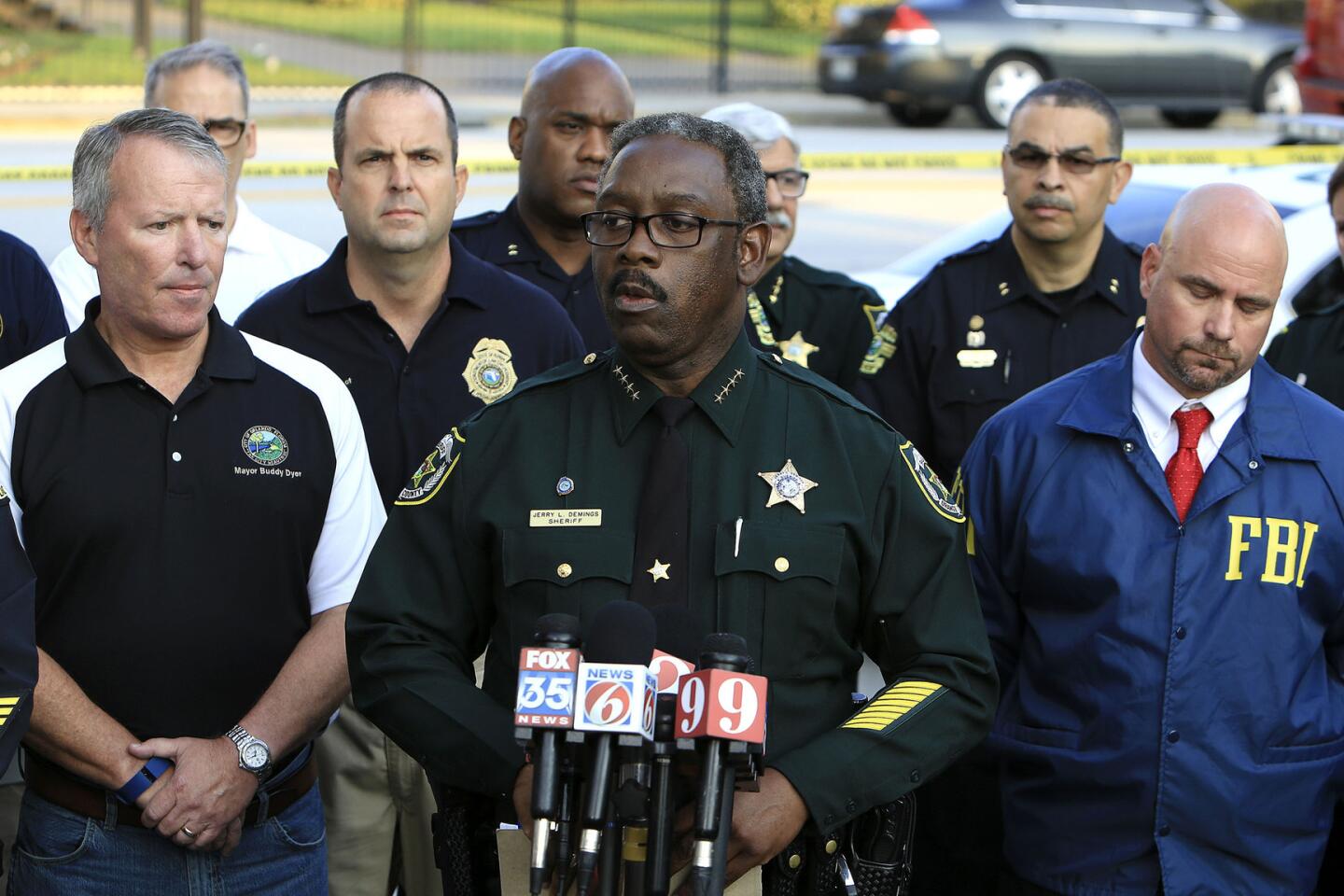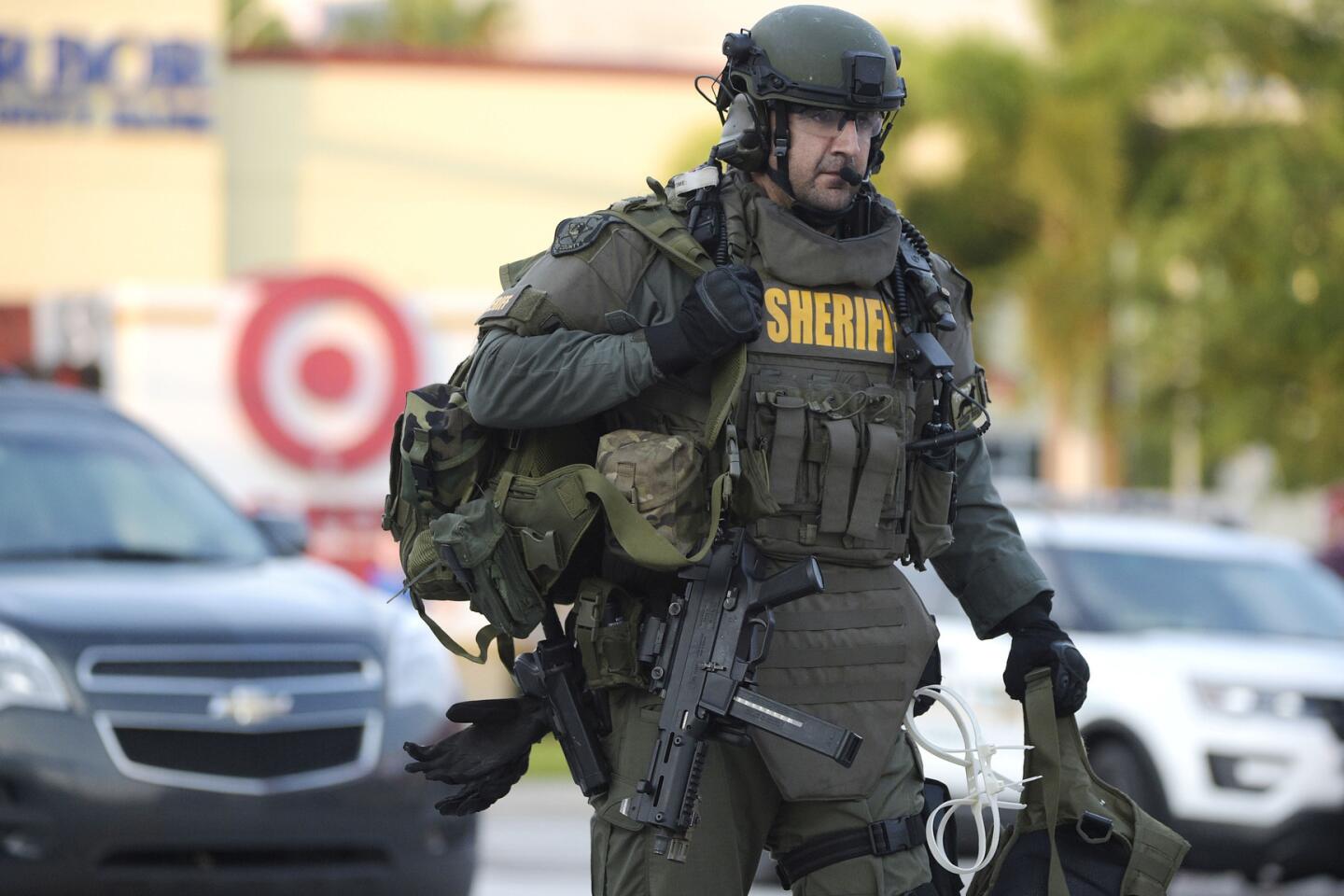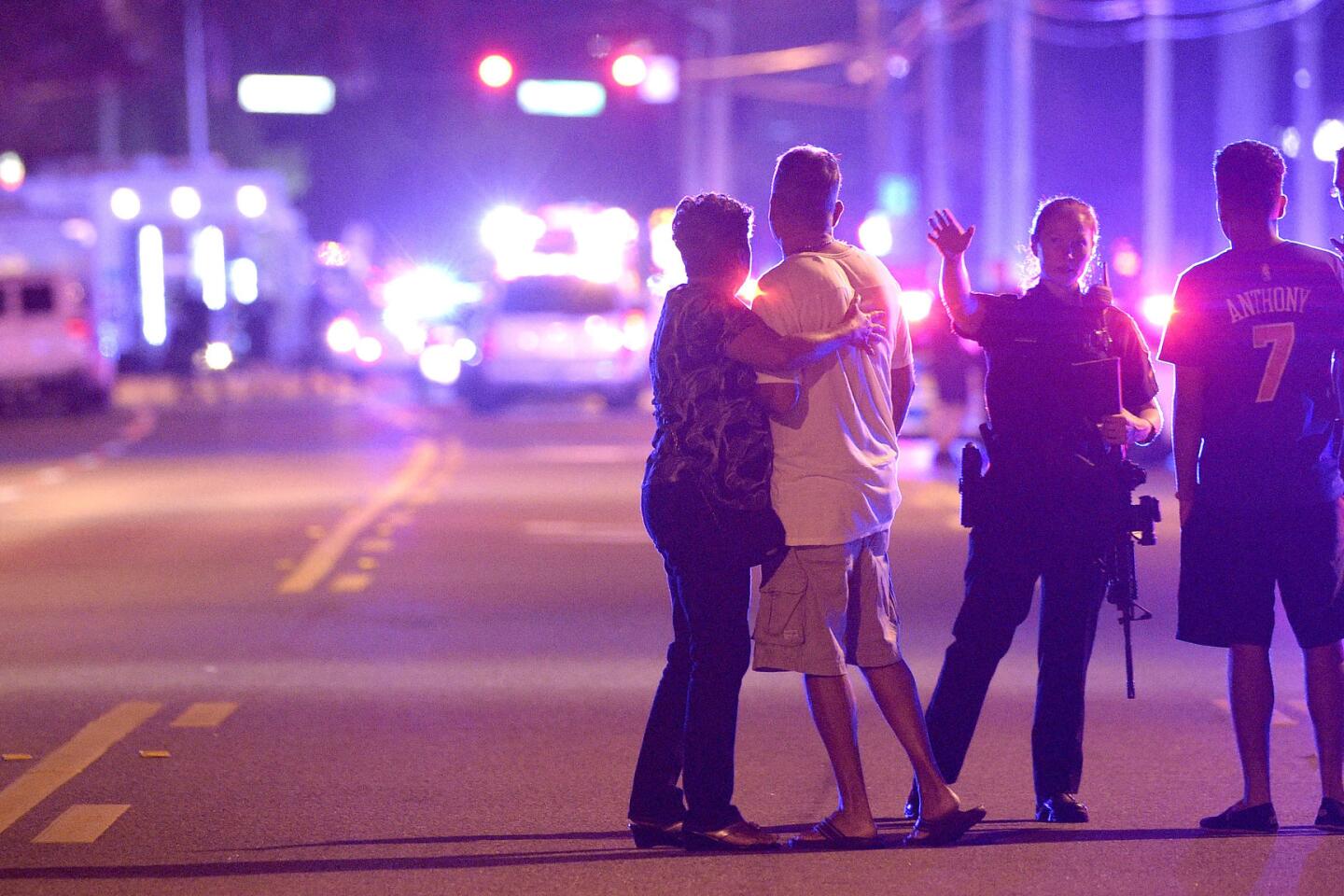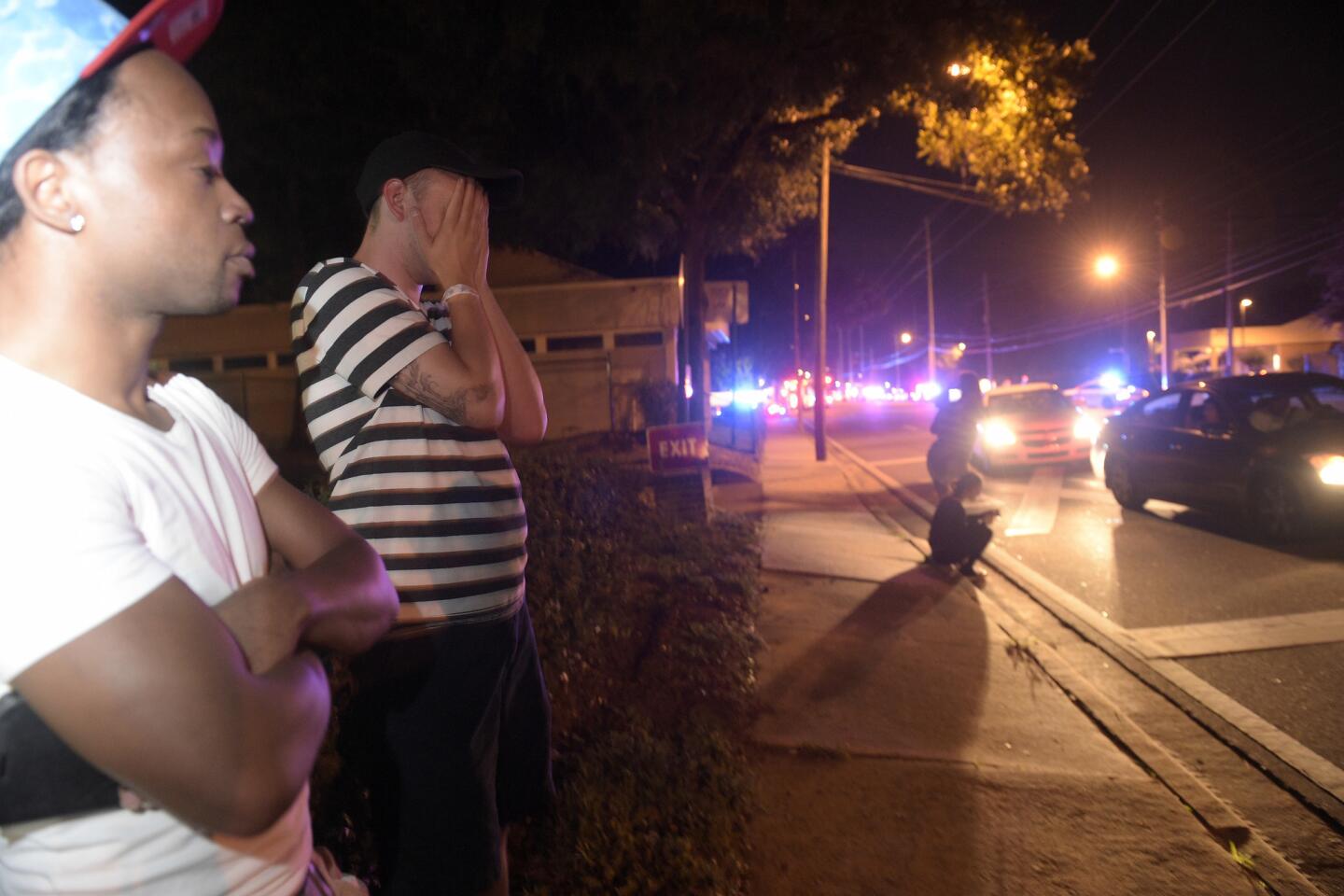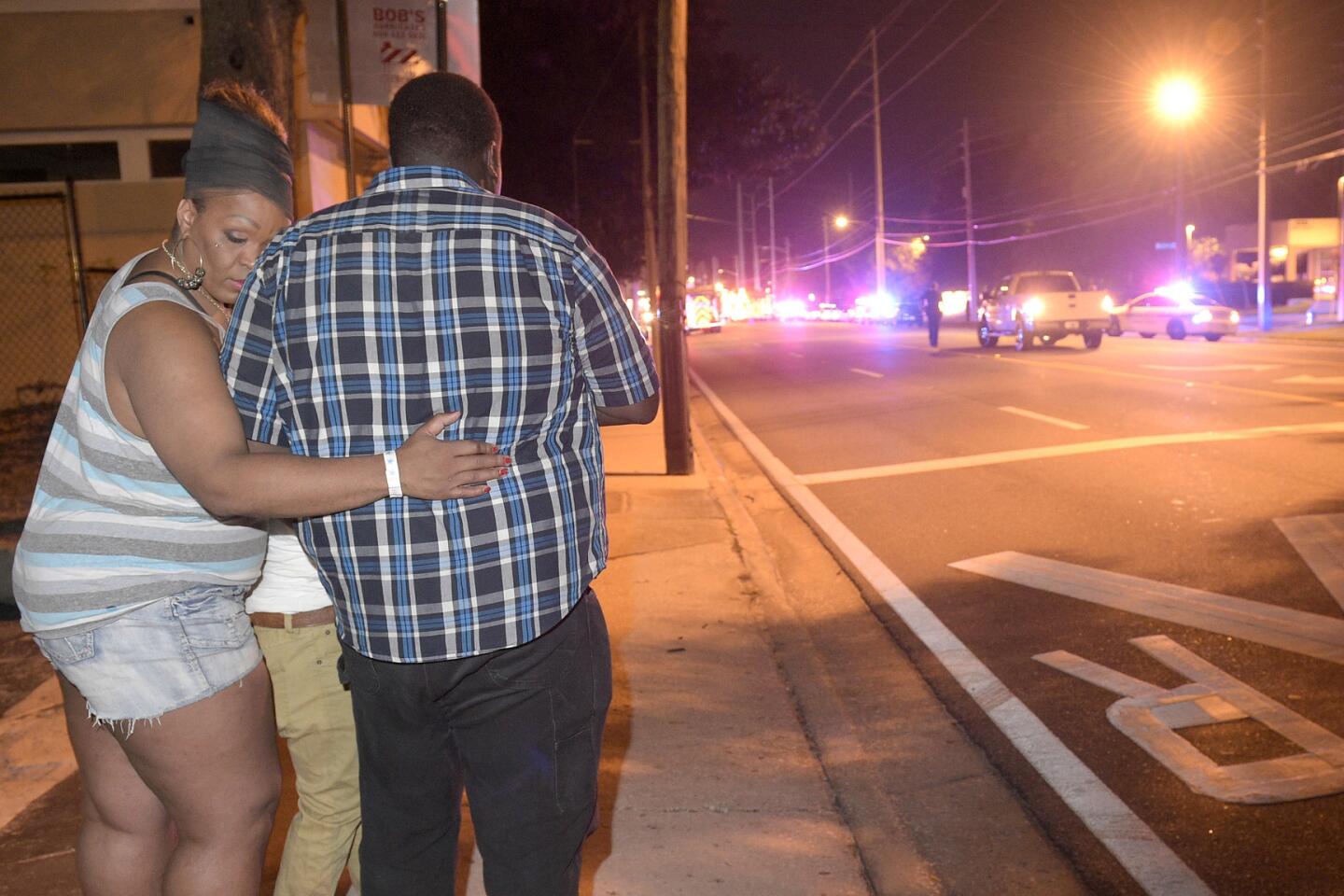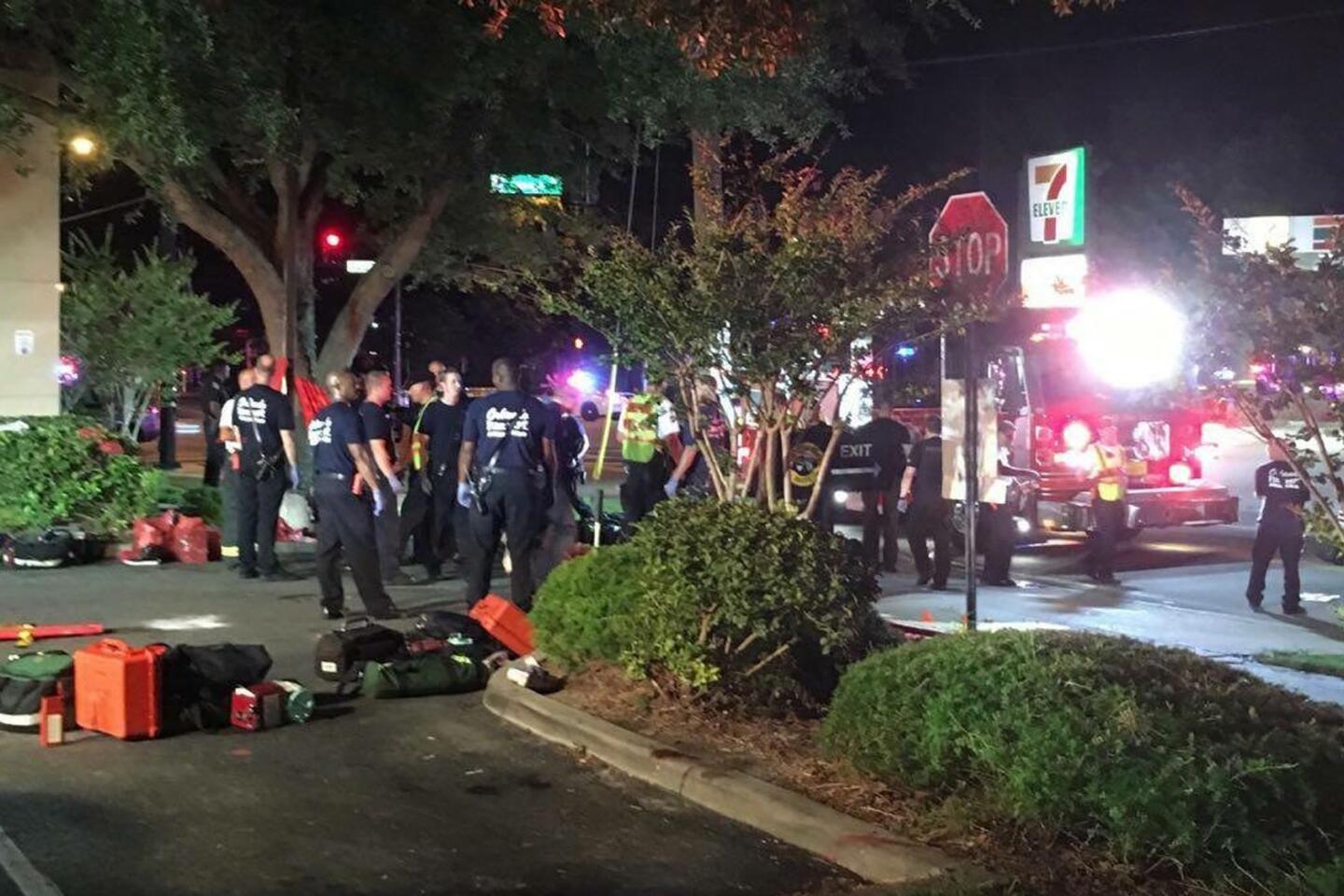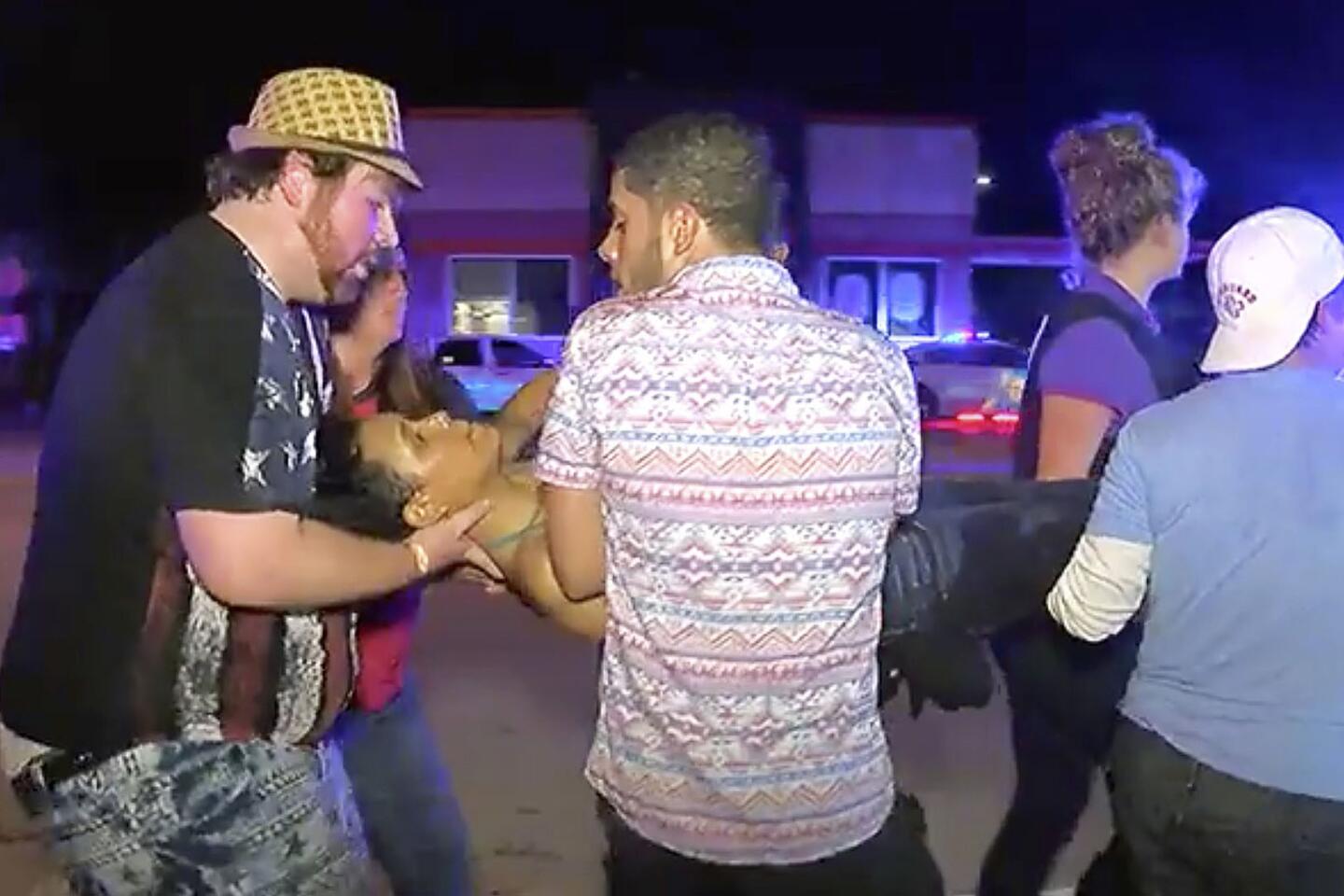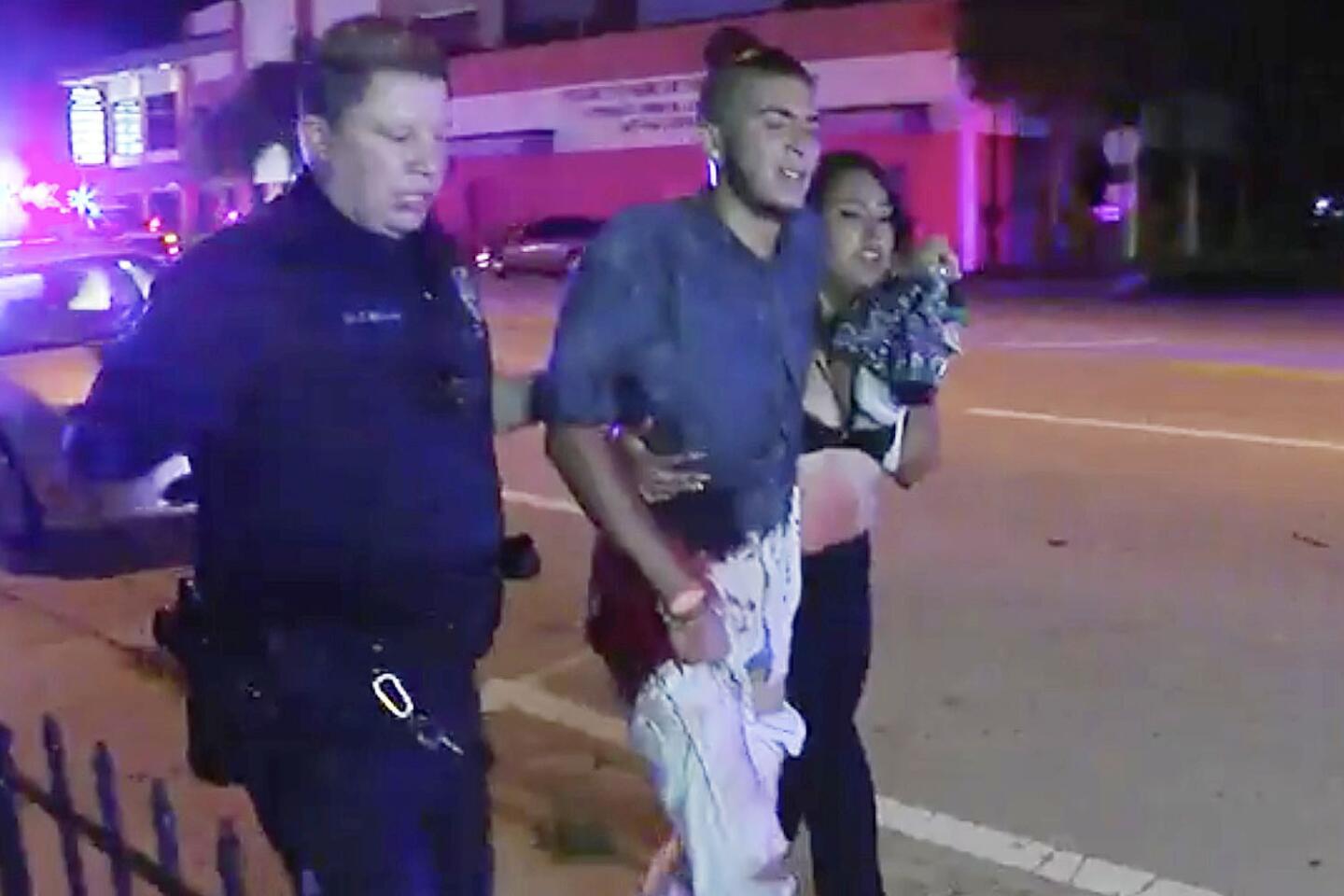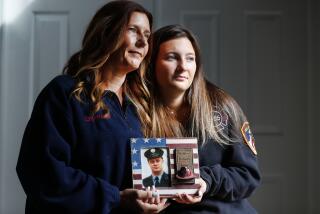Reporting from Orlando, Fla. — A long line of crosses became small windows into 49 lives lost.
Puerto Rican flags flapped from nearly half, representing the victims of the Pulse nightclub shooting a week ago Sunday who had ties to the island, a U.S. commonwealth.
Portraits taped to the front of each white cross showed the victims – mostly gay, Latino men in their 20s and 30s.
As people during the past few days walked the row of crosses, which were built and delivered to Orlando by a retired carpenter from Illinois, some read the victims’ names aloud. Others knelt at the foot of each cross in prayer.
Nearly everybody walked the full line of crosses, stretching for a city block. To stop before the end, many said, felt disrespectful, perhaps similar to not reading every name etched into stone at war memorials.
“This is a war that happened in our backyard,” said Gama Garcia, 26, a nursing student who does clinical rotations at Orlando Regional Medical Center, which tended to victims after the attack, the worst mass shooting in modern American history.
1/81
Inaya Bava, 5, on June 16, 2016, draws on crosses set up to remember the victims of the Pulse nightclub shooting at the Orlando Regional Medical Center.
(Carolyn Cole / Los Angeles Times) 2/81
Relatives of those killed and wounded in the Pulse nightclub attack arrive at Amway Center on June 16, 2016, for private meetings with President Obama.
(Carolyn Cole / Los Angeles Times) 3/81
President Barack Obama and Vice President Joe Biden bring flowers to the makeshift memorial at the Dr. Phillips Center for the Performing Arts.
(Joe Burbank / Orlando Sentinel) 4/81
Jiffy Lube employee Ralph Nieves puts up a sign of support for the Orlando community following the shooting at the Pulse nightclub.
(Spencer Platt / Getty Images) 5/81
Sarah Roemer, left, and Brandi Van Dongen, nurses at Arnold Palmer Childrens Hospital in Orlando, pray at one of the memorials.
(Carolyn Cole / Los Angeles Times) 6/81
The Parliament House is one of the largest nightclubs catering to the LGBT clients.
(Carolyn Cole / Los Angeles Times) 7/81
Rafael Rivera, left and Jeannette Gonzalez grieve at a wake for Eric Ortiz, one of the victims of the Pulse nightclub shooting.
(Carolyn Cole / Los Angeles Times) 8/81
Members of the media and public wait to catch a glimpse of President Obama at Amway Center.
(Carolyn Cole / Los Angeles Times) 9/81
A prayer service is held on June 15, 2016, for the victims of the Pulse Nightclub shooting at Delaney Street Baptist Church in Orlando, Fla.
(Drew Angerer / Getty Images) 10/81
Kelly Greenwood prepares a casket on June 16, 2016, at the Cardinal Casket Company in Orlando, Fla.
(John Taggart / EPA) 11/81
Candles are placed under American flags set in a circle outside a vigil at Christ Church Unity for the shooting victims.
(Charles King / Orlando Sentinel) 12/81
At the Dr. Phillips Center for the Performing Arts, Taylor Green, 25, left, and Brittany Spencer, 25, grieve for those killed in the Pulse nightclub attack.
(Carolyn Cole / Los Angeles Times) 13/81
ATF investigators continue to work the scene of the Pulse nightclub shooting along Orange Ave.
(Carolyn Cole / Los Angeles Times) 14/81
Friends and family attend the funeral of Angel Luis Candelario-Padro. It was the first funeral for the 49 victims of the Pulse nightclub shooting.
(Jacob Langston / Orlando Sentinel) 15/81
Doctors, nurses and first-responders at a prayer service in the emergency room at Florida Hospital in Orlando to honor the victims of the nightclub shooting.
(Joe Burbank / Orlando Sentinel) 16/81
FBI investigators continue to work at the Pulse nightclub on June 15.
(Carolyn Cole / Los Angeles Times) 17/81
Mourners embrace outside the visitation for Pulse nightclub shooting victim Javier Jorge-Reyes.
(David Goldman / Associated Press) 18/81
Mourners gather at the Dr. Phillips Center for the Performing Arts in Orlando for a vigil in honor of the nightclub attack victims.
(Carolyn Cole / Los Angeles Times) 19/81
Mourners gather at the Dr. Phillips Center for the Performing Arts in Orlando for a vigil in honor of the nightclub attack victims. (Carolyn Cole / Los Angeles Times)
20/81
Mourners gather at the Dr. Phillips Center for the Performing Arts in Orlando for a vigil in honor of the nightclub attack victims. (Carolyn Cole / Los Angeles Times)
21/81
Michelle Moment sing praise during a service at the First Baptist Church of Orlando during a special prayer service for the attack on Pulse nightclub.
(Carolyn Cole / Los Angeles Times) 22/81
“We were protected, we were saved it was just a miracle,” said Orlando Torres, 52. A promoter at Pulse, Torres was trapped in a bathroom stall with a friend. (Carolyn Cole / Los Angeles Times)
23/81
With stitches in his hand, gunshot victim Angel Colon tells his story to the media at a news conference at Orlando Regional Medical Center on Tuesday.
(Carolyn Cole / Los Angeles Times) 24/81
Patience Carter after describing the attack on the Pulse nightclub in Orlando. (Carolyn Cole / Los Angeles Times )
25/81
Gunshot victim Patience Carter, 20, left, is consoled by Dr. Neil Finkler at a news conference at Florida Hospital, joined by Dr. Brian Vickaryous, center, and fellow survivor Angel Santiago, 32, right, where they described the attack and its aftermath.
(Carolyn Cole / Los Angeles Times) 26/81
Angel Santiago on June 14, describes how events unfolded during the mass shooting at the Pulse nightclub in Orlando two days earlier.
(Carolyn Cole / Los Angeles Times) 27/81
Doctors and other staff at Orlando Regional Medical Center involved in the response to the nightclub shooting answer questions at a news conference on June 14, 2016.
(Carolyn Cole / Los Angeles Times) 28/81
Thousands gather for a memorial at the Plaza at the Dr. Phillips Performing Arts Center in downtown Orlando on June 13, 2016, to honor those killed and wounded in the Pulse nightclub attack.
(Carolyn Cole / Los Angeles Times) 29/81
Alison Cossio, center, holds a photo of her friend Christopher Sanfeliz, who one of the victims of the Orlando shooting, during a June 13, 2016, candlelight vigil and rally, hosted by the Los Angeles LGBT Center, at Los Angeles City Hall.
(Katie Falkenberg / Los Angeles Times) 30/81
Rabbi Neil Comess-Daniels plays guitar and sings during the Islamic Center of Southern California and ICUJP Interfaith Vigil Against Violence and Hatred Monday,night in remembrance of the 50 people killed in Orlando.
(Allen J. Schaben / Los Angeles Times) 31/81
Marwa Balkar holds a candle at the Islamic Center of Southern California and ICUJP Interfaith Vigil Against Violence and Hatred on June 13, 2016, in remembrance of the 49 people killed in Orlando, Fla.
(Allen J. Schaben / Los Angeles Times) 32/81
Los Angeles City Hall is lit up in colors of the rainbow during a candlelight vigil and rally, hosted by the Los Angeles LGBT Center.
(Katie Falkenberg / Los Angeles Times) 33/81
Scott Phillips and Em Enagan mourn for the 49 lives lost in the Orlando shooting during a vigil at Los Angeles City Hall.
(Callaghan O’Hare / Los Angeles Times) 34/81
A song is sung during a candlelight vigil and rally, hosted by the Los Angeles LGBT Center, at Los Angeles City Hall, for the victims of Sunday’s shooting massacre at a gay nightclub in Orlando.
(Katie Falkenberg / Los Angeles Times) 35/81
Thousands gather for a memorial rally at the Plaza at the Dr. Phillips Performing Arts Center in downtown Orlando on Monday to honor those killed and wounded in the Pulse nightclub attack.
(Carolyn Cole / Los Angeles Times) 36/81
Madeline Lago, 15, and her mother Carmen Lago were among the thousands who gathered for a memorial at the Plaza at the Dr. Phillips Performing Arts Center in downtown Orlando on Monday to honor those killed and wounded in the Pulse nightclub attack. They bowed their heads as the bell was tolled.
(Carolyn Cole / Los Angeles Times) 37/81
Thousands gather for a memorial at the Plaza at the Dr. Phillips Performing Arts Center in downtown Orlando on Monday to honor those killed and wounded in the Pulse nightclub attack.
(Carolyn Cole / Los Angeles Times) 38/81
Friends and relatives bring flowers and remembrances to the plaza at the Dr. Phillips Performing Arts Center in downtown Orlando on Monday.
(Carolyn Cole / Los Angeles Times) 39/81
Danielle Irigoyen brings flowers to the victims of the Pulse nightclub shooting. “I’m very close to many of the people who go to Pulse. Pulse was a safe place for us all,” she sail.
(Carolyn Cole / Los Angeles Times) 40/81
Investigators gather at the Pulse nightclub on Monday morning.
(Carolyn Cole / Los Angeles Times) 41/81
Investigators set up at the Pulse nightclub.
(Carolyn Cole / Los Angeles Times) 42/81
Family gather for victims at Beardall Senior Center in Orlandoon Monday.
(Carolyn Cole / Los Angeles Times) 43/81
Friends of Shane Tomlinson, who was killed in the Pulse nightclub shooting, gather in prayer and remembrances in downtown Orlando on Monday. (Carolyn Cole / Los Angeles Times)
44/81
Friends of Shane Tomlinson, including Richie Compton, left, and Erik Winger, right, gather in prayer and remembrances in downtown Orlando on Monday. Shane Tomlinson was killed killed in the Pulse nightclub shooting.
(Carolyn Cole / Los Angeles Times) 45/81
Family and friends arrive at the Senior Center in Orlando as they await news on their loved ones on Monday. (Carolyn Cole/Los Angeles Times)
(Carolyn Cole / Los Angeles Times) 46/81
Volunteers gather in prayer on Monday at the Senior Center in Orlando where they are there to help grieving family and friends of those killed and injured in the shooting at Pulse nightclub.
(Carolyn Cole / Los Angeles Times) 47/81
FBI investigators in Orlando, Fla., look at the floor plans of Pulse nightclub as they gather on Monday morning to continue the investigation.
(Carolyn Cole / Los Angeles Times) 48/81
People gather at Taylor Square in Sydney, Australia, to show solidarity with victims of the Orlando nightclub shooting.
(Dan Himbrechts / EPA) 49/81
City Hall in Tel Aviv, Israel, is lit up in solidarity with Orlando’s shooting victims.
(Oded Balilty / Associated Press) 50/81
New Zealand residents gather at Frank Kitts Park in Wellingtond to mourn victims of the Pulse nightclub shooting in Orlando, Fla.
(Hagen Hopkins / Getty Images) 51/81
A man lights a candle in Paris on June 12 to remember those slain and wounded in the Orlando nightclub shooting. (Rapahel Satter / Associated Press)
52/81
New Zealand residents gather in Frank Kitts Park to mourn victims of the Orlando nightclub shooting.
(Hagen Hopkins / Getty Images) 53/81
Residents gather at Joy Metropolitan Community Church near the Pulse nightclub in Orlando to mourn the mass shooting victims of the early morning attack on June 12, 2016.
(Carolyn Cole / Los Angeles Times) 54/81
Johnpaul Vazquez, right, and his boyfriend Yazan Sale sit by Lake Eola, in downtown Orlando, thinking of those killed and injured.
(Carolyn Cole / Los Angeles Times) 55/81
Judy Rettig, center, and Dave Hack, left, hug after a prayer service held at the Joy Meropolitan Community Church in Orlando.
(Carolyn Cole / Los Angeles Times) 56/81
Zafar Basith prays at a vigil for the Orlando shooting victims at the Baitul Hameed Mosque in Chino.
(Francine Orr / Los Angeles Times) 57/81
Raymond Braun, right, right, gets a hug after a vigil held in West Hollywood for the victims of the shooting at the nightclub in Orlando.
(Katie Falkenberg / Los Angeles Times) 58/81
Monte Dobbs and Jhoanna Galvez of Long Beach, comfort each other during a vigil service at the corner of La Cienega Blvd. and Santa Monica Blvd.
(Harrison Hill / Los Angeles Times) 59/81
Orlando, second from right, was at the nightclub and trapped for three hours in a bathroom. Orlando and family attend a vigil and church service held at Joy Meropolitan Community Church very close to Pulse nightclub.
(Carolyn Cole / Los Angeles Times) 60/81
People hug in solaceafter a vigil and church service held at Joy Meropolitan Community Church very close to Pulse nightclub.
(Carolyn Cole / Los Angeles Times) 61/81
Susan Stephens, right, gets a hug from Karen Castelloes before a vigil and prayer service is held at Joy Meropolitan Community Church very close to Pulse nightclub.
(Carolyn Cole / Los Angeles Times) 62/81
Investigators view the site of the early morning mass shooting on June 12, 2016, at Pulse nightclub in Orlando.
(Carolyn Cole / Los Angeles Times) 63/81
People hold signs in support of the Orlando shooting victims on Sunday.
(Jacob Langston / Orlando Sentinel) 64/81
Kelvin Cobaris, a local clergyman, consoles Orlando city commissioner Patty Sheehan (right) and Terry DeCarlo, an Orlando gay-rights advocate, as they arrive on the scene near where at least 50 people were reportedly shot and killed in Orlando, Fla., Sunday, June 12, 2016.
(Joe Burbank / Orlando Sentinel) 65/81
Aerial view of the shooting scene at Pulse nightclub in Orlando, Fla.
(Red Huber / Orlando Sentinel) 66/81
A bomb disposal unit checks for explosives around the apartment building where shooting suspect Omar Mateen is believed to have lived on June 12, 2016 in Fort Pierce, Florida.
(Joe Raedle / Getty Images) 67/81
Ray Rivera, a DJ at Pulse nightclub, is consoled by a friend outside of the Orlando Police Department after 50 people were killed at the club on Sunday.
(Joe Burbank / Orlando Sentinel) 68/81
Orlando police officers outside of Pulse nightclub after a fatal shooting and hostage situation on Sunday.
(Gerardo Mora / Getty Images) 69/81
Terry DeCarlo, executive director of the LGBT Center of Central Florida, right, is comforted by an Orlando Police officer after a shooting involving multiple fatalities at a nightclub in Orlando, Fla. on Sunday.
(Phelan M. Ebenhack / Associated Press) 70/81
An aerial view of the shooting scene at Pulse nightclub in Orlando, Fla. (Red Huber / Orlando Sentinel)
71/81
Los Angeles Mayor Eric Garcetti, center, and others have a moment of silence on June 12, 2016, in West Hollywood for the victims of the shooting in Orlando, Fla., that happened early that morning.
(Genaro Molina / Los Angeles Times) 72/81
Emergency personnel at Orlando Regional Medical Center wait with stretchers for the arrival of victims from the fatal nightclub shooting.
(Phelan M. Ebenhack / Associated Press) 73/81
A police officer stands guard outside the Orlando Regional Medical Center after a fatal shooting at nearby Pulse nightclub in Orlando, Fla., on Sunday.
(Phelan M. Ebenhack / Associated Press) 74/81
Law enforcement agencies and local city representatives speak at a news conference after 50 people were killed at the Pulse nightclub in Orlando, Fla.
(Jacob Langston / Orlando Sentinel) 75/81
An Orange County (Fla.) Sheriff’s Department SWAT member arrives at Pulse nightclub.
(Phelan M. Ebenhack / Associated Press) 76/81
Orlando police direct family members away from the Pulse nightclub, where 50 people were killed.
(Phelan M. Ebenhack / Associated Press) 77/81
Jermaine Towns, left, and Brandon Shuford wait down the street from the Pulse nightclub in Orlando, Fla. (Phelan M. Ebenhack / Associated Press)
78/81
Bystanders wait down the street after a mass shooting at the Pulse nightclub in Orlando, Fla.
(Phelan M. Ebenhack / Associated Press) 79/81
The scene outside Pulse nightclub in Orlando, Fla., after the shooting early Sunday.
(Univision Florida Central / EPA) 80/81
An injured person is escorted out of the Pulse nightclub after a shooting rampage Sunday morning in Orlando, Fla.
(Steven Fernandez / Associated Press) 81/81
An injured man is escorted out of the Pulse nightclub after a shooting rampage Sunday morning in Orlando, Fla. A gunman with an assault-type rifle and a handgun opened fire inside a gay nightclub, killing at least 50 people before dying in a gunfight with SWAT officers, police said.
(Steven Fernandez / Associated Press) Katrina Manalastas, 30, spent about half a minute at each cross, snapping photos on her phone. She took a break about halfway through the sprawling memorial, overwhelmed, and spent a little extra time at the cross honoring her friend Christopher Andrew Leinonen, 32, whose funeral she had just attended.
At the end, she scrolled through 13 rows of pictures – 49 lives memorialized in half-inch-by-half-inch photos on her phone. Manalastas said she wanted to remember each victim’s face, not just the number 49.
Nearby, Alberto Capo crumpled to his knees in tears.
“No, no, no,” he repeated, staring at a picture of his nephew Luis Omar Ocasio Capo, 20, who died in the massacre.
His nephew’s dream was to become as famous as he possibly could, Alberto Capo said, and, yet, he had an extremely humble heart. He befriended a homeless man who lived near him, often delivering food and once giving him the hoodie off his back.
“To me,” Capo said, “he was perfect.”
As he stood up, drying his eyes on a T-shirt bearing his nephew’s name, a tall woman with blond hair walked by. She did a double take, noticing that the name on Capo’s shirt matched the one on the cross.
“Oh, God,” she whispered.
She wrote “Love!” in cursive on the cross, dropped a sunflower and told Capo she was so sorry. He nodded.
Capo lives in Cleveland and planned to drive home Friday night, but wanted to spend his final hours in Orlando at the cross. Before he left, he whispered goodbye to his nephew: “Bye, Papi.”
The memorial, at times, became a classroom for learning how to respond to tragedy. As a little boy walked toward the last cross, he stopped counting and looked confused.
“49?” he asked. “I thought 50.”
His older brother shook his head, explaining that putting the death toll at 50 would include “the bad guy,” adding that “the bad guy doesn’t count.”
Their mother rested one hand on each of her boys’ shoulders and scrunched her eyebrows together.
“He was very, very bad,” she told them, referring to gunman Omar Mateen, “but he counts.”
The horizontal slat of each cross bore the victims’ names in big, capital letters, but loved ones added nicknames. There was “Wonder Woman,” “nugget” and “El bebe” – the baby. To some, Luis Omar Ocasio Capo was simply “Ommy.”
Messages from strangers and friends covered the crosses:
“Disaster family loves you.”
“I will miss you, your smile, jokes and little dance moves. I love you so much nugget. Love, ladybug.”
“I promise to be here for your family. Rest easy.”
On the back of each cross, there was a note in matching handwriting: “Greg Zanis Loves You.”
Zanis, 65, started building and delivering crosses to scenes of mass shootings years ago to cope with his own suffering. In the winter of 1996, he found his father-in-law lying in a pool of blood, he said, and the killing wrecked his life. He lost 50 pounds and struggled to find meaning in things.
A few months later, a 6-year-old was killed in Illinois and her mother asked Zanis if he would build a cross for $25. He refused the money, he said, but built her the cross.
Before long, crosses started popping up across Illinois and then the country. Zanis said he’s made nearly 15,000 crosses and can hardly keep track of all the crime scenes he’s visited.
After the 2005 school shooting on the Red Lake Indian Reservation in northern Minnesota, he built crosses using scraps from a collapsed barn; he used parts of a deck for the crosses he took to Tucson after the 2011 shooting that killed six people and wounded 13, including then-Rep. Gabrielle Giffords; the next year, after the massacre at an elementary school in Newtown, Conn., he relied on pieces of an old fence.
In 1999, Zanis showed up to the scene of the Columbine High School shooting with 15 crosses, including two for the killers. The decision, which Zanis said was meant to empathize with the killers’ parents, who he imagined must be suffering immensely, sparked outrage, especially among some of the victims’ families.
Out of respect, he stopped making crosses for killers, he said, but sometimes still leaves behind a small wooden heart for their families.
After he heard about the Orlando shooting, which happened at a gay nightclub, Zanis, a Christian, said he started to get calls from longtime friends curious if he planned to build crosses this time. Of course, he told them. Some spoke negatively of homosexuality, which Zanis said infuriated him.
“That was all the more reason for me to go to Orlando,” he said.
After he set up the crosses, he met with Florida Gov. Rick Scott and dozens of victims’ families. Before driving home Friday, Zanis collected as many cell phone numbers as possible.
He plans to call the victims’ families before officials decide to remove the memorial.
The crosses, he’ll tell the families, are yours.
ALSO
From San Ysidro to Sandy Hook: Surviving, but never getting over it
Nearly a week later, a shooting survivor’s mind races with memories of her ‘hero’ cousin
Did gunman have bombs or an accomplice? Captain says questions made SWAT team use caution
